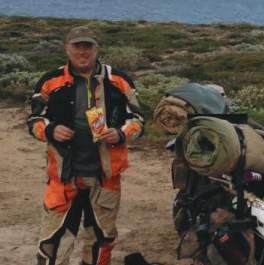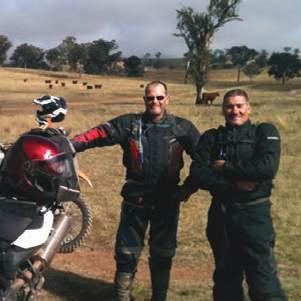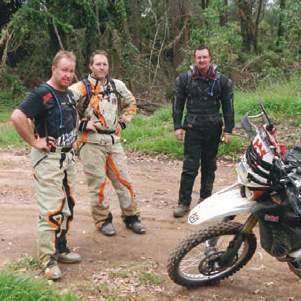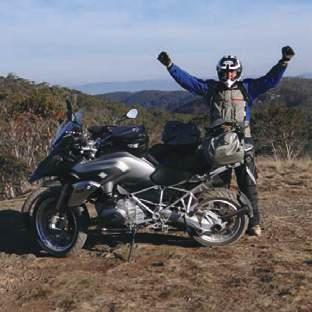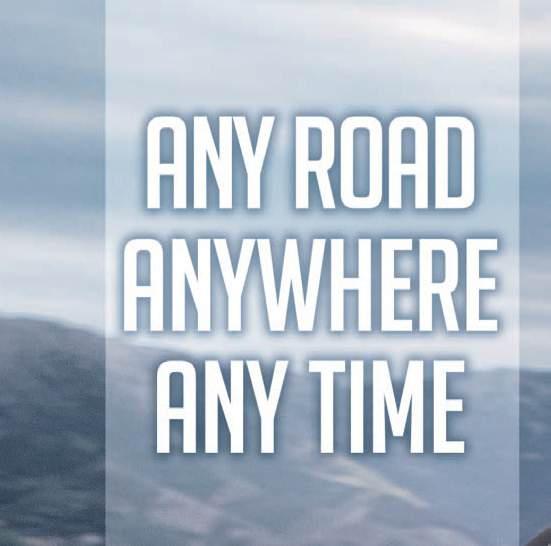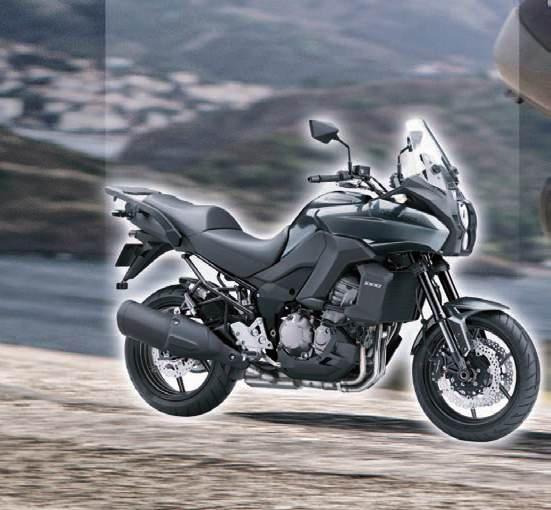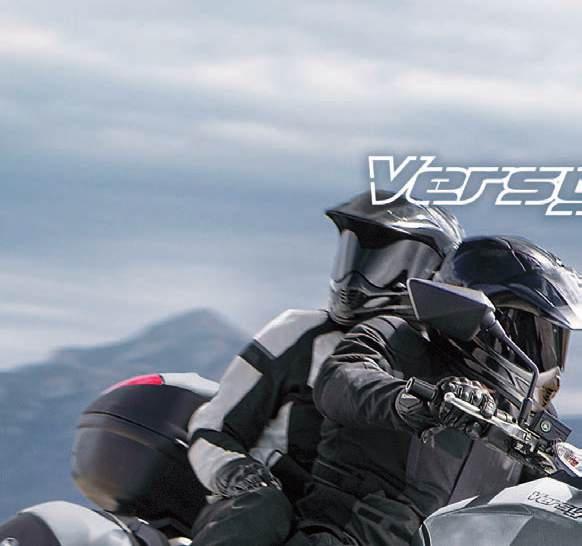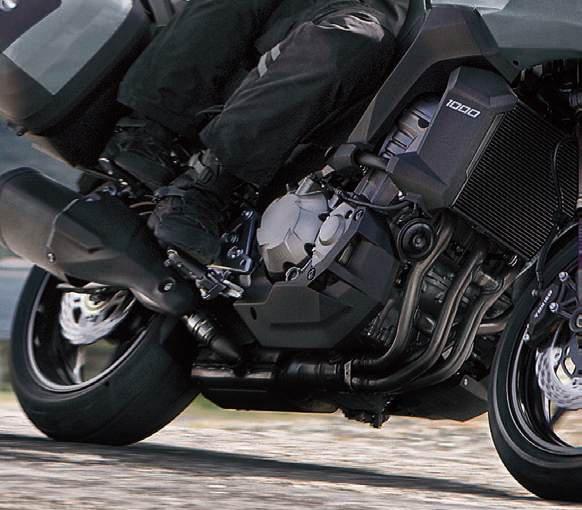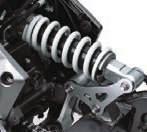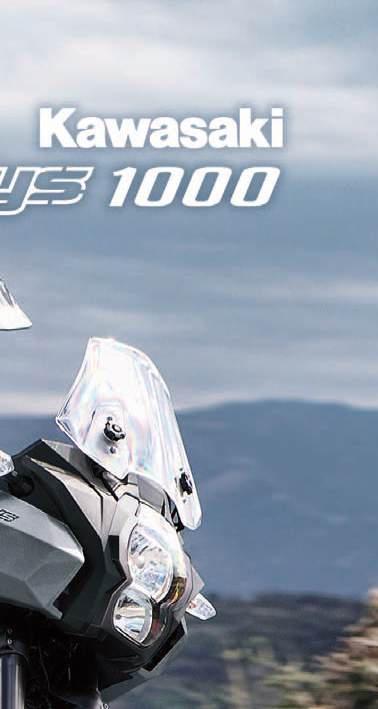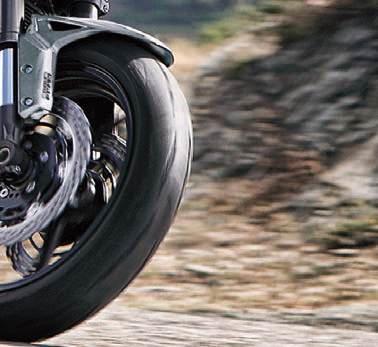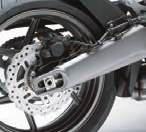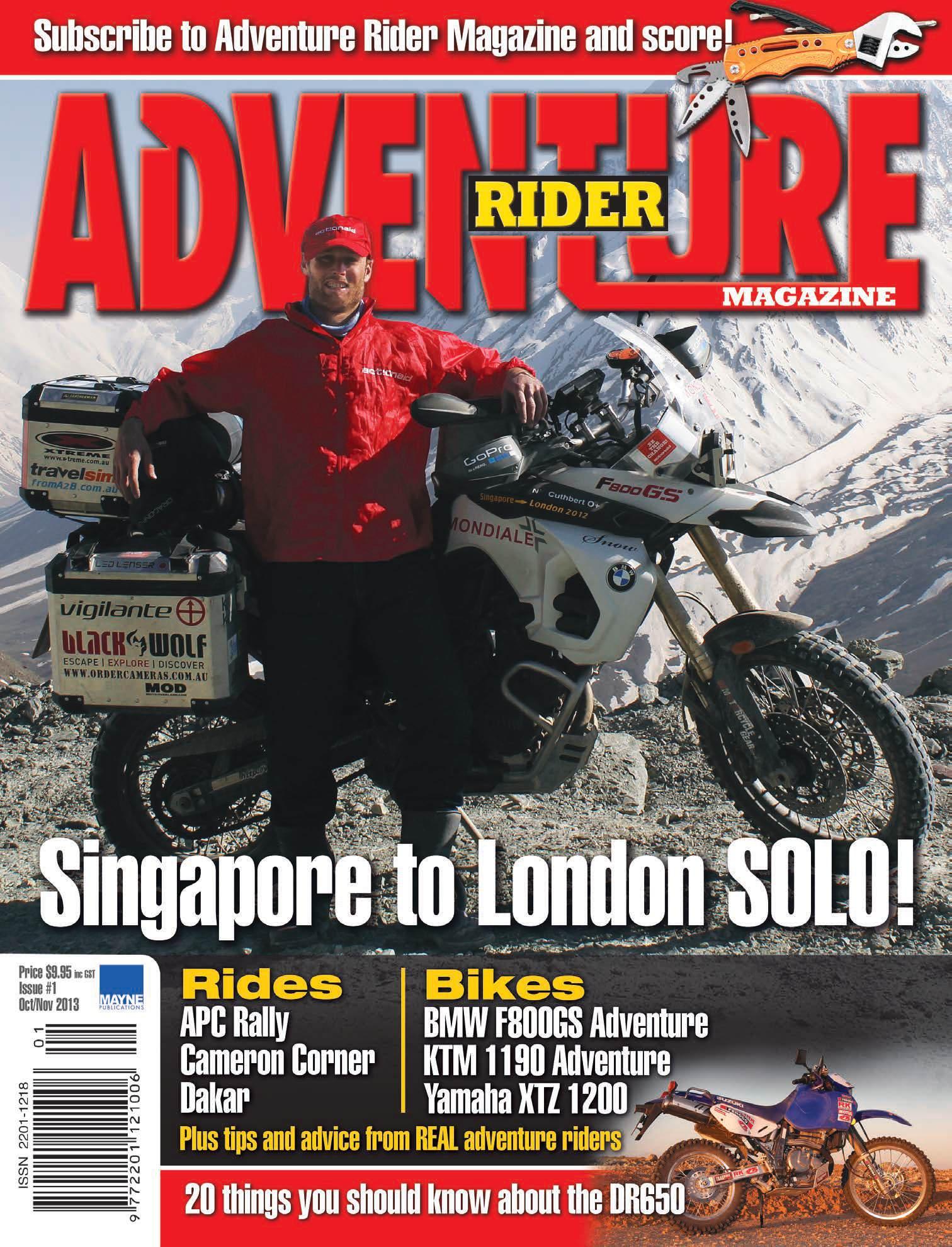
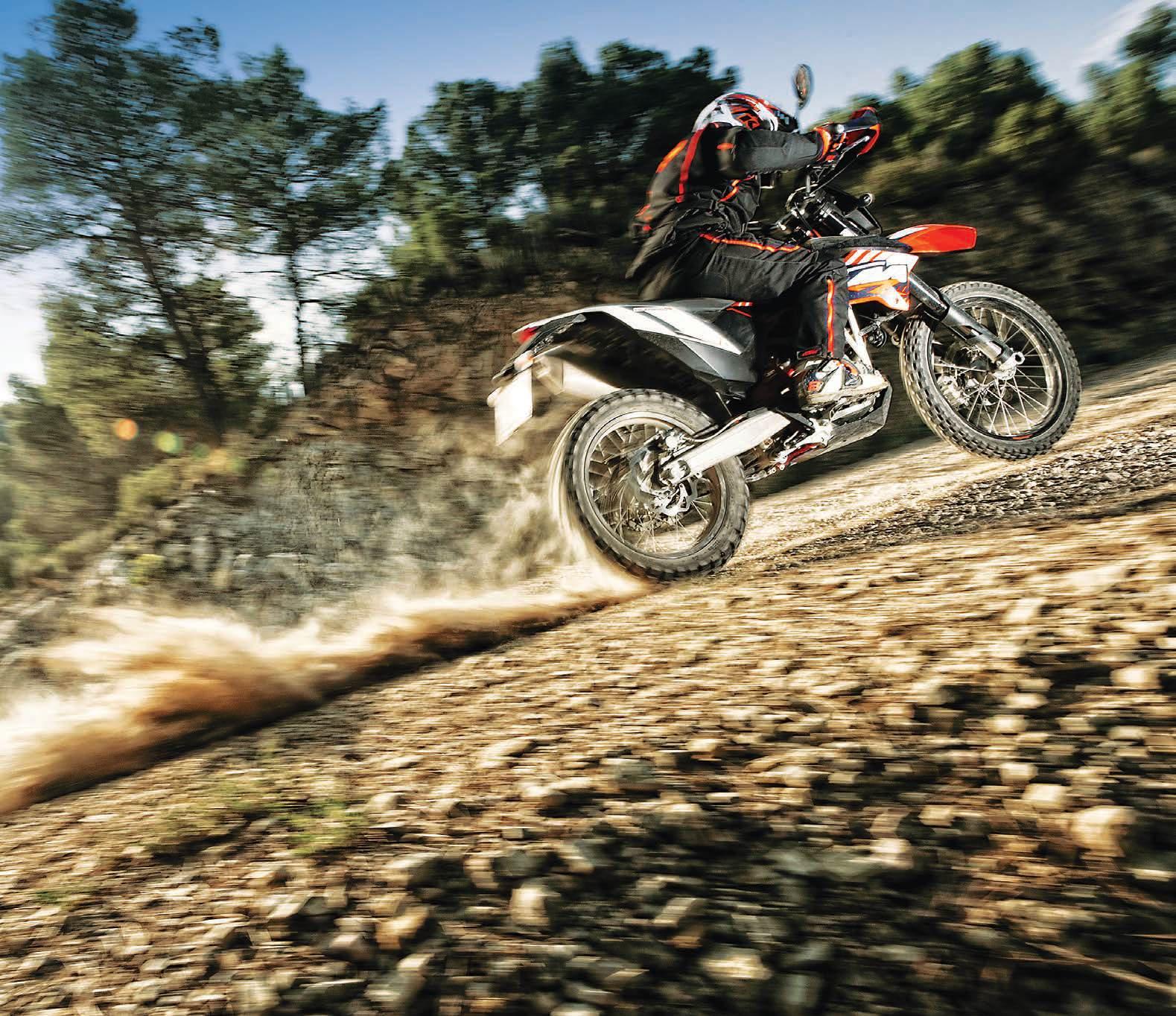



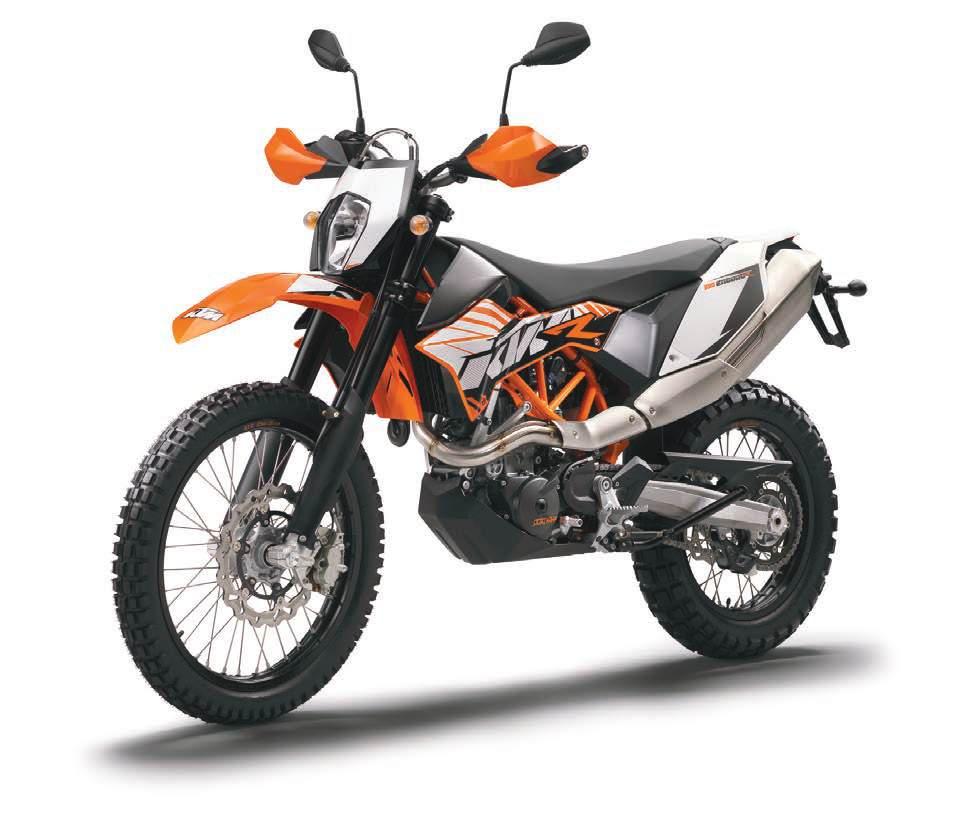
Go with no compromises! No matter whether on asphalt or tough terrain: This bike is the ultimate all-rounder with an edge. Light, agile and with abundant power from the bottom up, thanks to a LC4 single cylinder engine with a full 690 cc. From hard enduro to drifting on dirt: This KTM 690 Enduro R masters every discipline, assuredly and with the greatest of ease. It’s time to GO and get ready...



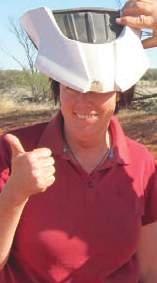
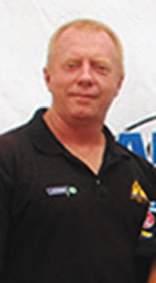
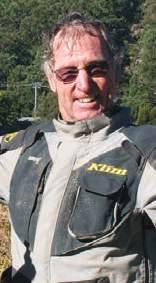
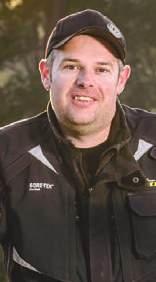
John Hudson
John thought adventure riders would love an event offering some of the thrill and challenge of The Dakar at a miniscule price, so in 2010 the real estate manager kicked off the APC Rally.
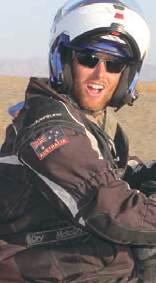
Karen’s in that growing group of females either returning to riding or taking it up. She’s worked in the Northern Territory as a governess/jillaroo, supervising kids and mustering on ’bikes, and bought her first bike from an undertaker.
Terry kicked off the Shock Treatment suspension tuning service back in 1996 after he found it difficult to get advice on setting up his own bike. Being a tad tall, Terry could see the need for a good suspension service that would take a rider’s personal needs into account.
Ken’s children and grandchildren keep trying to tell him he’s old and should slow down. His response is, “That’s rubbish. Just because I’m 70 doesn’t mean I can’t ride with the young blokes.” There’s never been a time where there wasn’t a dirtbike in the shed and he now uses the riding as a motivator to simply keep fit.
Dan’s done a few hundred-thousand kilometres on various dirt and adventure bikes, but is quick to describe himself as capable rather than great. Rarely venturing far without his trusty Nikon, Dan is keen to capture the unique world of adventure riding.
Nic has swum oceans and conquered deserts in pursuit of his dreams. In 2012 he grabbed a BMW F 800 GS and rode it from Singapore to London. It’s just another achievement in a long line of great feats for Nic.
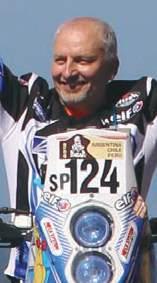
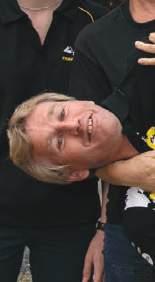
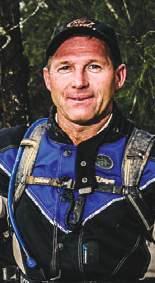
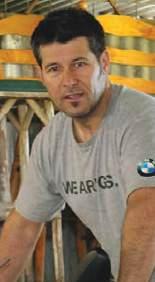
Craig has been riding motorcycles since he was five. He’s raced in Australia, South Africa, South America and Europe. In recent years he became obsessed with motorcycle rally racing, competing in several World Championship events.
A lifelong rider, Robin now rides, “whenever there’s a chance” on any bike available, on- or off-road. Between churning out Safari Tanks and importing high-quality Touratech gear, there’s not as much riding going on for this Victorian-based bloke as he’d like.
At any given opportunity, Poolie’s out in the bush screaming around on a motorbike. He loves adventure riding, and has completed all of the APC rallies. If it’s not an adventure ride, Poolie’s riding trails or motocross tracks around SEQ and northern NSW.
Miles has been National Motorrad Marketing Manager for BMW Motorrad since 2006. He’s a very highly qualified motorcycling coach and an ex-professional mountain-bike racer. Miles is still riding every chance he gets, and has built an enviable reputation as both a world-class rider and great riding companion.

Adventure Rider Magazine is published bi-monthly by Mayne Publications Pty Ltd
Publisher
Kurt M Quambusch
Editor/Advertising Sales
Tom Foster tom@advridermag.com.au (02) 8355 6842
Production Managers
Michelle Alder michelle@trademags.com.au
Arianna Lucini arianna@trademags.com.au
Group Editor
Dom Romeo dom@trademags.com.au
Design
Danny Bourke art@trademags.com.au
Subscriptions admin@advridermag.com.au
Accounts
Jeewan Gnawali jeewan@trademags.com.au
ISSN 2201-1218
ACN 130 678 812
ABN 27 130 678 812
Postal address: PO Box 489, DEE WHY NSW 2099
Website: www.advridermag.com.au
Enquiries:
Phone: 1300 76 4688
Int.ph: +612 9452 4517
Int.fax: +612 9452 5319


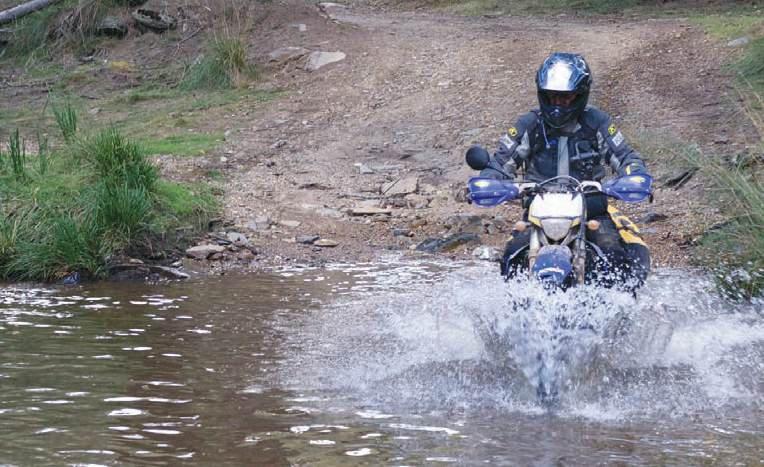
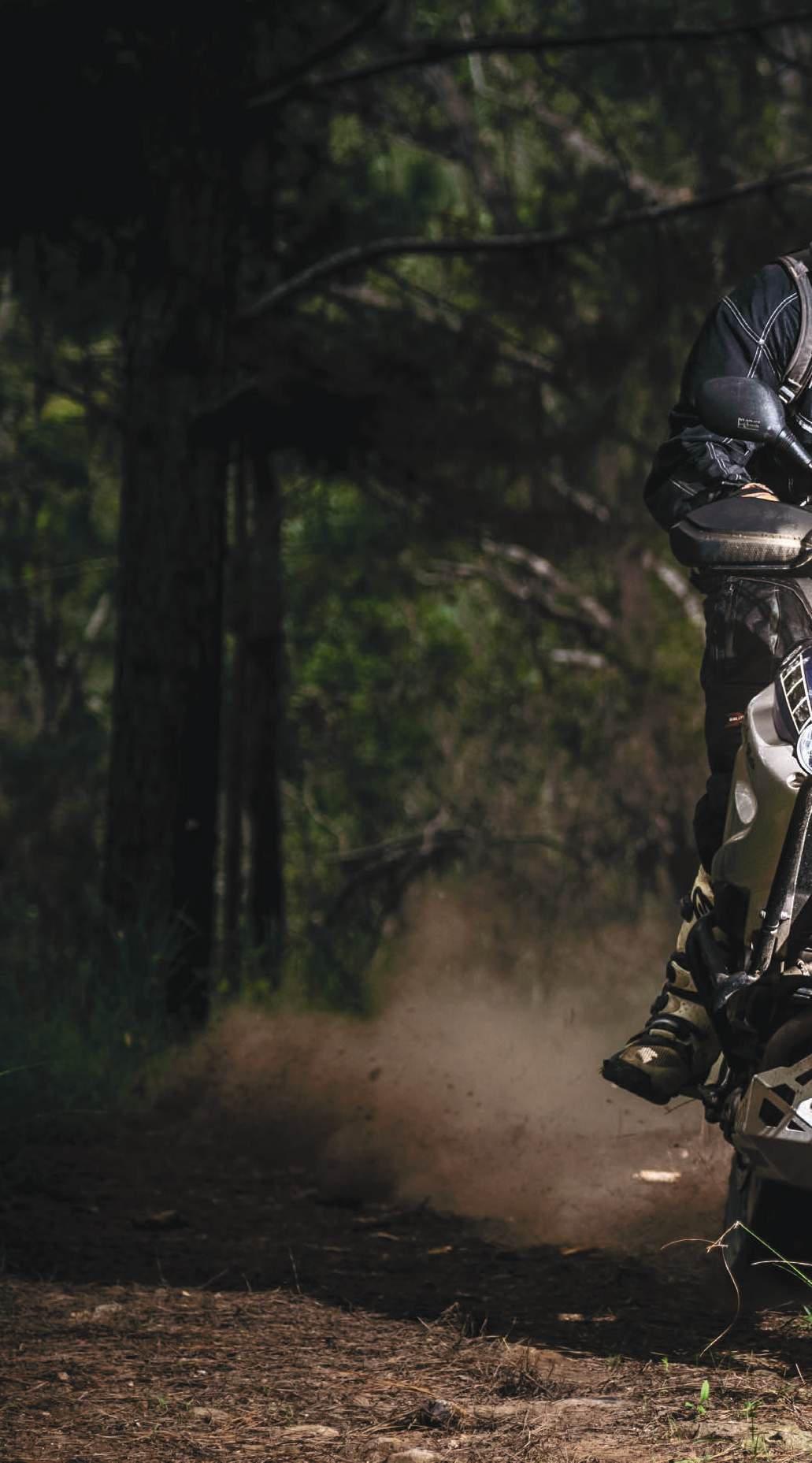
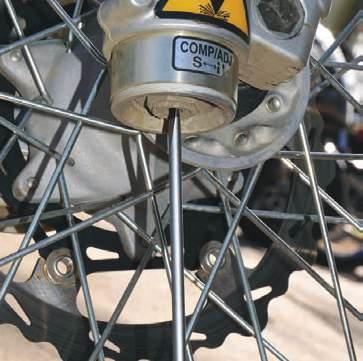

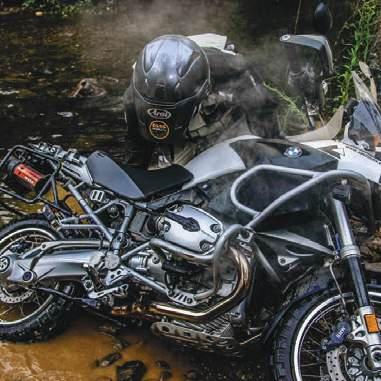

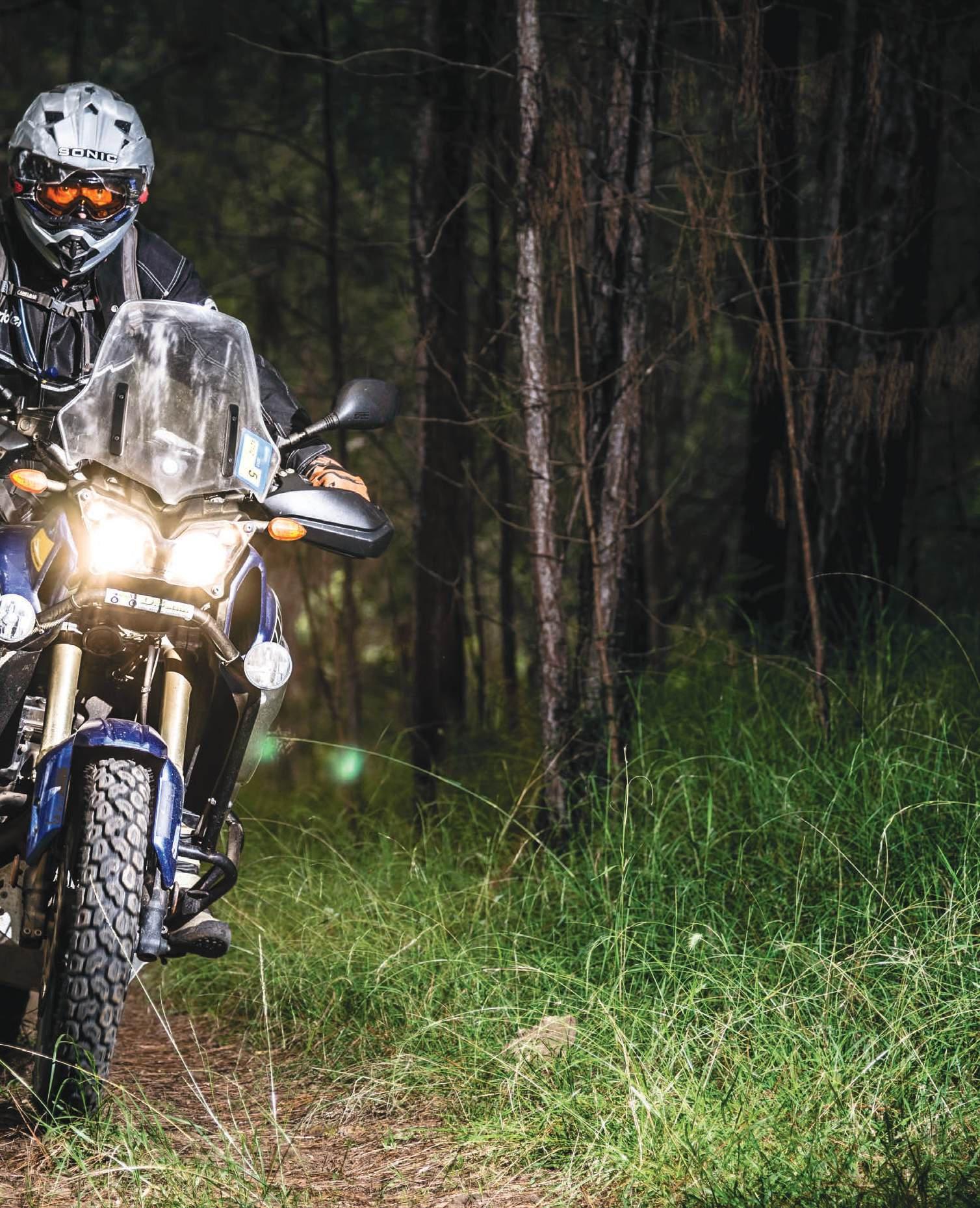
Packing For Adventure with Robin Box
Communication: The Problem To The Answer
20 Things You Should Know About: the DR650
Reader’s Bike: Andy Powell’s KTM690
James Powell – Quad Adventurer
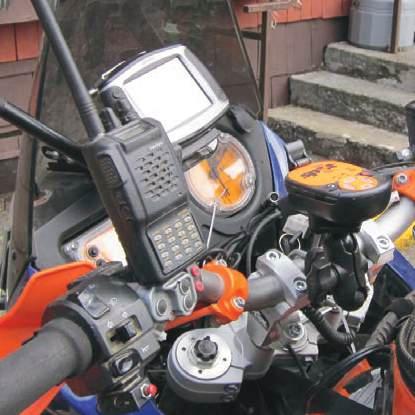
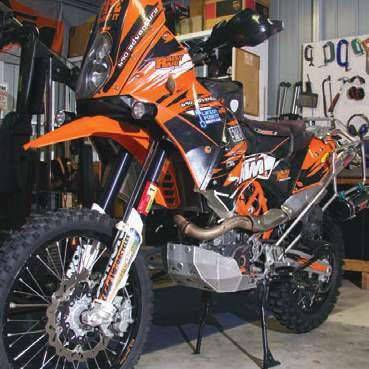
10 Minutes With: Rod Faggotter
Next Issue
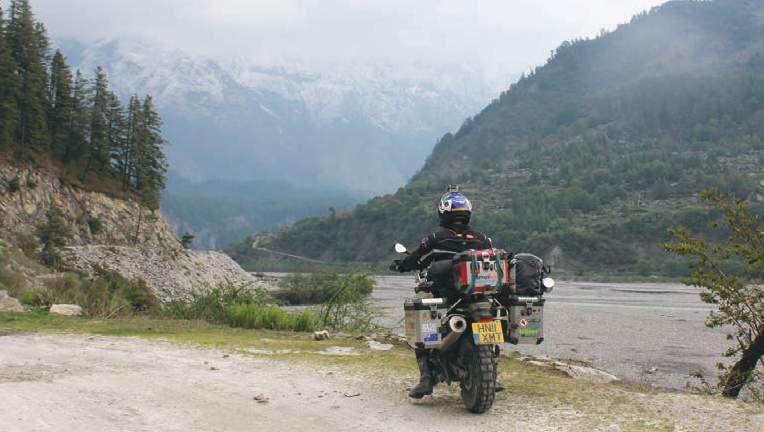
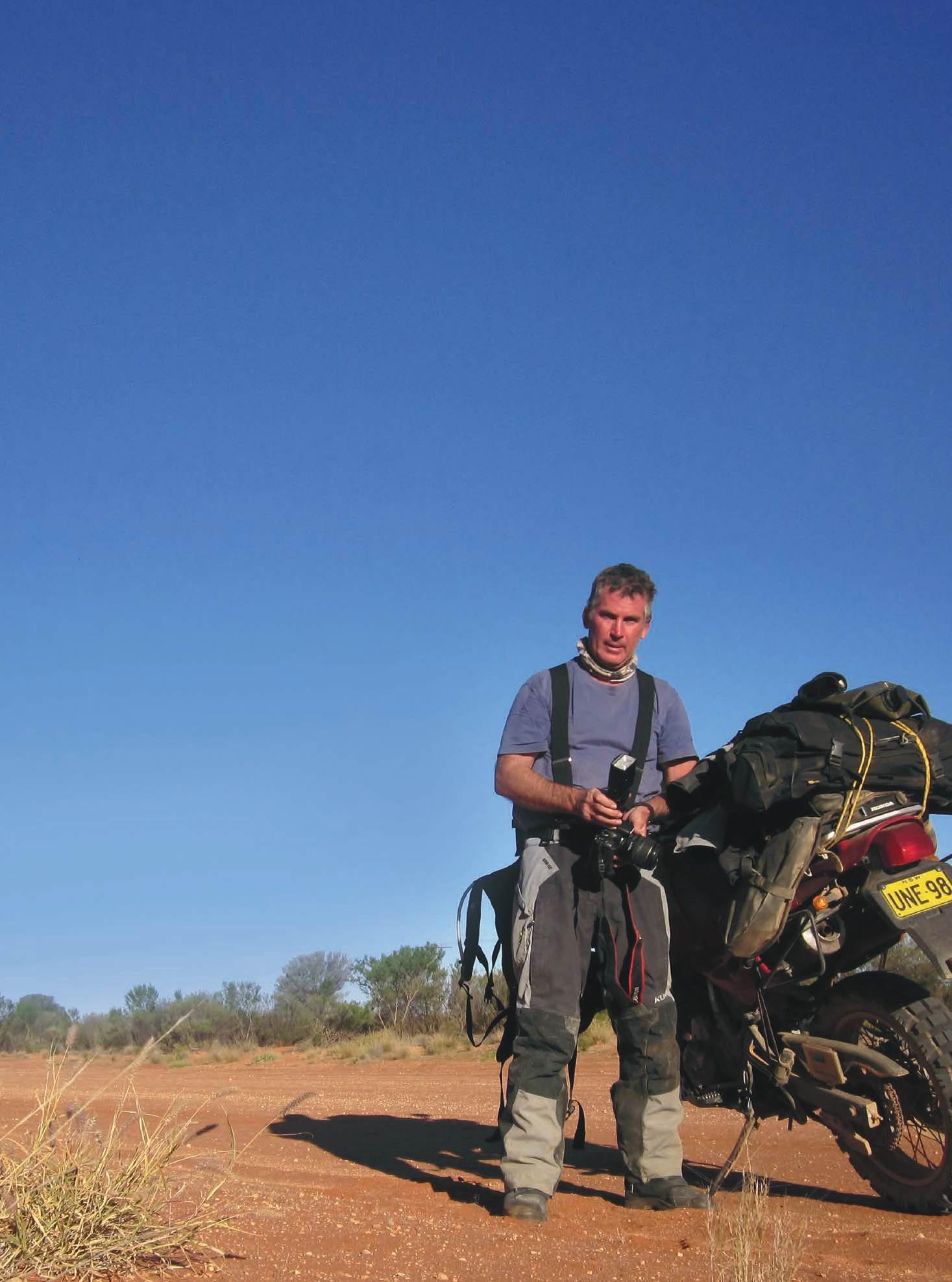
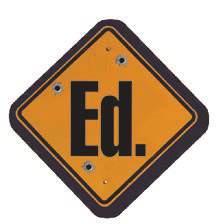

Welcome to the first issue of Australia’s only adventure-riding magazine.
Other mags have bits and pieces of different content, but in this mag adventure is all you’ll find. The people writing for it are adventure riders too, so when they offer advice, they’re offering the benefit of experience won from the deserts, mountains and dirt roads of the world. They know what it means to have 200kg of bike stuck in a creek, be facing 300km of extreme cold before the next shelter, or that squirt of adrenaline that comes from realising the location beacon is suddenly going to play a very real part in surviving the next 24 hours. Not that all riding has to be dangerous or life-threatening, but the people involved in this mag have that kind of experience, and they’ll be sharing the hard lessons learned in the tough, outdoor schoolrooms of the real world.
I can include myself in the group. I’ve busted bones in the Australian deserts and forests, struggled to breathe in the thin air of the Andes of South America, looked down the
business end of a sub-machine gun in Asia and fought with the kind of ‘loose bowel’ that only a parasitic bug from an East Timor river can offer. I’m not much of a rider, and in a lot of cases I’ve tackled exotic and challenging rides that someone of my very meagre abilities should never have had the chance to do. America, Europe, NZ, Asia… I’m honestly amazed at the rides I’ve been lucky enough to chalk up. I’ve been on those rides and bikes thanks to 20 years in publishing, most of it on one motorcycle magazine or another. It’s never made me a great rider, though. I still fall in creeks, get stuck on hills, get lost (often) and have those times where I feel like it’s just not worth the risk to hurl myself at some challenge or obstacle. The fascinating thing about adventure riding is that sometimes there just isn’t a choice. If you want to get through the ride –sometimes if you just want to survive –there’s no other way. You have to tackle the
obstacle, or confront the problem, no matter what the risk. Nobody enjoys it when things don’t go well, but it’s part of what we do, and I love what we do.
So that’s what you’ll find in these pages, and even more of it on the website – adventures, the people who love looking long odds in the eye, and some insights into the gear and strategies that might sometimes get you through, or out of, a tight spot. More than that, you’ll get some real-world insights and advice on gear that works and equipment and ideas that make the whole fabulous, wild adventure of travelling this world and this country on a bike. You’ll get a good look at the people involved in each issue, and a glimpse of some the world’s great adventure-riding destinations. Look out for us on the trails and back roads. If you spot us, for heaven’s sake come and say hello and spin a yarn or two. After riding, sharing stories is what we enjoy most.
Tom Foster Editor
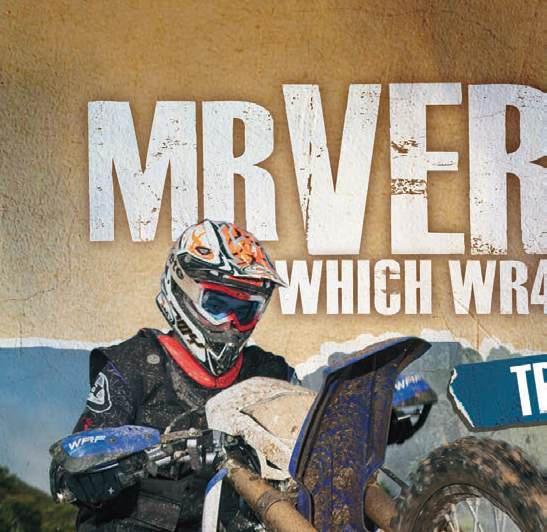

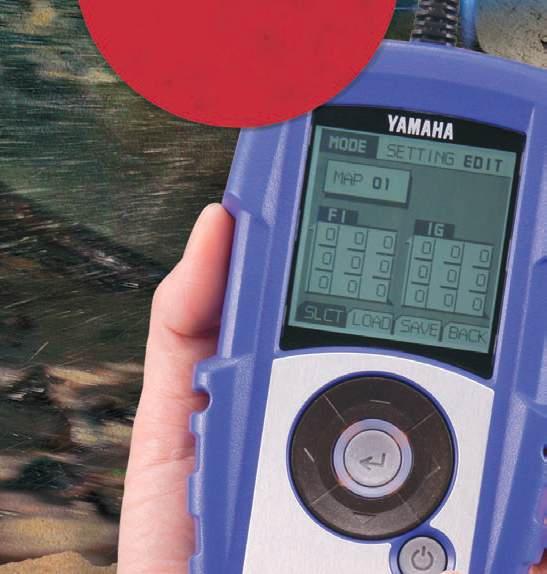
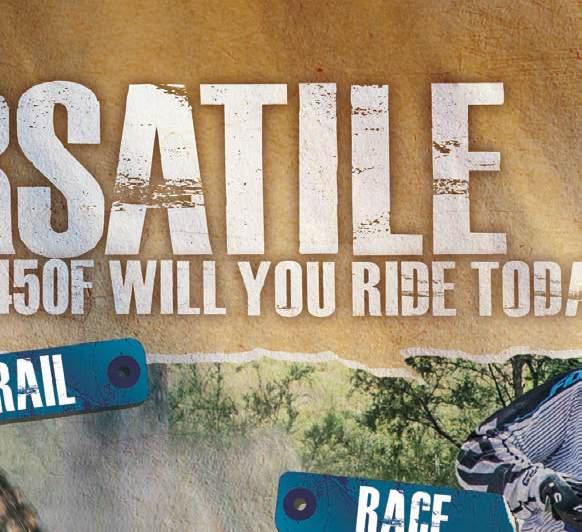
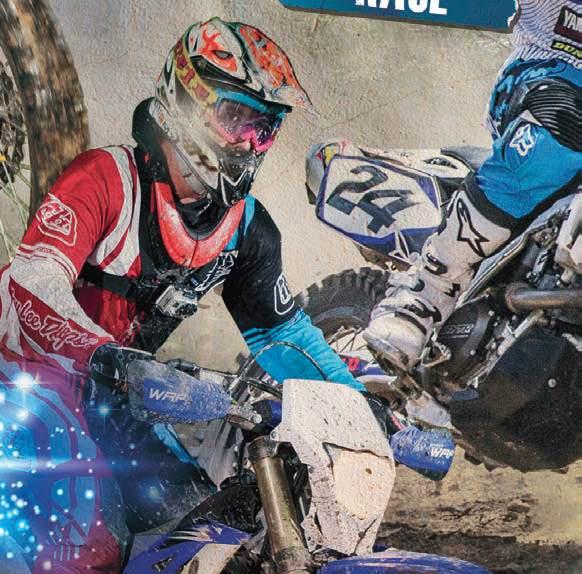
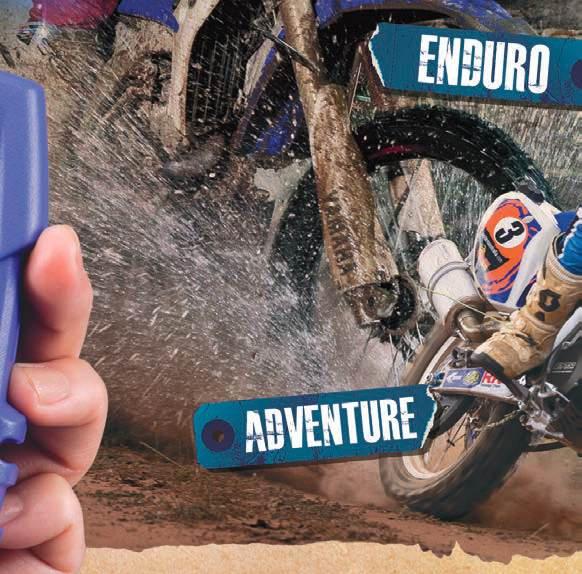

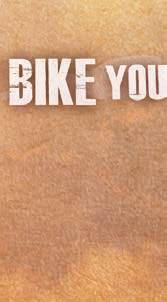




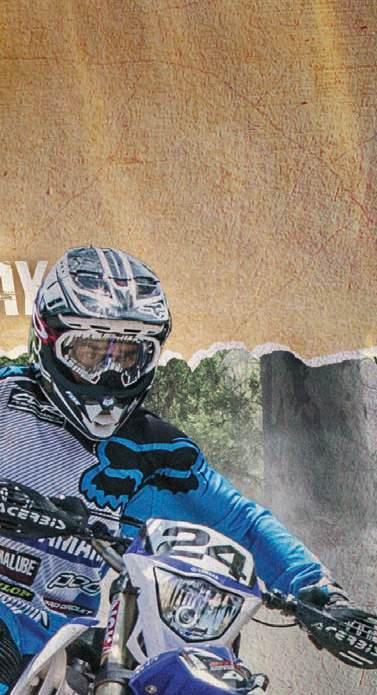

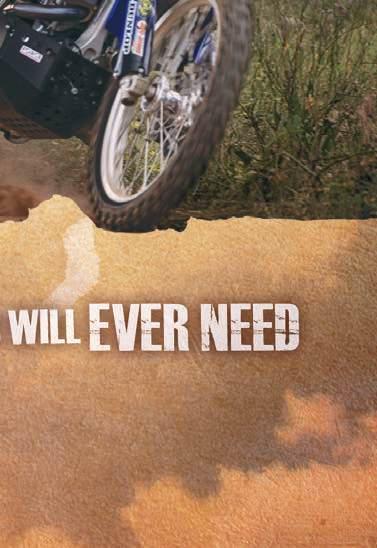
A 14-day, 7000km, non-competitive, super-endurance event for adventure riders? You bet!
Words
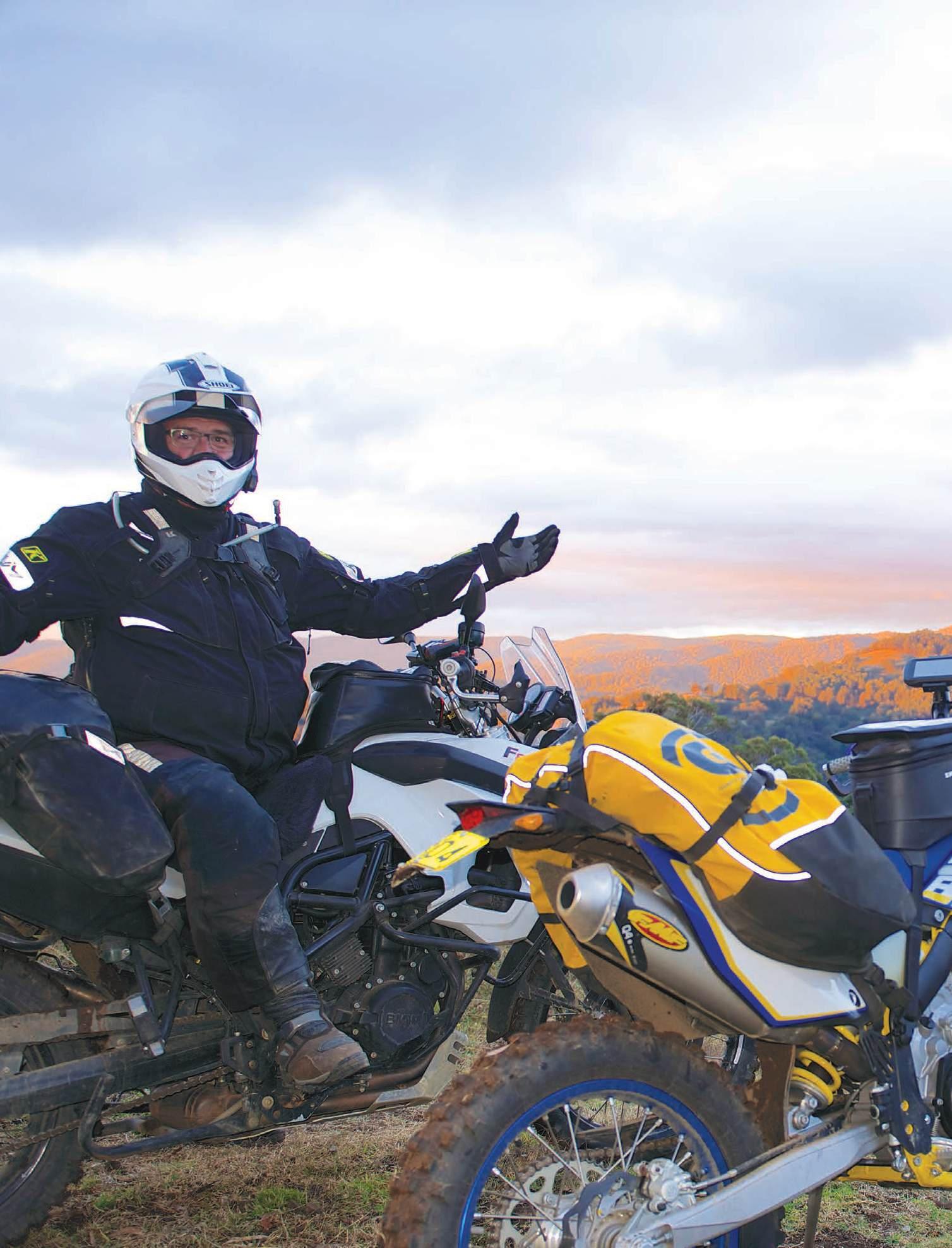

Alaska’s legendary Iditarod only runs around nine days, and finishers are considered world-class heroes. What does 14 days of bone-jarring, mudslinging, rock-hopping, river-crossing, mountain-climbing, ice-skating and sand-ploughing determination entitle APC Rally finishers to be called?
Probably legends in their own lunchbox.
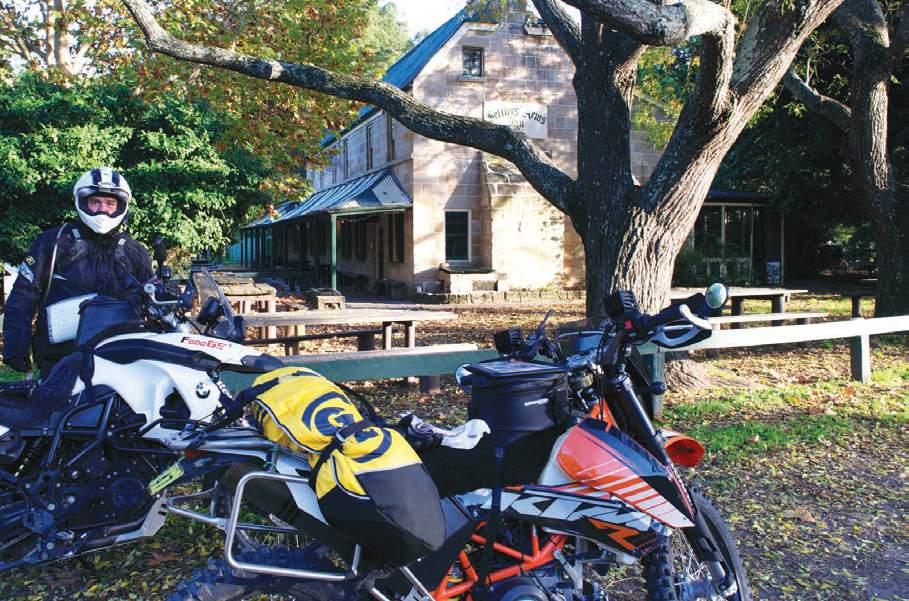
If you’re one of the elite who actually managed to complete the course in 2013 you’re awarded a nice shiny medal. If you finished within the 14 days then you make it to the Lunchbox Legend category. But along the way the ride itself is many, many things.
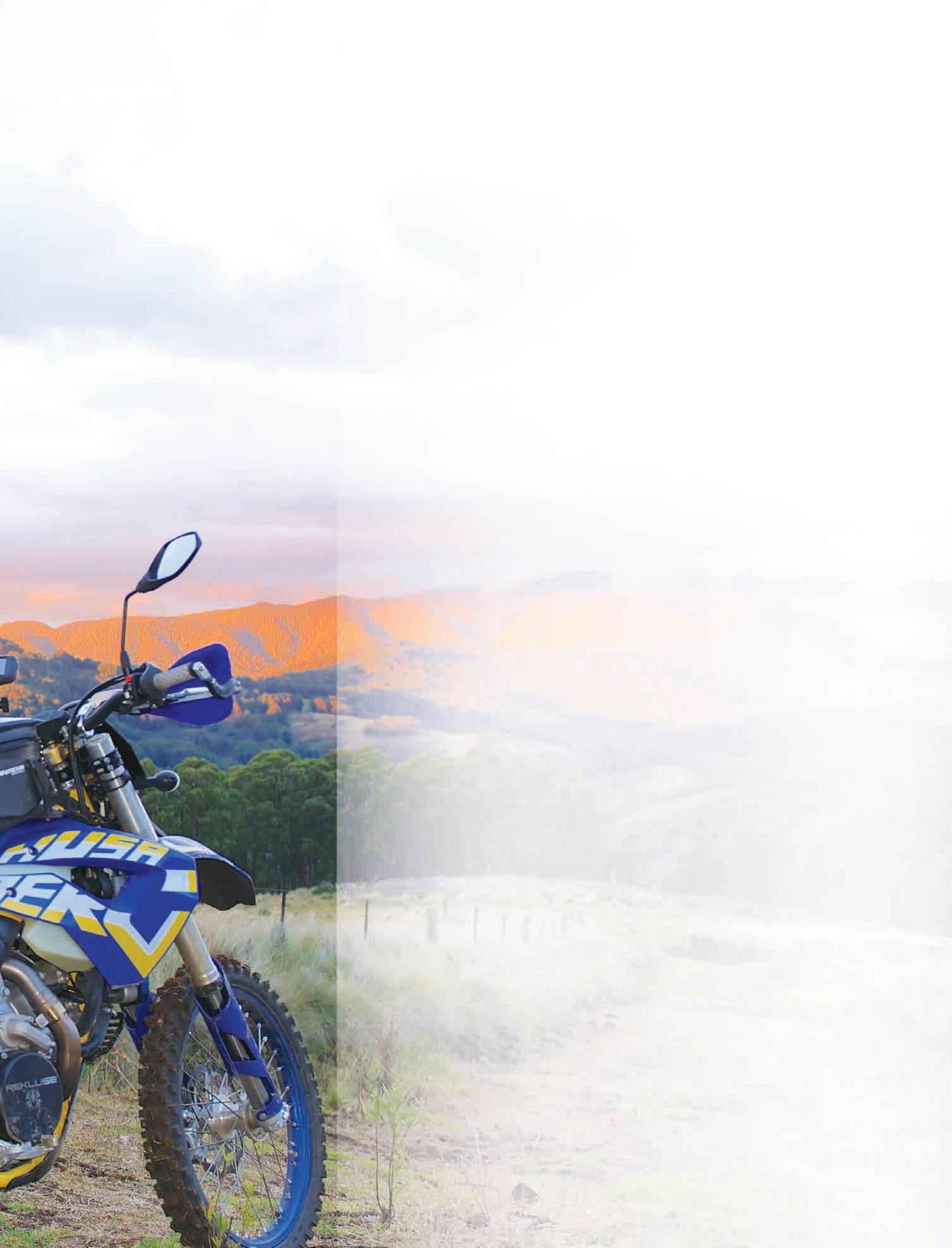

Above: Tree-1. 990 -0
Below: A fast adv conversion. Screwed.
The stops were as good as the ride sections.
Last year, on a KTM990, on Day Five, my speed through the Strzelecki Desert sand and my riding ability became incompatible. More plainly put, I binned it. Big time. I was knocked out, lost a tooth and my left wrist was pointing down at a very funny angle.
But this is a marvellous country. Here I was in the middle of the serious outback, pretty well not knowing what day it was, and when my mate set off my EPIRB help arrived within two hours. The ladies and gents from the Moomba oil and gas field jumped to the rescue. I was treated to a trip back to the main gas plant then a flight to Adelaide with the Royal Flying Doctor Service – thank you John Flynne! It was the end of the 2012 APC Rally for me, and I picked up a few internal titanium pieces to get my preparation started for the 2013 event.
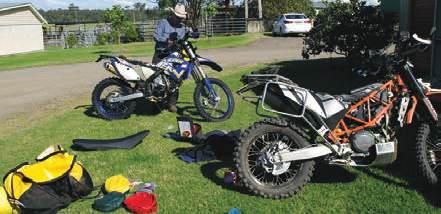
as the date approaches. It includes things like a new chain, sprockets, wheel bearings, super-heavy-duty tubes (the ones that weigh about four kilos each), spares – especially tubes – tools, lighting, suspension, long-range tanks, replacement tyres preordered at relevant locations, a hard-wired GPS, clothing and personal needs… and the list goes on.
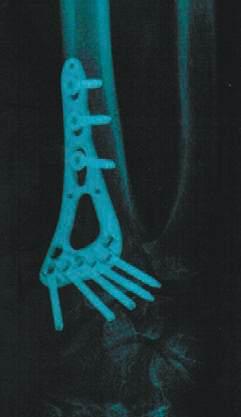
What a way to start. An early incident forced a last-minute bike change and a late start. But the view approaching Stewarts Brook made it feel like none of it mattered.
How do you prepare yourself and your bike for 14 days of some of the most challenging trails and mountains the eastern half of Australia has to offer?
First of all, both body and bike need to be in top condition. This bike and body prep intensifies
Always remember Rule Number One – travel light. After you assemble all the ‘essential’ stuff, think again. Leave behind anything that even slightly resembles luxury or duplication. Apply the old Four-DayUndie rule to everything (you know… frontwards, backwards, inside-out and do it again). Work out how you intend to carry it all. Pack and re-pack, toss out more nonessential stuff. Sort out who you’ll be riding with. Many entrants simply turn up and hope they can find a riding buddy along the way, rather than the risky alternative of riding solo. This year I teamed up with Dave Smith, a Bavarian armchair rider (BMW F800GS) I met on the NSW Four Day APC event.
We started from Wisemans Ferry, some 75km north-west of Sydney, and about three hours later disaster struck. A slippery log angled across
u

Just another fabulous day on the APC Rally.
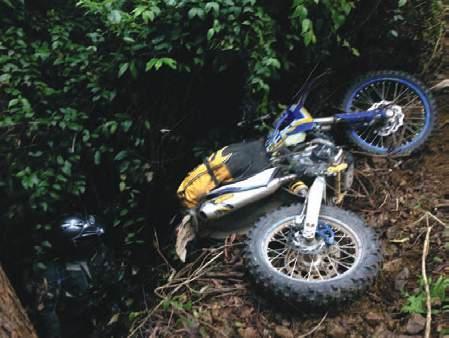
the track had me all crossed up and I smacked into a sapling. The tree lost some bark, but I destroyed my right hand fuel tank, which shattered and dumped its contents all over me and the bike.
It didn’t seem like a huge problem at first. I blocked the fuel line, dumped the useless parts and carried on. But a green fluid was soon writhing its way around the cases and a closer inspection revealed I’d driven the radiator back onto the regulator – things didn’t look too good. We limped into Cessnock and checked the availability of a new radiator, only to find the nearest was in Western Australia.
I desperately didn’t want to hold up the show, so I quickly formulated a new plan.
Luckily we were as close to my home as the rally got, so I limped back to the garage, grabbed my Husaberg and set about converting it into an adventure bike. The conversion amounted to fitting a ram mount on the ’bars for the GPS, wiring it up and strapping the Giant Loop across the back. That’s all. A year’s prep on the KTM690
became an hour of frantic improvisation on the 570 ’Berg.
We pushed on and rode into the night to make our first pre-booked accommodation at Moonan Flat pub just in time for dinner.
The only other bit of excitement for the day was just after dark near Stewarts Brook when Wally Wombat and I both wanted the same piece of road. Somehow I managed to keep it upright. If he was bruised it served him right for not giving way.
A nice early start to the second day included an easy run over Barrington Tops, and it was our first hint of the freezing conditions to come. Fog, frost and mud were the highlights of our early morning romp.
Later in the day we had just the last section from Comboyne to Wauchope still to cover, and we were fairly confident we’d beat the dark for that night at least. But good old Murphy’s Law smacked us around the head for being so cocky. Blackberry Ridge Road served it up to us in spades. We managed to drag our bikes over a fallen tree with just a bit of grunting, only to find ourselves faced with The Bridge Of Doom.
The span was a log bridge over a four-metre gully, and all but two logs had been washed away.
We gawped at it and each other and asked ourselves, “Are we adventure riders or not?”
I managed to get across okay on the light trail bike, but the GS wasn’t so lucky. The front wheel dropped between the two logs and buried itself up to the axle. After a bit of a struggle we managed to heave it out and push on.
Another 500m on a large tree had fallen and totally blocked the track. It was steep up on the left and steep down on the right, and the fallen trunk was about 1.5m or so high. There was no way around or over it that we could find, so it was back over The Bridge Of Doom and the first downed tree. Suddenly we found it was getting late and night was approaching.
We managed to get the GS back over with a bit of pulling, but I slipped right at the exit off the bridge, putting my foot down on mid-air. Over the edge I went.
It’s a good thing it was the light
The author showing a bit of crack.
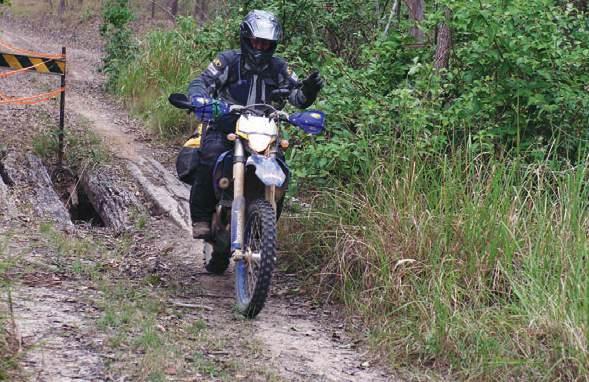
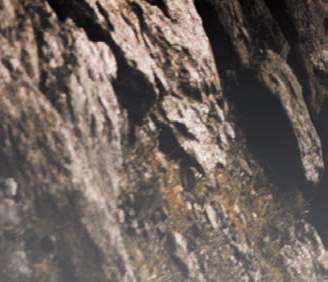






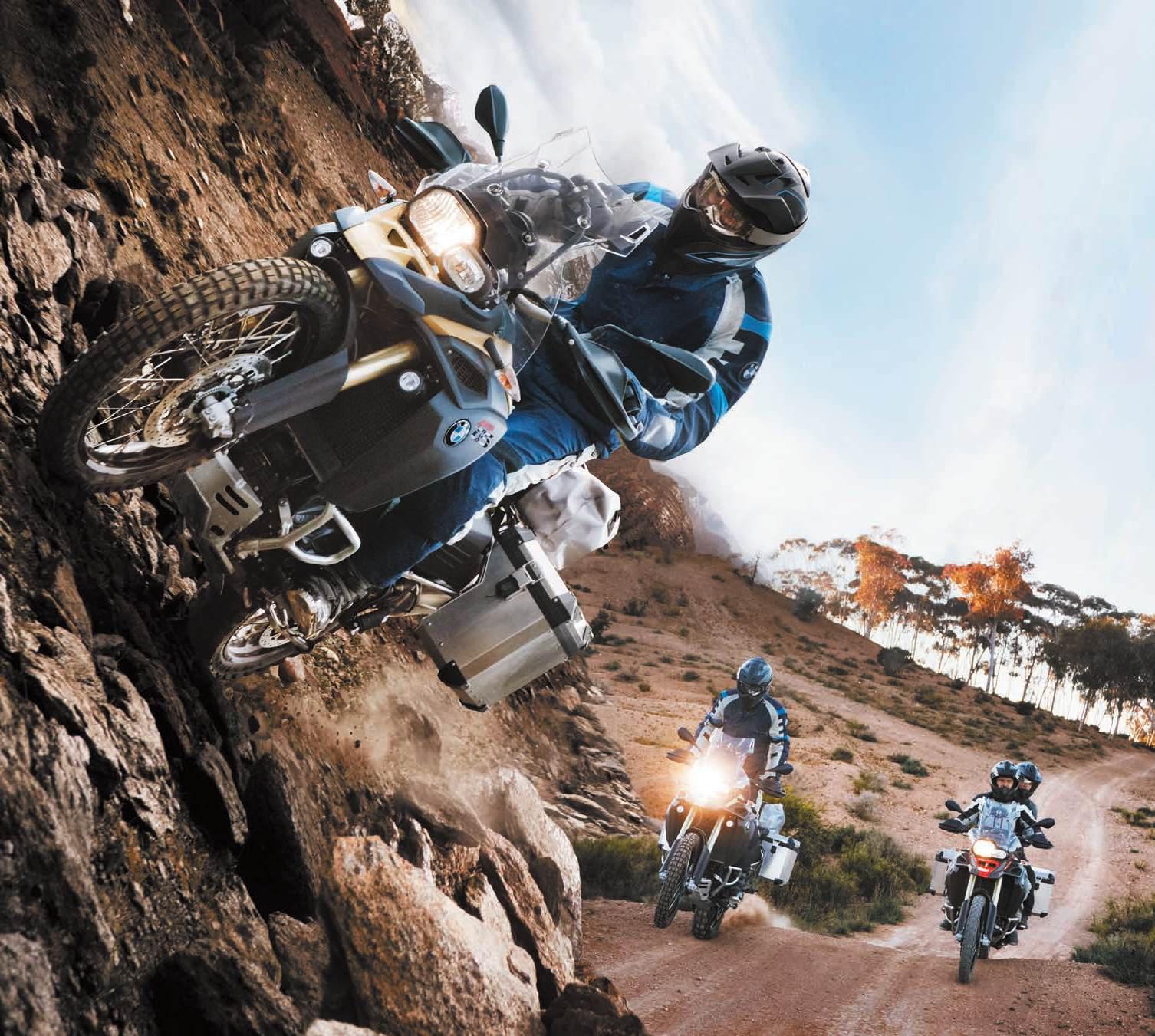
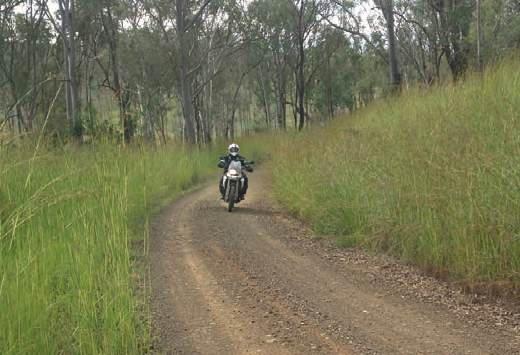
little bike, because with a tow strap and a bit more struggling we were soon back on the track. By then we were both pretty well buggered and it was almost pitch black, and we still had the fallen log to negotiate. We managed to drag the bikes back over, humping the GS across first while we still had sufficient energy to lift the beast. Then it was back to the tar and straight to Wauchope for a swisho meal and a comfortable bed at a motel.
As we rolled out of the motel at the crack of dawn the next morning I noticed the local bike shop was open. I desperately needed a new rear tyre so we took advantage of this stroke of luck.
This leg was the best fun ride of the event. The day was made up of fantastic trail riding, long sections, hills, creeks, rock, single track, and a great day in the long, green tunnel of tree canopies overhanging the forestry roads.
It was bloody cold as we climbed
There’s cold in them thar hills!

An early start didn’t feel great when it was time to roll out of bed, but when we climbed on the bikes and found scenes like this waiting for us, we couldn’t wait for each new day.
toward Ebor and we didn’t want to be caught in the dark again, so we pulled up at the Ebor Pub and did a bit of bike maintenance. It was time to change the ’Berg’s engine oil anyway.
The pub put on a beaut roaring fire and good meal. When you’re cold, tired and stinking of engine oil, it doesn’t get much better.
An early start through the Ebor frost saw us run down through hippie country, then up onto the Northern Tablelands again for breakfast at Glen Innes. Two great sections started this fourth day on fast, open, decomposed granite roads and they made a welcome change from the ‘long green tunnel’ of the day before. We pushed on into Queensland to try and make up for the slower, tighter sections, and that resulted in a 14-hour day.
It was a good thing the GS had excellent lights, because the candle-weak effort on the ’Berg kept blowing out.
Day Five turned out to be a cruise into Kilkivan, about 220km north of Brisbane, and there was a warning to not enter the next section late.
The ’Berg was due for another oil change, and that was a couple of good enough reasons to call it a day early. After five days going like the clappers a beer and a rest sounded pretty good.
The sixth day of the Rally offered plenty of variety. There was everything from really fast, open road through to single track.
Someone up ahead of us must’ve been pushing pretty hard by the looks of the overshoot marks in lots of corners, and Dave managed to get between a wallaby and its desired destination. The determined marsupial ran head-down, flat-chat, straight into him and the frame of the bike left a nice bruise on the inside of his leg.
It must’ve been a good season in the Bundaberg area. I’d never seen cattle so fat or the grass so high as u
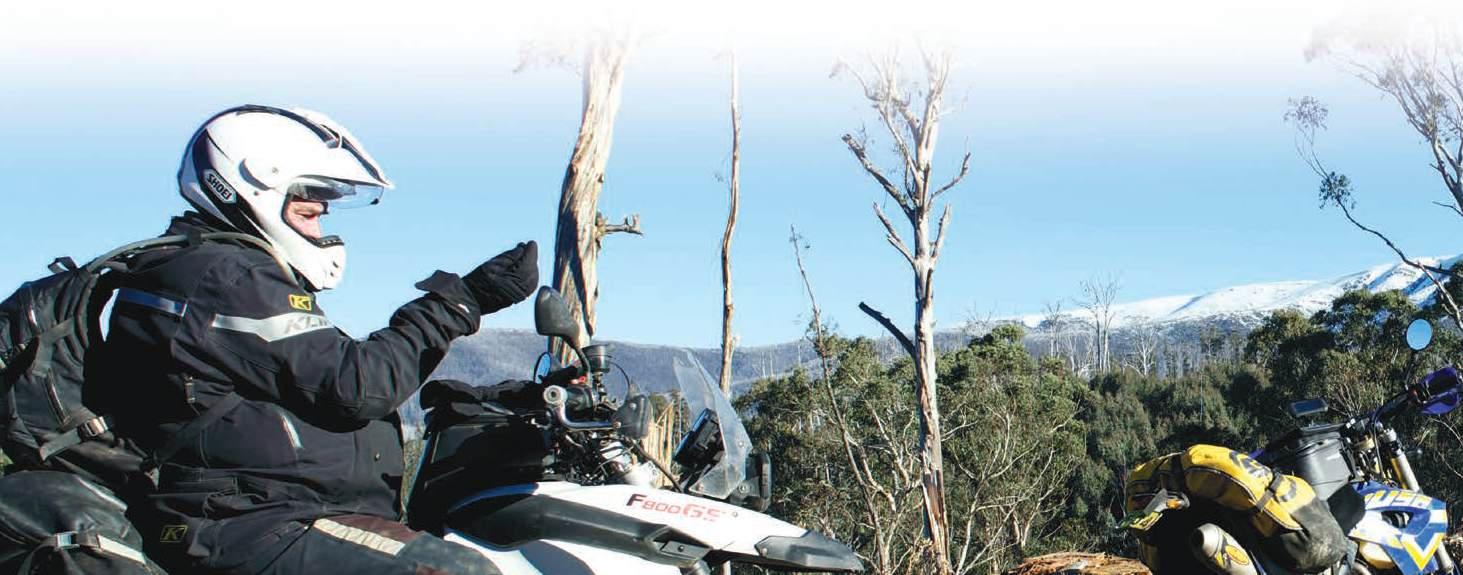

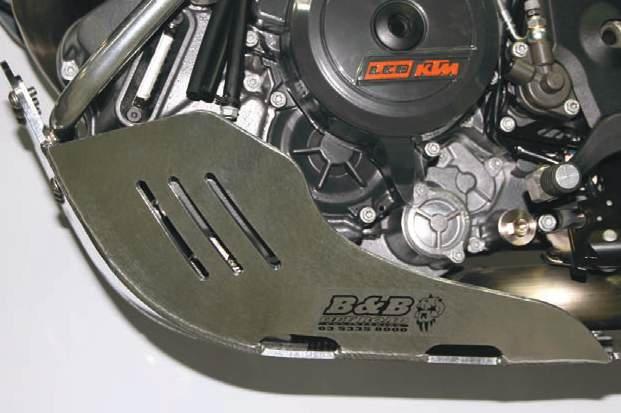
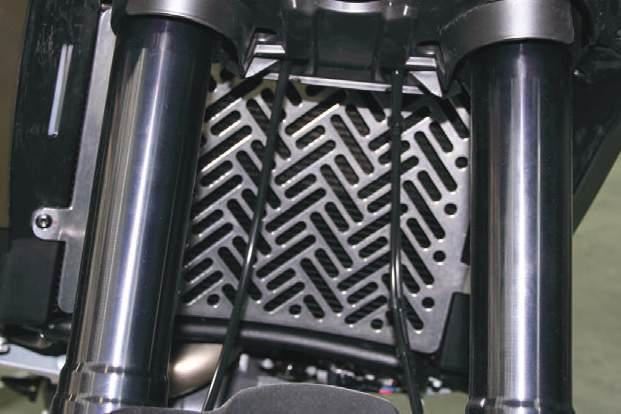
Bashplate is made from 5mm thick 5083 structural alloy plate. Rear mounts are 5mm stainless steel with a rearward facing lug that rests on the rear frame rail to prevent rotation of the bracket. There are 6 32mm holes in the underside to help flush debris and minimise noise. There is also a rubber damper glued inside to help reduce noise. If so desired we can supply with motofoam to further reduce noise and mud build up. Bashplate can be fitted with or without genuine crash bars. All necessary mounting hardware for this is supplied.
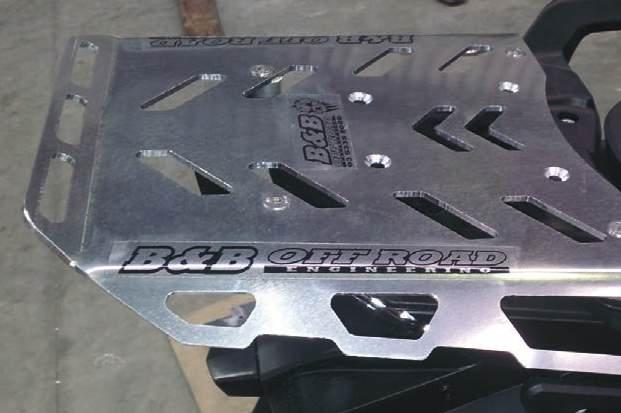
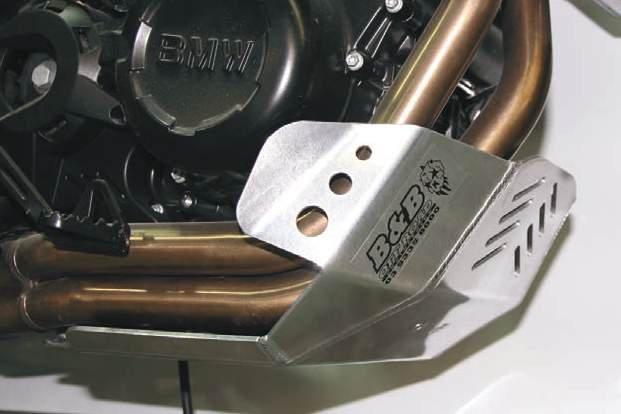
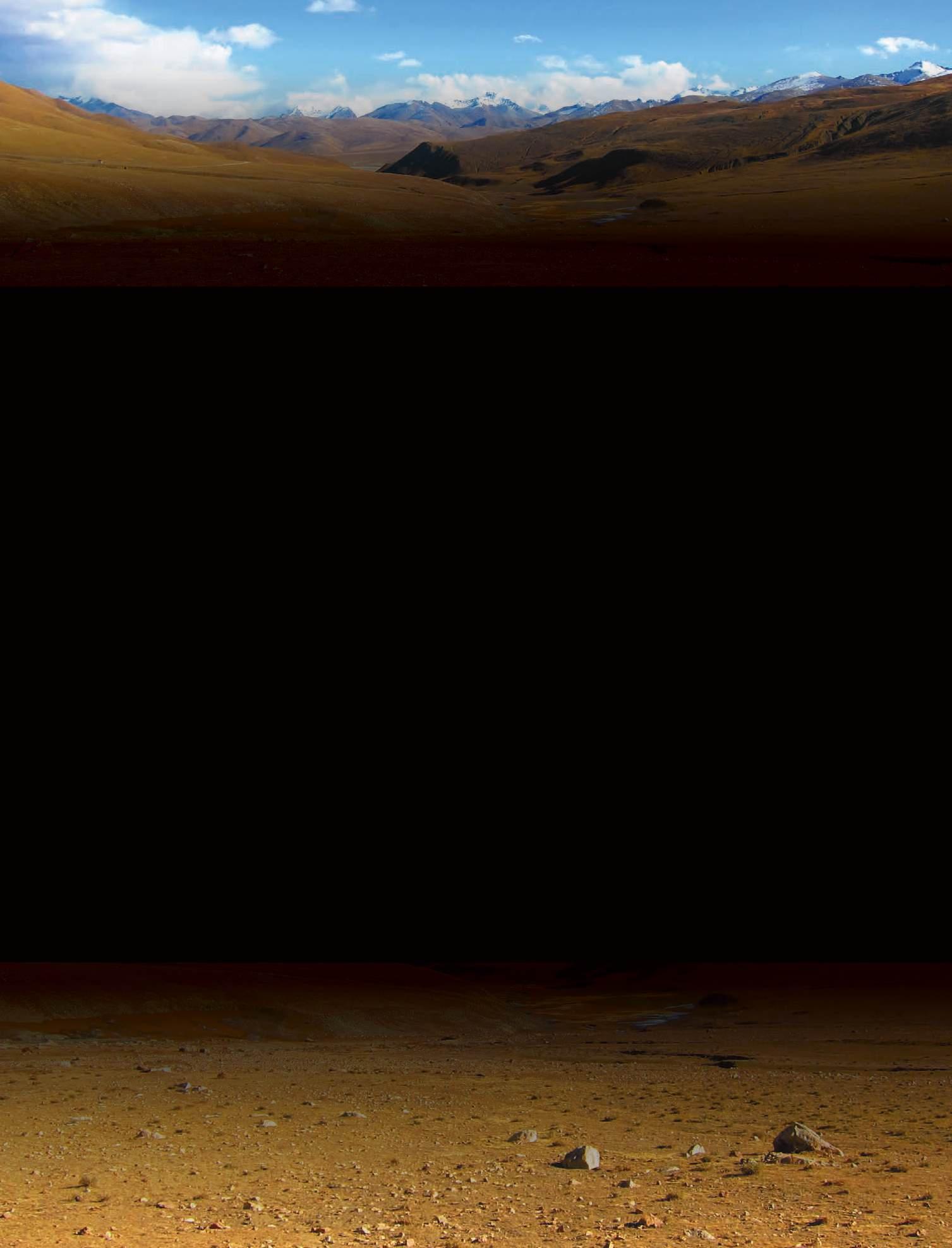

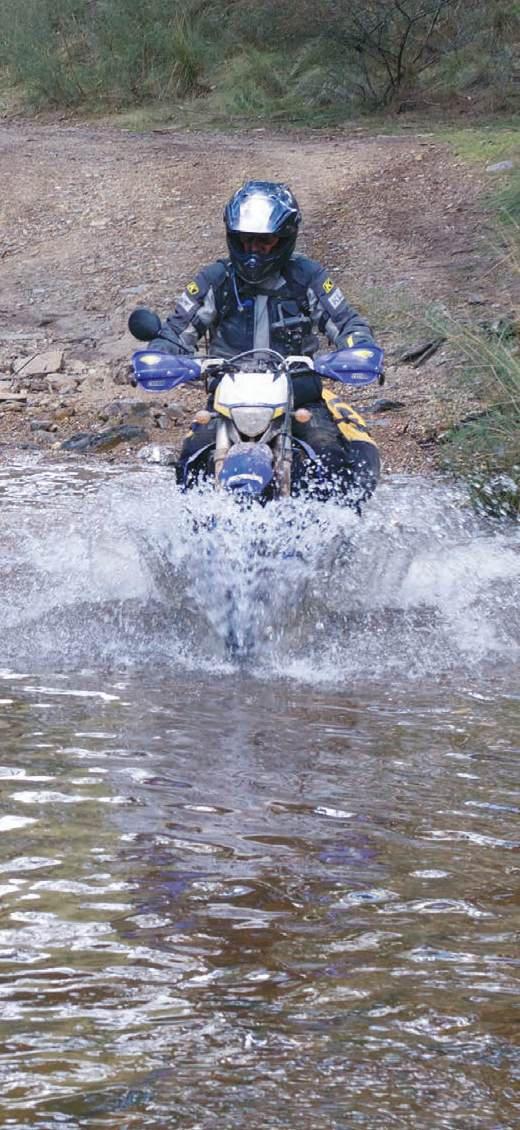
Above: There weren’t any ‘serious’ creek crossings, but every crossing needed to be treated with respect.
Below: Some trails were begging to be ridden.
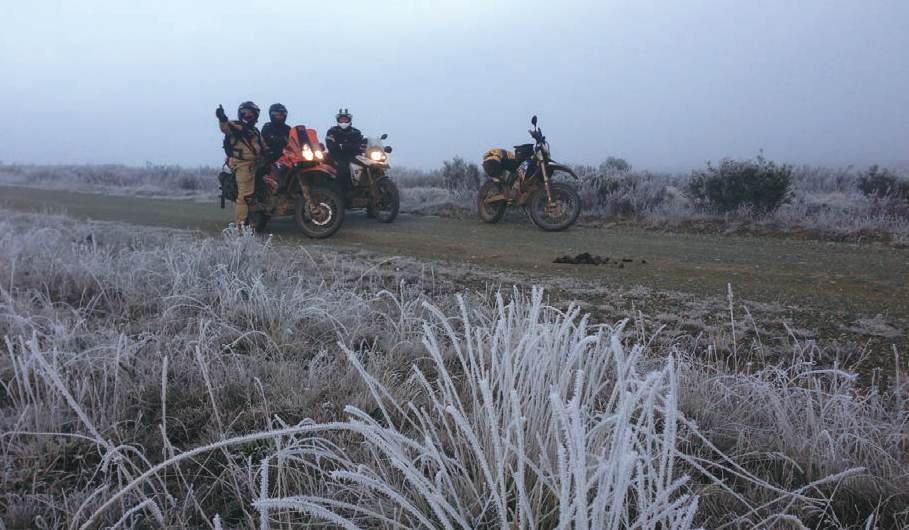
it was when we went through. We trundled into Dalby about lunchtime on Day Seven, ready for new tyres and set to do some scheduled bike maintenance. I’d ordered a set of heated grips (yeehaa!) and was busting to get them on and working.
The GS looked a little low in the rear when we pulled up, and closer inspection showed a broken shock, so it was Dave’s turn for a bit of lateral thinking.
A few phone calls to his suspension tuner and a great effort on the lathe by the boys at Dalby Moto had us back on track just after lunch the next day.
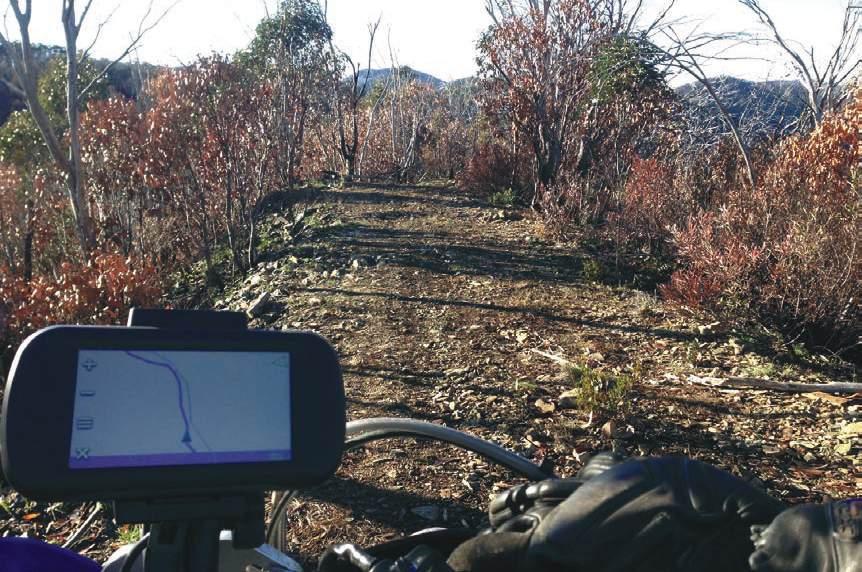
Meeting other riders on the Rally was high a point, no matter where or when.
With torrential rain in the west of NSW our next scheduled leg was washed out and we headed straight down the tar, aiming for Wodonga on the Victorian side of the Victoria/ NSW border. It bucketed rain as we pulled into Moree in the central north of NSW well after dark. We booked into the Spa Motel and had a good old soak in the hot artesian water. Man. That was heaven!
Day Nine dawned and we had no option but to keep heading straight down the blacktop toward Wodonga. The wet, western country was closed to the rally, so we gritted our teeth and logged our time on several national highways, one after the other. The Newell, the Olympic and the Murray Valley Highways made up our day, with an overnighter at Junee.
I never again want to do 780km down the wet tar, in the cold, on a trail bike. I think the heated grips saved my life.
Junee to Wodonga reminded us we were once again in the cold, dishing up fog and frost.
We bowled into the Wodonga bike shop for scheduled servicing and met the first of our fellow rally riders,
Picture postcard scenes like this were everywhere.
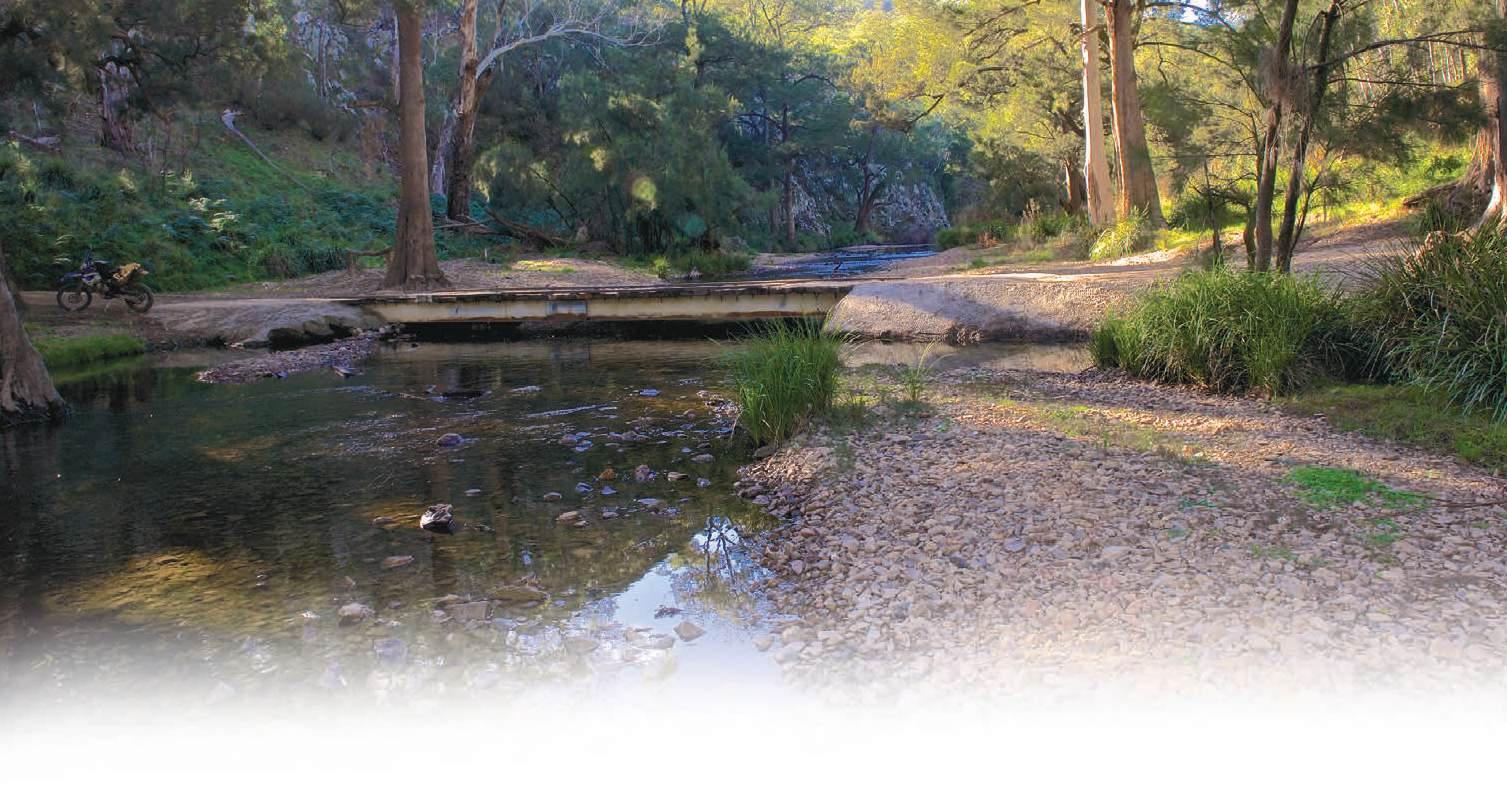
swapping phone numbers. We kept in touch with those guys for the rest of the rally.
At around lunchtime, after a break for a real, barista-made coffee, we got cracking again, covering 100km or so south-east to Mitta Mitta just before dark. Event organiser John ‘Homer’ Hudson tossed in a little surprise as we approached town, and a section of tight, slippery single track through the blackberry gave us a last-minute welcome.
We were lucky to get accommodation in Mitta Mitta because the town was booked out, but we finally managed to get a top-notch cabin at the caravan park. It was the only room left anywhere, so we counted ourselves lucky, despite the price.
After a shower we enjoyed a dinner at the pub with the boys from WA, and made a very good night of it.
The eleventh day of the Rally drove me to send the organiser a text. I’ll quote the SMS I sent to Homer after we made it into our overnight stop:
“Made it to Omeo tonight, you certainly turned up the wick today – good stuff! We felt today was the first time you provided SERIOUS riding challenges. Nice easy lead in through the forest then unmade road before we hit the rocky hill which
was a serious challenge to bike skills – fantastic! Then into the icy slush complete with black ice, slippery as all get out. After Dargo nice forest then into really slippery s--t plus lots of nice greasy logs. More drainage humps than I have ever seen before and all steep and sloppy. Really pleased to see Omeo turn up, was quite a tiring day.”
The hill I mentioned bought many riders undone. It was steep with large, loose rocks, and it required plenty of commitment to conquer.
As we headed toward the end of the Rally and back into NSW we were gifted with some glorious, memorable riding.
The Snowy Mountains region offered open country, bush, and some of the most scenic and fun adventure riding to be had. We scooted along the Barry Way next to the Snowy River and into Adaminaby for the night. It was at Adaminaby we met up with Brooksy, a fellow APC traveler who was “minding the ship” while his mate went back into Jindabyne for a new rear tyre.
I managed another oil change for the ’Berg, then enjoyed a quiet social night with a few of the lads.
Only two days to go!
The next day we wound our way through what the GS’s thermometer said was a minusseven-degree white out, complete with thick fog. I’ve ridden in some cold climates, but the thick, wet fog added another dimension.
First my visor totally iced up, so I flipped it up and relied on my glasses. Then the specs had a thick ice coating, so I went back to old Mother Nature and let the eyeballs and tears handle the situation. I shivered along thinking how nice it would be to have a windscreen. Then I started thinking how heated grips are lifesavers.
A run along a very greasy, redclay Long Plains Road took us into Oberon, in the Central Tablelands of NSW, for the night.
Brrr.
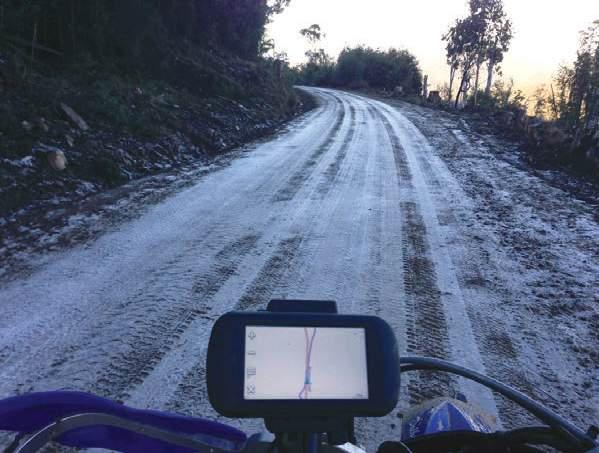

As we looked to kick off the 14th – and final – day of the 2013 APC Rally our big goal was to stay upright and finish.
We were getting close to home, so the country was familiar, and that made for a relatively easy day. Bathurst offered a run around Mount Panorama for a bit of variety, then we headed out via The Gardens Of Stone and down the mountain into Wisemans Ferry, our original starting point two weeks before.
What a great way to finish our epic 14-day adventure! What great riding to take us right to the finish line. Yeehaa! I got last year’s monkey off my back, and now it’s time to start planning for next year’s Rally.
Done! 14 days of superb riding, never to be forgotten.


The APC Rally isn’t a race or time trial. You buy the map and load up your GPS, then do your own thing. It’s really just a social ride with your mates, as fast or slow as you like. You can take as little or as long as you want to navigate around the loop. When we met the crew from WA in the high country, they were all gathered around a steaming thermos having a cup of coffee. But we saw plenty of adrenaline junkies who didn’t stop for anything – they just
attempted a PB on every leg. The APC Rally is many things to many people, and mine is just one story. There are similar tales from each and every fellow adventure rider. The level of difficulty depended on when you struck the weather. We were pretty lucky, but many weren’t. Some riders actually got stuck out west and battled the black soil, while others copped their wet sections in the mountains. Good old Murphy was very busy. We all rode virtually different events, but everyone I spoke with wouldn’t have it any other way. The APC legend lives on.
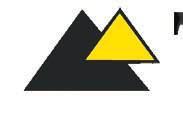

Expandable tank bag - 13 to 18L
Zega Pro top box
Luggage rack
Zega Pro pannier system
- 38L or 45L
Rear brake fluid reservoir guard
“Works” long distance foot pegs
Engine crash bars
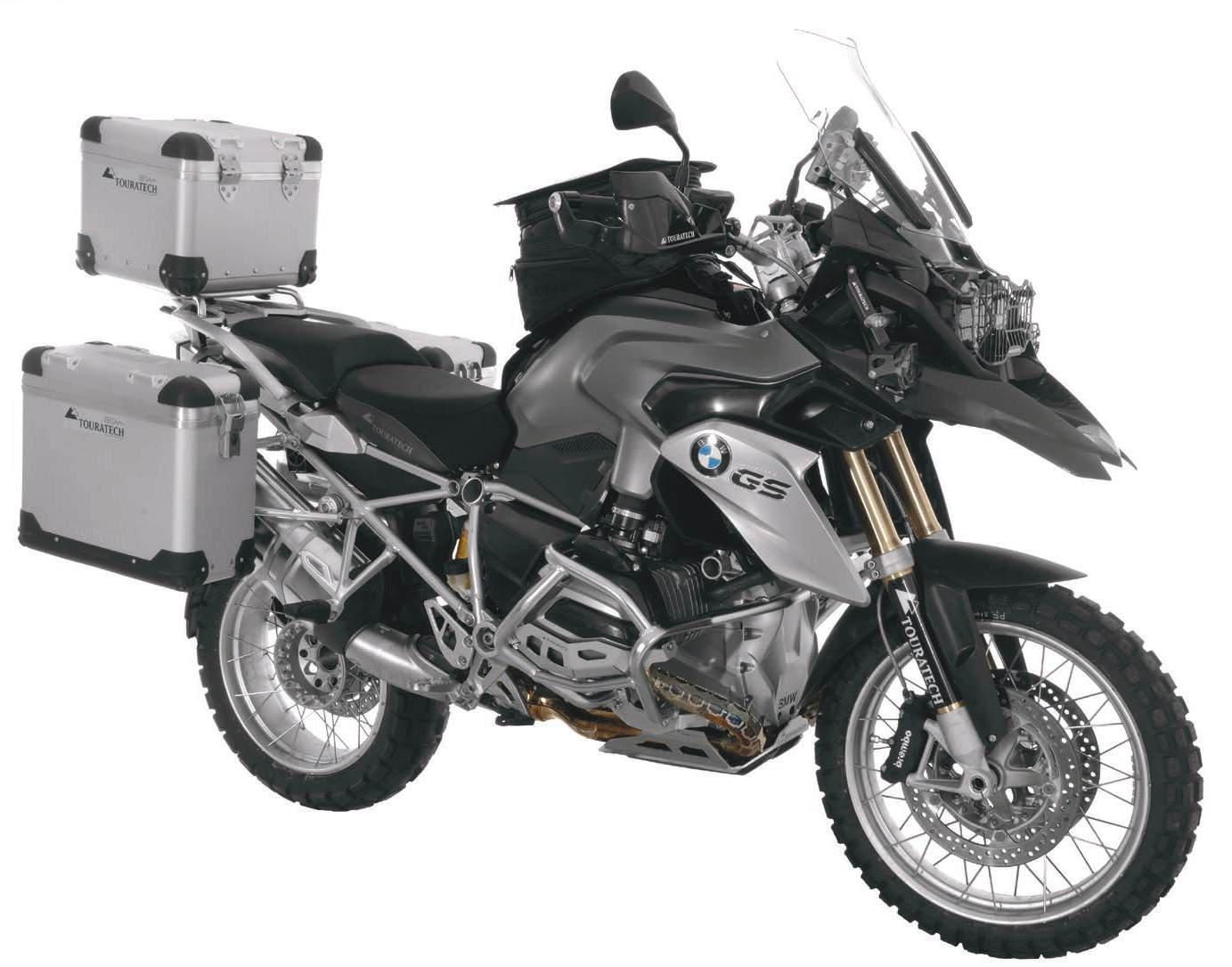
“Expedition” engine guard Cylinder guard
Manifold guards
Order your FREE 1800 page catalogue, with thousands of Touratech parts, including the all-new BMW R 1200 GS.
l Touratech make the world’s best GPS mounting systems, allowing you to safetly protect your valuable navigation device in all conditions.
l Touratech mounts fit any bike, and are robust, durable and provide an anti-vibration system that is second to none. Lockable mounts are also available.

l Designed to fit Garmin, Tom Tom and Magellan GPS units, you have a choice of a cross-bar, handlebar or Ram mounting. Priced from $187
l Touratech’s incredibly lightweight aluminium camp seat weighs just 470 grams.
l With a load rating of 110kg, size isn’t everything.
l You’ll sit a comfy 42cm above the ground.
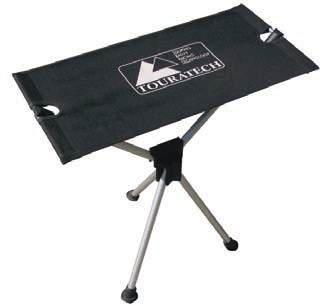
l Folded, the seat is just 35 x 5.5 x 4cm in size and will fit easily into your panniers or your back pack. Priced at just $74.95
Order at:
Headlight protector with quick release Auxiliary lights, fog/xenon
Radiator guard Mud guard extension Fork decals
l Highly abrasionresistent kangaroo leather palm.
l Spandex leather detailed back.
l Colourfast and sweat proof.
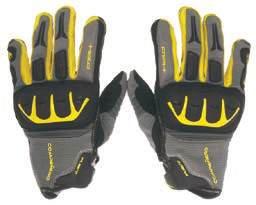
l Velcro adjustment at cuffs.
l Air vents on fingers.
l Perforated finger side walls.
l Hard plastic knuckle protection
l Stylish grey-yellow design. Priced at $180.40

Considered by most to be the ultimate bike challenge, the Dakar Rally remains the stuff of daydreams for most. But for a very tiny group, it’s an experience that takes over their lives. Craig Tarlington gives some insight into what it’s like to do Dakar, and do it the hard way: as a privateer.

Words: Craig Tarlington. Images: WRT and maindruphoto.com
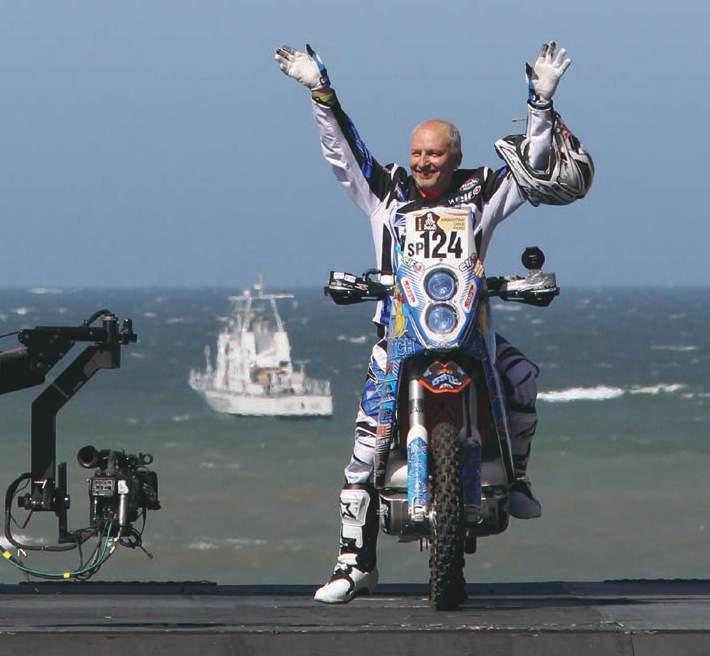
Left: Good to go on the starter’s dais for the 2012 Dakar. Four years of training and preparation about to be put to the test.
Below: The support team at San Juan on the morning of the third day. The ground was stone and it was hot all night. There was no sleep for the support crew, and I slept in the Suzuki 4x4 with the engine running and the AC on.
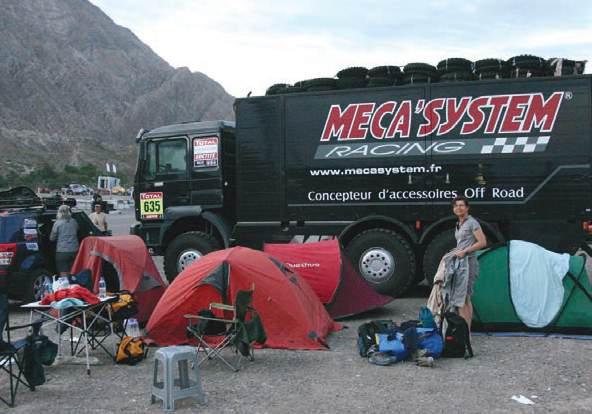
It all starts with a video or magazine article about the allure of a mystical thing called the Dakar Rally, and over time it grows inside you. Before you know it, it’s all you think of.
Just when you think you have it sorted, you turn up for the race as a competitor and the reality hits. It’s really just another race, and it’s got all the usual stuff of any race, but this one goes on for a few
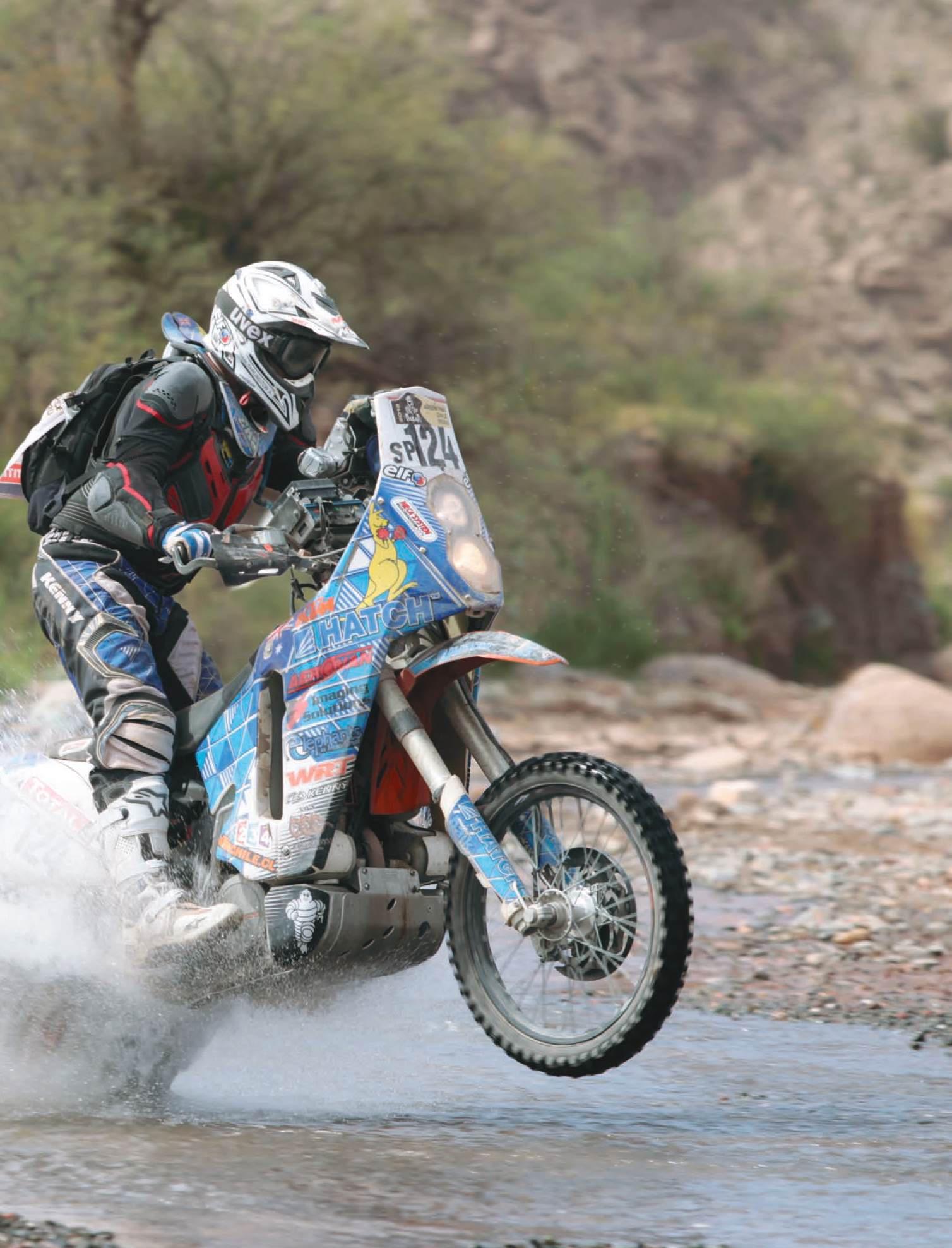
weeks. Yes, it looks tough on TV, and it is. And yes, it looks like a real adventure, and it is. But what TV and magazine articles don’t tell you is it’s a lot of other things – like at times, it’s actually boring.
Preparation is probably the key to success, and if you break the Dakar down into pieces, ‘preparation’ can probably be covered by several categories:
r Physical fitness;
r Mental strength;
r Riding skills;
r Navigation skills;
r Time management; and
r Planning.
It’s hard to work out which of these deserves the highest priority, because to do well you need to have them all covered to a high degree. This is probably the hardest element of the Dakar compared to other events. To run at the front you need to be on top of, and excel at, all these elements. To just claim a finish you need to be good at most of them.
u
Day Two – Santa Rosa De La Pampa to San Juan. It was a hell of a hot day, the rivers never stopped and San Juan was still over 40 degrees at 11pm at night.
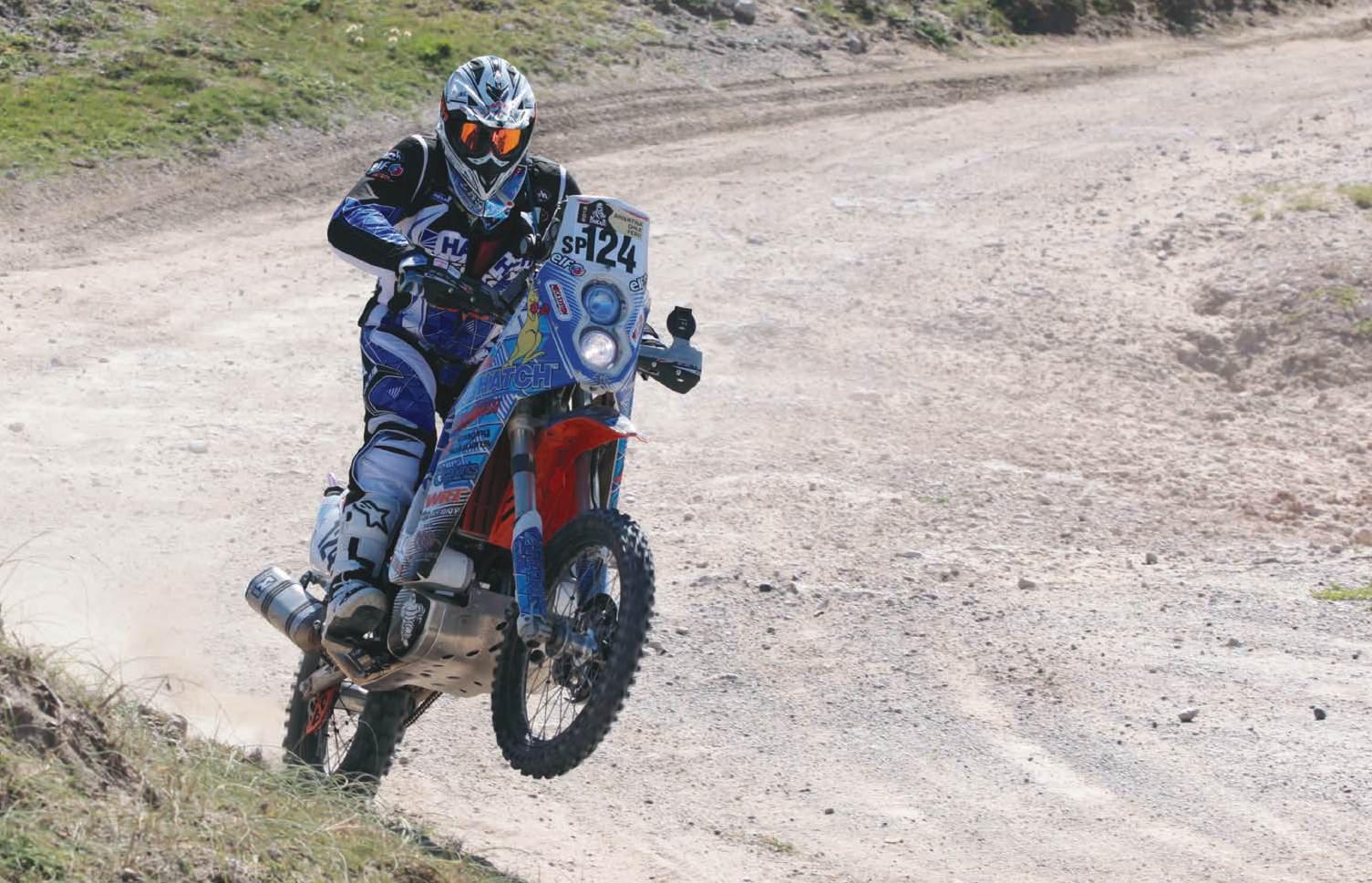



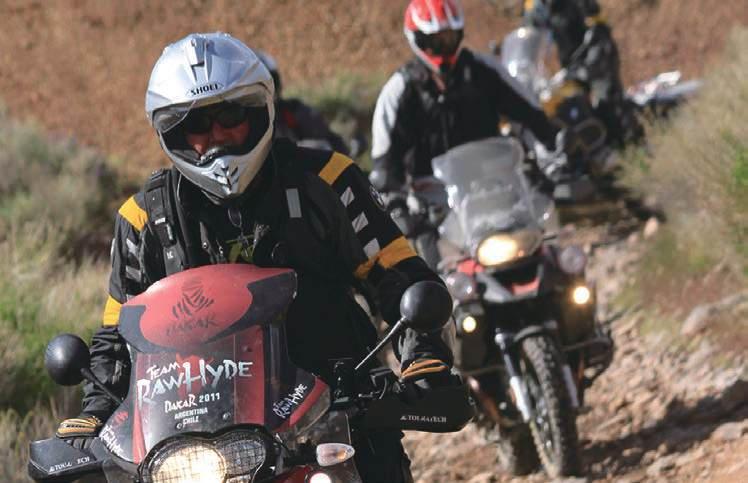
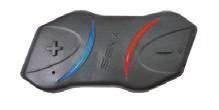





Day One Special – Mar Del Plata to Santa Rosa Del la Pampa 160km. Then liaison to 65km of beach sand and dunes, and then 800km liaison to the end of Day One. About 100km from the end of the liaison my rear mousse collapsed and the tyre lost a 100mm piece of sidewall. I limped to the end and thought my race was done on the first day. The cause was 40-degree temperatures, 800km of bitumen at 110kph, a non-Michelin rally mousse in the rear tyre and a tyre whose sidewall was too soft. In the end the heat buildup in the carcass of the tyre caused it to literally fall apart. Lesson One: Do not cut any corners on the Dakar.
The top guys like Cyril Despres and Marc Coma are extremely fit, mentally tough and wise, can navigate at speed, have many people around them to take care of planning and other incidentals, and that’s what makes them the best. When you see a guy like Coma riding a 690 Rally around his motocross practice track in Spain, you can see he has good bike skills. Or to watch Cyril do his roadbook and talk about the technique of carrying two or three sets of roadbook instructions in his head while he’s running at high speed and considering a vast range of other factors like fuel consumption, is the bike running okay and where’s the guy in front or behind me, is to get an inkling of how competent the front-runners are. For the average person it’s a real shock to turn up to a race and suddenly not only need to be fit and able to ride, but need to able to navigate and do a dozen other things while you’re riding and challenging your fitness. It’s a bit like rubbing your belly and patting your head while trying to balance on a tightrope while your wife asks you how was your day and then proceeds to tell you all the stuff you “need” to know. And you’d better be listening.
One of the realities is that there aren’t many races you can do to train for an event like Dakar. If you turn up at the Dakar and have never done
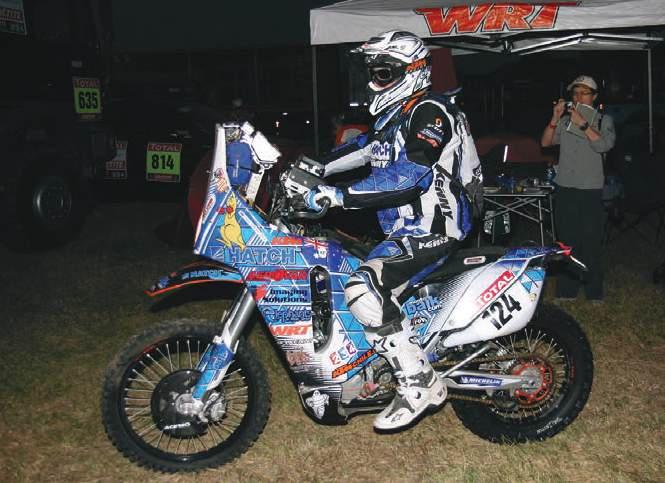
Above: Day Two getting under way. A 5.00am start. It was cold. Below: An oil pipe left off after valves being checked on Day One caused problems on the start line at Day Two. I had to strip the bike and fix it, add oil and then we could go. This pic is in the afternoon, explaining to the mechanic in my broken French what the problem was.
anything like it, it’s tough. If you do an Aussie Safari or some Cross Country Rally World Cup Championship races it’ll help a lot.
You can do a few things though. Your fitness is easy; you just need to get a good plan in place. And don’t kid yourself. No matter how fit you get, you’ll wish you were fitter as you go into the race. So get as fit as you can and make sure you don’t overtrain and turn up tired and worn out.
The riding, while it’s challenging, isn’t any harder than a good cross-country race. It’s the length of the event and the variations in terrain that make it so tough. You can find yourself in riverbeds for hundreds of kilometres, and after you think you’ve had enough, they just keep coming and coming. The organisers won’t give you a break: dunes, hard-track, rocks or whatever – you name it and you’ll ride it at some point in the Dakar. The only thing that’ll vary is how much of it you’ll ride, and if it’s over 40 degrees or below zero, raining u



Day 5 – Chilecito to Fiambala.
The desert and rivers were hot, over 40 degrees. Not far from where this picture was taken was the end...the end of the stage and the end of my Dakar.
or snowing or extreme in one respect or another, you’ll be expected to cope.
This variation and length of terrain, mixed with the exposure to the fluctuating weather, is where the race is different to others. The challenge goes on for days on end, and the next day isn’t predictable. You just ride and accept what’s thrown at you, and enjoy it. It’s all new and unknown and every element of your ability and preparation as a rider is tested.
After about three days you start to fall into the rhythm of the race and get used to the late nights,
questionable food, stinky showers, fatigue, constant noise of generators while you’re trying to sleep, the heat and the dust. It starts to become normal.
As this happens things begin to get easier and you find queuing for fuel is not so bad and waving to the thousands of spectators is nice. Being treated like a celebrity starts to feel not unusual and you do start to enjoy it. You also get to meet some nice people.
As you race you meet some of the best riders in the world and you see how, even in this environment, they’re not beyond sitting down beside you at dinner, having a chat and generally just being ‘regular
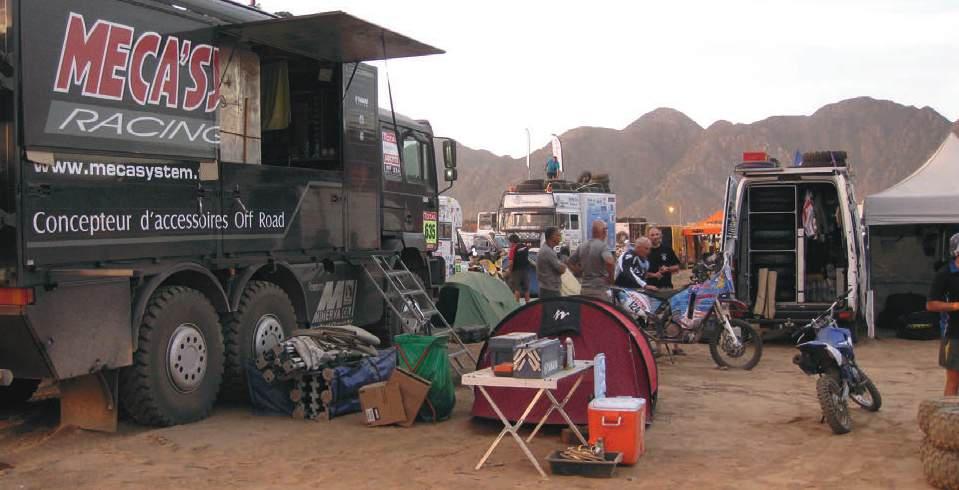
people’. This sport seems to breed a camaraderie that’s a little unique, probably due to the fact that at some point in time any one of us may need help from the next competitor to finish this race, but also due to the nature of being exposed to the elements.
All in all you could equate the Dakar to a circus: it’s a collection of performers engaged in dangerous acts every day, entertaining an audience in each location and then moving on hundreds of kilometres the next day. The sheer size of the circus and the logistics are incredible. To bring all of these people halfway around the world and then travel 9000km across some of the toughest terrain there is, and to do it safely and with no sense of panic, is amazing.
This in itself opens up the other realities of the Dakar.
It’s the biggest motorsport event in the world. It runs for 14 days, travels 9000km and moves thousands of people, and it’s only when you see it up close you understand how special
Left: The morning of Day Five – Chilecito to Fiambala. The support crew were ready to go, talking to the mechanic about the new forks and the other stuff that was done overnight. This was known to be the killer stage of the race and it was expected to take out a lot of riders.
it is. I believe that’s why, when you’ve been once, it’s very hard not to want to go again, and it does call you to return each year.
A heated discussion I first got interested in the Dakar in 1979, but only entered the race for the first time in 2012. The pressures of work kept me out of 2013 event, and I was fired up and ready for 2014, right up until health issues got in the way.
Now it’s full-throttle preparing for 2015. Once you’ve got the bug, you’ve got the bug!
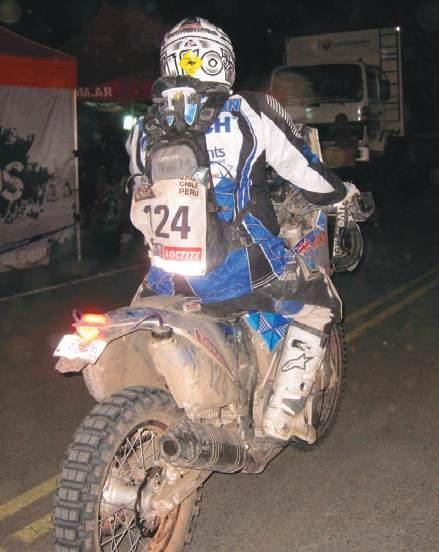
My own reality was cut short in 2012 with an engine failure in the sands of Fiambala, one kilometre from the end of a Special. That one kilometre may as well have been 1000km. With an engine that wouldn’t run and 140km after the end of the Special to get to
Above: Day 4 – San Juan to Chilecito. I was very late in to service. I’d been up since 4.00am, and had a failure. One fork-leg damper rod came adrift and after four falls in a river bed, I worked out something was wrong. I had new forks for the next day.
In 1977 French bike racer Thierry Sabine got lost in the Tenere Desert during the Abidjan-Nice Rally. During this time he decided desert would be a good location for a regular rally, and organised a route starting in Europe, continuing to Algiers and crossing Agadez before eventually finishing at Dakar.
He came up with a motto for his inspiration: “A challenge for those who go. A dream for those who stay behind.” In December 1977 he arranged an edition of the race with the start in Paris and the finish line in Dakar. He spent the rest of his life organising The Paris-Dakar.
Sabine was killed when his Ecureuil helicopter crashed into a dune in Mali in 1986.
Over nearly 30 years, what is now The Dakar Rally has become a legend of its own, and finishers can claim to have conquered one of man’s great modern challenges. , , ,
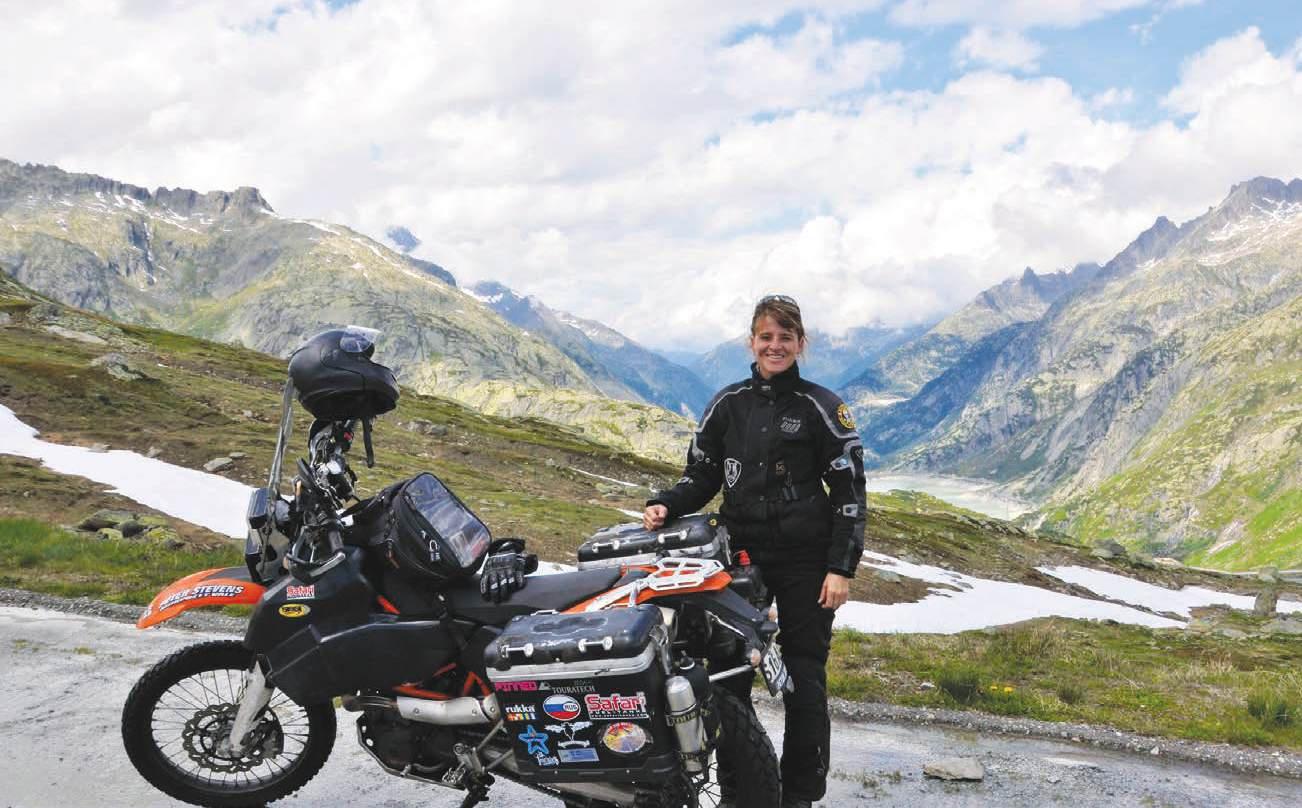
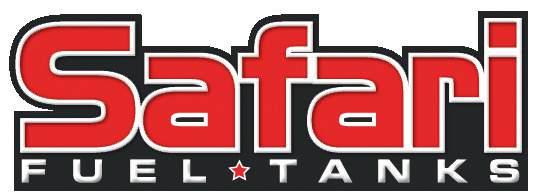
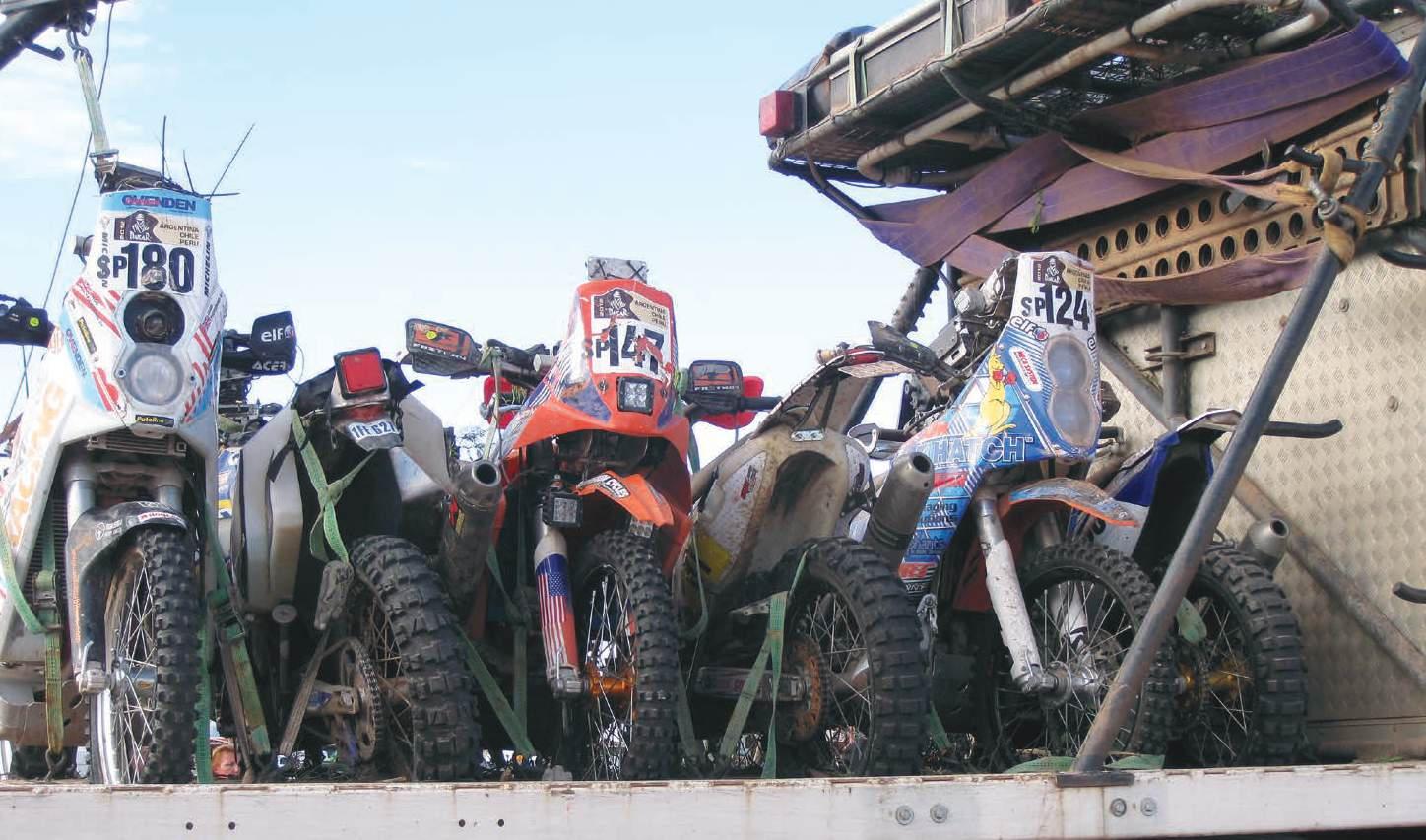

Above: Day Six – The camion balise (sweeper truck) with my bike on it…and a lot of others.
Right: Day Six – Fiambala. I’d been awake since 5.00am and this was after being picked up in the stage by the camion balise (sweeper truck) a kilometre from the end of the Special. I was taken 240km back into the stage to pick up other riders and then change vehicles. I was in an ambulance heading back to Fiambala when, at 3.00am we got stuck in the stage. The 4x4 bogged and we waited three hours for the same truck I was taken out of to come and pull us out of the bog. We then backtracked to where I was originally picked up from, to pick up another rider. Then we drove the kilometre to the end of the Special and then 140km of tar to Fiambala.
service – and no help allowed – my Dakar was done.
The reasons for the dead engine were simple: a $2.00 tee piece in the cooling circuit had burnt from the
inside out and in doing so had dumped all my coolant. I’d fixed it and got going again, but the damage had been done.
Many months later I pondered how that could’ve happened and came to the conclusion that it wasn’t the failure of the one part, but a series of failures: the failure to buy the larger radiators that would’ve kept the bike cooler, the failure to insulate the fuel lines to stop the fuel from boiling in the heat, making me have to stop and wait for the bike to cool so I could ride in the heavy sand. That led to delays that, in turn, put me further back in the pack and forced me to ride in a lot of dust. That led to dust getting into the engine and so forth.
In short, I wasn’t well enough prepared and I was caught out by the Dakar.
Looking back, there are a few things that do stand out. When the engine stopped I wasn’t tired, so my fitness training had paid off. I hadn’t really had any trouble with the terrain we were riding, so my skills were
okay. I hadn’t had any navigation issues, so my navigation training had paid off. In general, I was having fun.
It was only the fifth day, but I was okay and had settled into the race.
The mechanical failure left me with a sense of being cheated, even more so when, after returning home and stripping the engine, I found it was all fine. The actual fault was a wire that had rubbed through and was shorting on the frame, effectively working like a kill switch.
I could only suppose that I wasn’t thinking straight and probably should’ve had a rest and something to eat and drink. Maybe I would’ve found that fault and gone on to finish.
But hindsight is perfect vision, and I now know what the reality versus the dream was of my Dakar. The reality was a DNF. The dream is I still want to complete the event, and that’s the Dakar. No matter how much you try not to think about it, it always calls you back. It’s the last great motorcycle adventure in the world and it keeps calling you.

A bunch of biking songs – that is, music about riding, rather than to ride to – that includes usual suspects and some you don’t know but perhaps should.
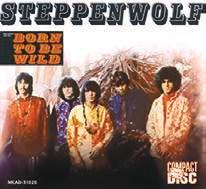
Steppenwolf
It’s practically written into the contract that any compilation of biking songs starts here. Furthermore, virtually every ad depicting riding –particularly toddlers on pushies, for ironic effect – must likewise be underscored by Born to be Wild thanks to its inclusion in the soundtrack to Peter Fonda’s 1969 countercultural masterpiece Easy Rider. Although the lyrics clearly suggest it to be about another activity entirely that may also include ‘riding’. It will crop up in further entries below.
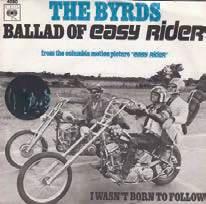
The Byrds/Roger McGuinn
PeterFonda had in fact approached Bob Dylan to deliver the theme to Easy Rider
According to the story, Dylan declined, instead scrawling a verse or so of poetry on a napkin and advising Fonda to hand it to Roger McGuinn of the Byrds as “he’d know what to do”. McGuinn did indeed: he wrote the rest of the song. It’s about another recurring motorcycle theme – freedom, riding, being at peace. McGuinn’s solo recording featured in the film’s soundtrack; the hit version was a re-recording by The Byrds. Note that traditionally, an ‘easy rider’ is an expert horseman. Motorcyclists are their modern equivalent.

Jasper Carrott
Yes, it’s a novelty song taking the mickey out of the traditional biker ballad, the twist being the replacement of the heavy-duty ride with a safe and economical, low-powered, two-wheeled contraption known as a moped. Before you dismiss it, remember: Funky Moped was a mid-’70s top-five hit in Britain and Jasper Carrott was himself quite a hit in Australia thereafter, frequently visiting and performing on The Don Lane Show during the late-’70s. Comedy lovers also love Carrott because he begat other great musical parodies and comedic routines, as well as daughter Lucy who played Dawn in the original British The Office

Muthafukka on a Motorcycle –
Machine Gun Fellatio
Speaking of ‘novelty songs’… it’s hard not to love Machine Gun Fellatio, a carnivalesque troupe of musicians whose every recording and performance – and, indeed band member, given names like Chit Chat von Loopin Stab, Bryan Ferrysexual and of course KK Juggy – reeked of fun. KK Juggy provides lead vocals on this number, from their debut album Bring It On. Perhaps not Ivor Novello material, the ditty – inspired by something someone sang at a house party thrown by one of the band – is a lot of fun. Meanwhile KK Juggy has reverted to her real name, Christa Hughes, and even recorded an album of jazz standards with her dad, the legendary Dick Hughes (who used to spend days working as a journalist and nights playing jazz venues).
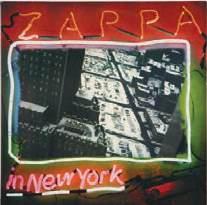
& Beer –Frank Zappa
In which the American composer and rock’n’roll orchestra leader rewrites Stravinsky’s The Soldier’s Tale – about the Devil fooling a trusting man out of his soul – as an every-day epic featuring a biker, his buxom wench and their intention to get ripped at the top of the mountain with a handful of ‘downers’ and cans of beer. The negotiation gets a little more heated in Zappa’s reading: “Blow it out yer ass, motorcycle man, I’m the Devil. Don’t you understand?!” the Hornéd One insists. Although no studio recording exists, there are a number of impressive live performances, the first of which appeared on the 1977 Zappa In New York album. An earlier prototype, Chrissie Puked Twice, came to light more recently as part of the Philly ’76 set.
You know we left out key songs you always carry with you when you’re on your bike. From next issue we start looking at rider playlists – the good, the bad and the downright embarrassing.

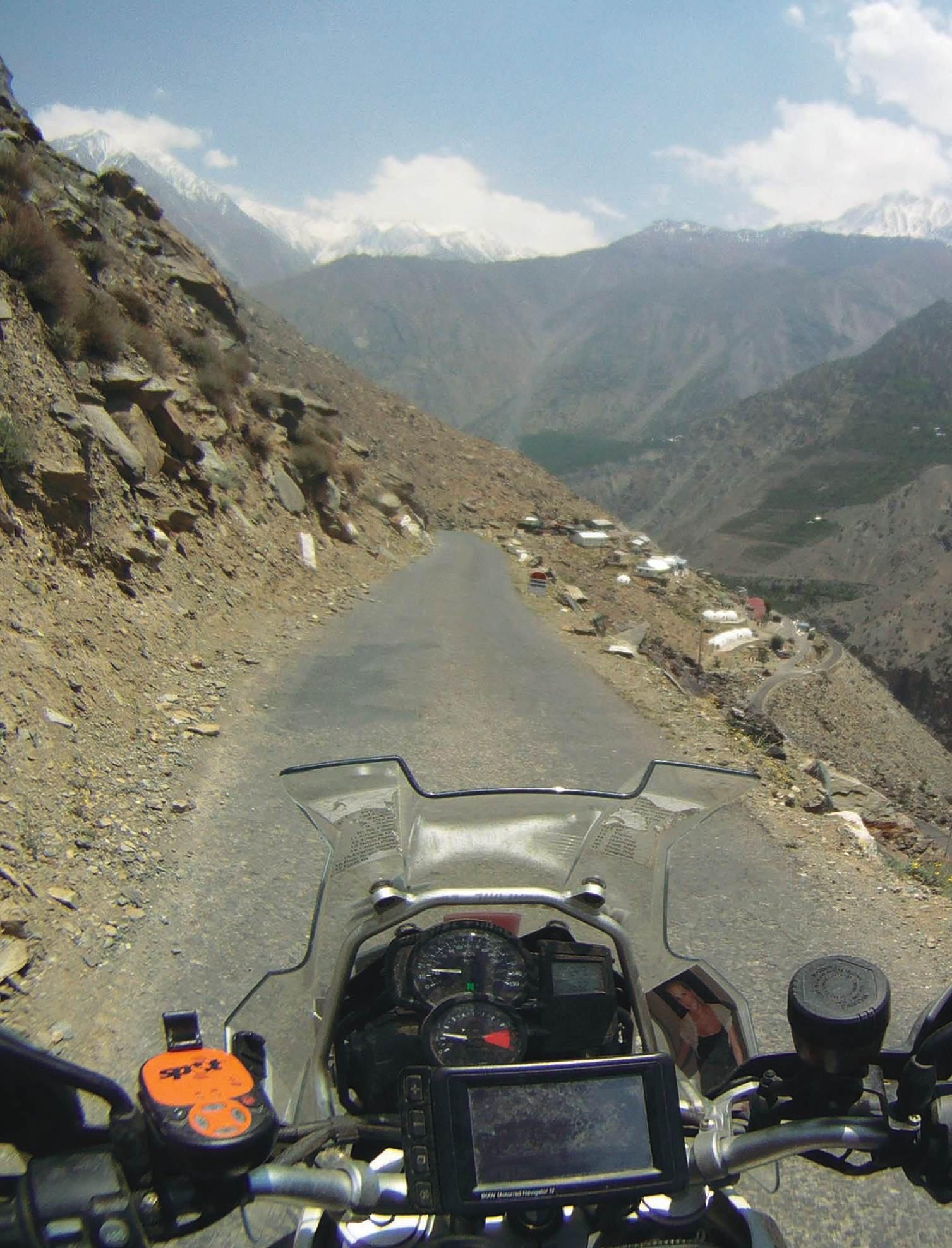
Covering 35,000km through 27 countries couldn’t be that hard, Nic Cuthbert figured. But for someone who’d only been riding six months and barely set foot overseas, maybe it could be.
Words and images: Nic Cuthbert

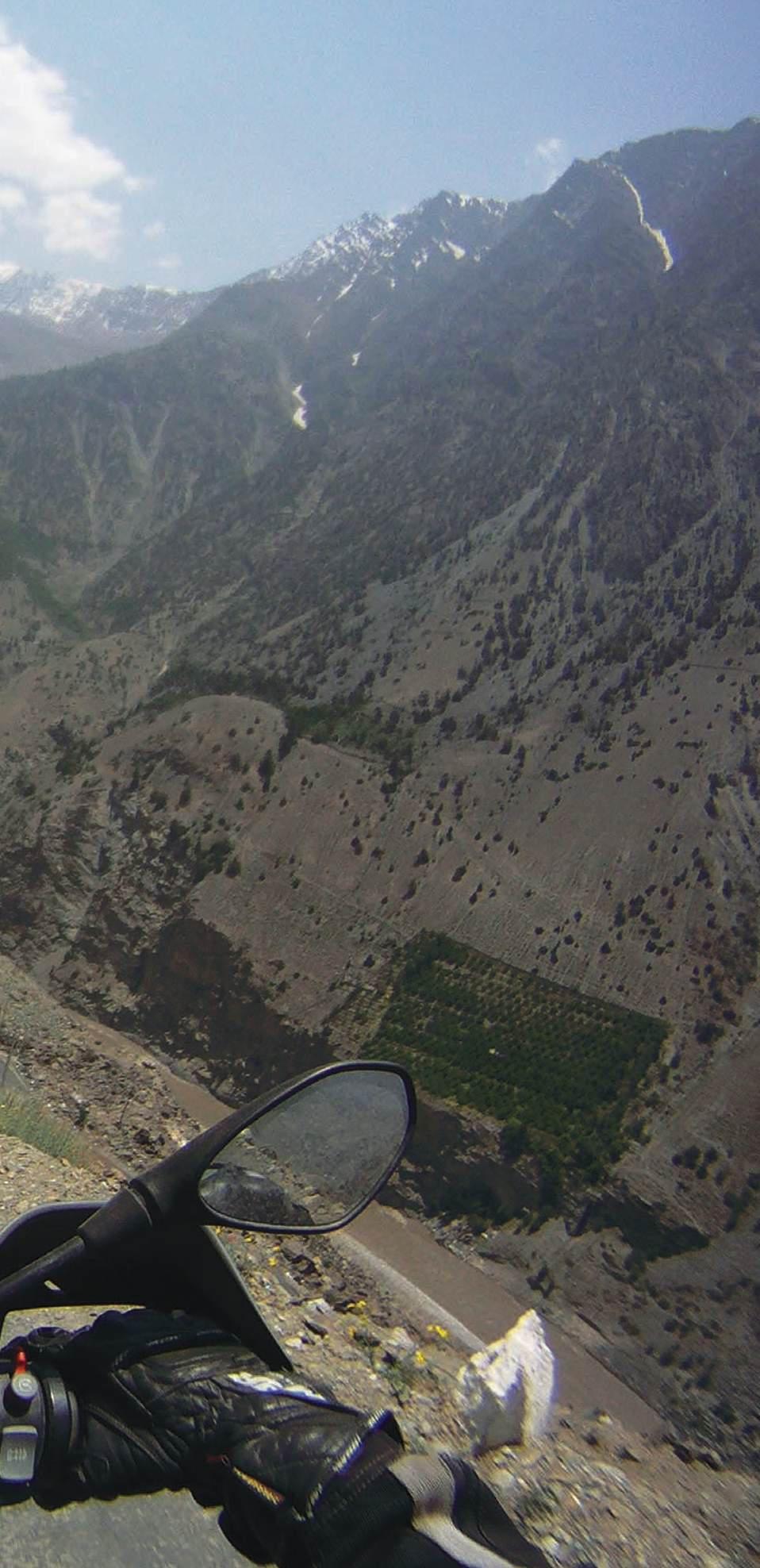

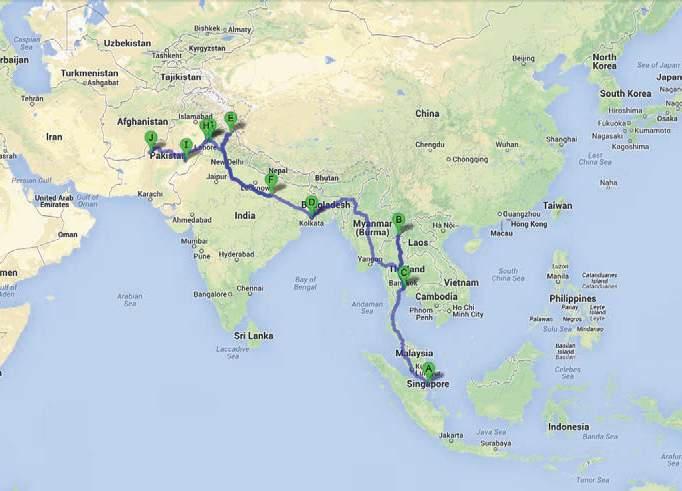
ITop right: Big stretches of desert were easily dealt with by the BMW. Main: Some of the mountain roads were tight and didn’t offer much in the way of guardrails or cat’s eyes. Look down in the bottom-right of this pic to see the road leading up.
was hugging the mountain on a narrow rocky road, crawling around a blind turn on a sheer, 600-metre cliff face with my front wheel centimetres from the edge, and it gave me an uneasy feeling. Kunzum La Pass in the Indian Himalayas isn’t everyone’s cup of chai. Riding at 3500m elevation with the constant threat of avalanche, and passing out due to acute mountain sickness a real possibility, tests a man’s courage. For me the infamous road, documented in the History Channel’s Ice Road Truckers; World’s Deadliest Roads was all that it was cracked up to be and more. But that’s not where this story starts.
From the beginning
I was 12 months into a posting in Malaysia when I started to get itchy feet again. I’d been on the move for the last couple of years with time on the Gold Coast, six months riding a pushy around Australia for charity and six months living the dream in Broome. But what next, I wondered? And how?
After a short time I’d begun thinking like the Malaysian locals and was getting around on two wheels, firstly on a 110cc moped like everyone else, and then not long after, my first proper bike: a Yamaha Virago I named ‘Harriet’. I began doing weekend trips
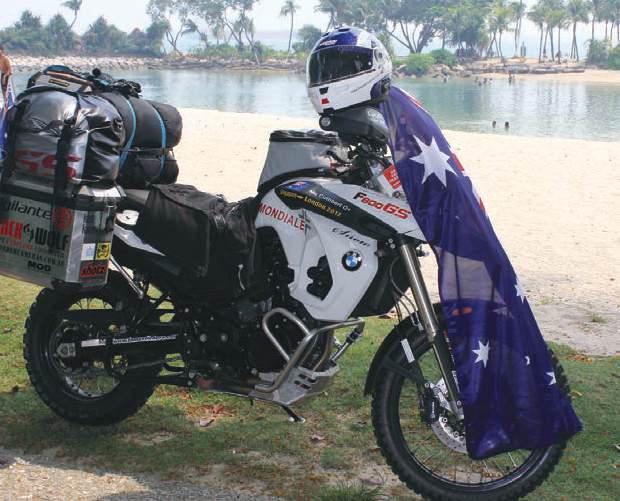
around the Malay Peninsula, mainly down to Singapore (about four hours’ ride), but also north to Penang, Langkawi and beyond to the Thai border. Before long I started questioning how far I could actually go. Cambodia? Vietnam, perhaps? Why not the UK?
I quickly became an armchair enduro expert, familiarising myself
with terms like ‘panniers’, ‘carnet de passage’, ‘overlander’ and ‘adventure touring’. It was November 2012 and I gave myself until March the following year to set off on the adventure of a lifetime: Singapore to London, solo on a bike.
Identity born
Planning a big adventure, as readers of this magazine may know and I supposed at the time, means a lot of things, but there’s always a start point. Although I had a destination I needed a machine to get me there. I rode both the 1200 and 800 GS from BMW, read half the Interweb and put hours into thinking long and hard about it. Although I could see benefits in both I went with a three-month-old demo F800GS from the UK. Being a demo meant I was able to:
r Get it cheap, r Get it specced out OEM just how I wanted it, and r Get a carnet de passage (CDP) issued by the RAC UK.
For those unfamiliar with a CDP, it’s basically a passport for a bike or equipment that allows you to keep temporarily importing and exporting it in and out of countries all the way back to its home port. I was able to get the bike serviced in Malaysia before I left, meaning it wouldn’t need going over for another 10,000km. That was handy, because the next nearest BMW dealer was in Delhi, India.
Once I’d bought a bike much of my preparation centred on route planning, obtaining visas and – seeing I’d decided the project would be in support of international aid agency, ActionAid – putting sponsors together. And so A2B was born.
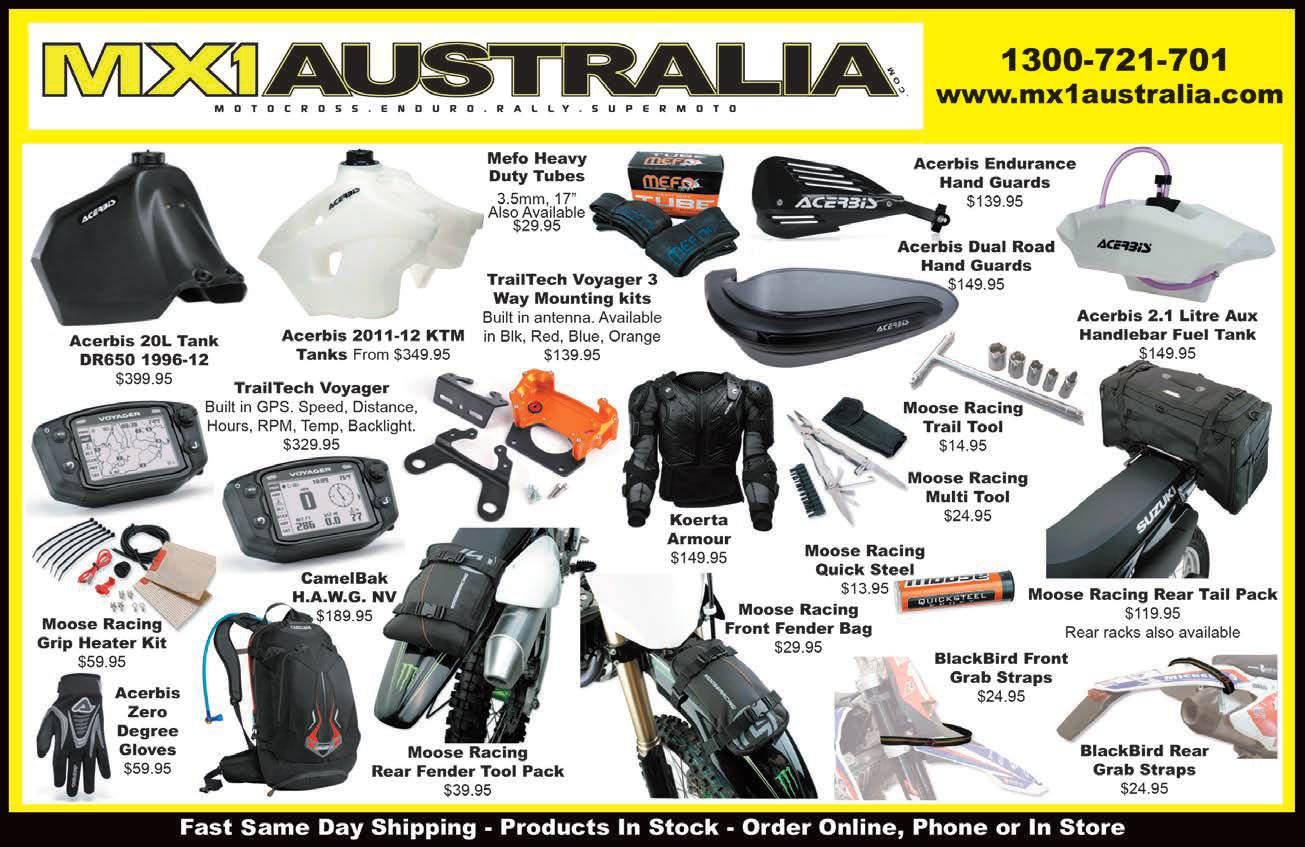
Six months after hatching the idea and just six days after getting my WA bike licence (and therefore my international licence) I was on the start line. Bristling with tension for the unknown, excited beyond belief and committed to making it happen safely, I rolled ‘Snow’ – my F800GS – out of Sentosa Beach, Singapore, the southernmost tip of the Asian continent. Ahead of me was a very long road indeed.
The first week or so was fairly easy going and I quickly settled into a routine of ride-eat-sleep. For these first few days I had the companionship of close friends Matt and Sarah, and there was also a big send off from crew and supporters at The Big Bike Shop in Malaysia.
The first couple of days also included my first proper border crossing – Malaysia to Thailand – a procedure I would become tirelessly familiar with, but never expert at. No two were ever the same, and I was

to do well over 30 borders by the time I crossed the English Channel.
The first hurdle of the trip was to come early in the piece when I tried crossing from Thailand into Burma at Tachilek in the far north, and it wasn’t a surprise.
I’d already been denied entry at
Mae Sot, and I knew before I left Singapore that it was always going to be a long shot to get through the country otherwise known as Myanmar. Although it was starting to open up to foreigners, all my research suggested I’d likely be denied a complete overland experience. After 1200 non-stop kilometres in 14 hours I was u
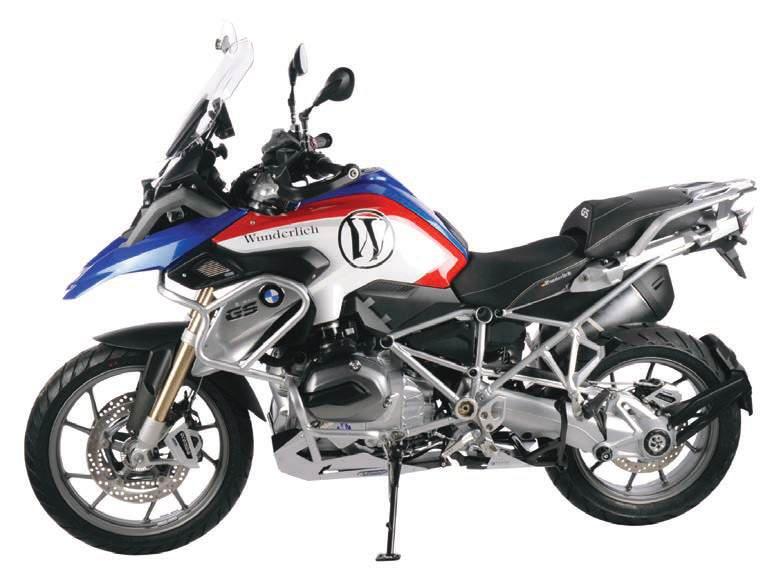
Singapore to London – solo. Part one.

standing in Bangkok International Airport trying to book myself and a sizeable amount of excess luggage onto a flight to Kolkata, India. It was clear no-one at Bangkok airport had a written procedure for this, but like most things in South-East Asia, where there’s will (and cash) there’s a way, and after three days of investigation, negotiation, trial and error I had a carpenter banging the last nail into a big box
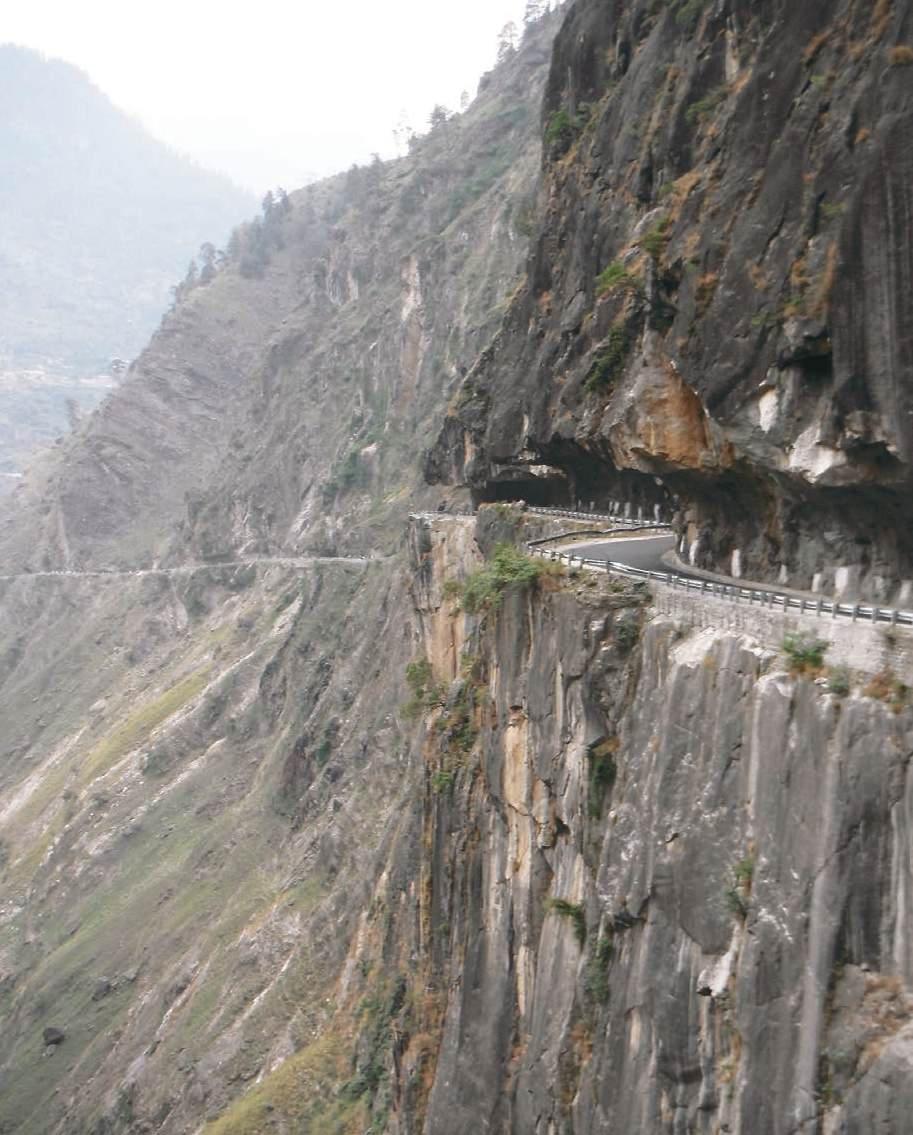
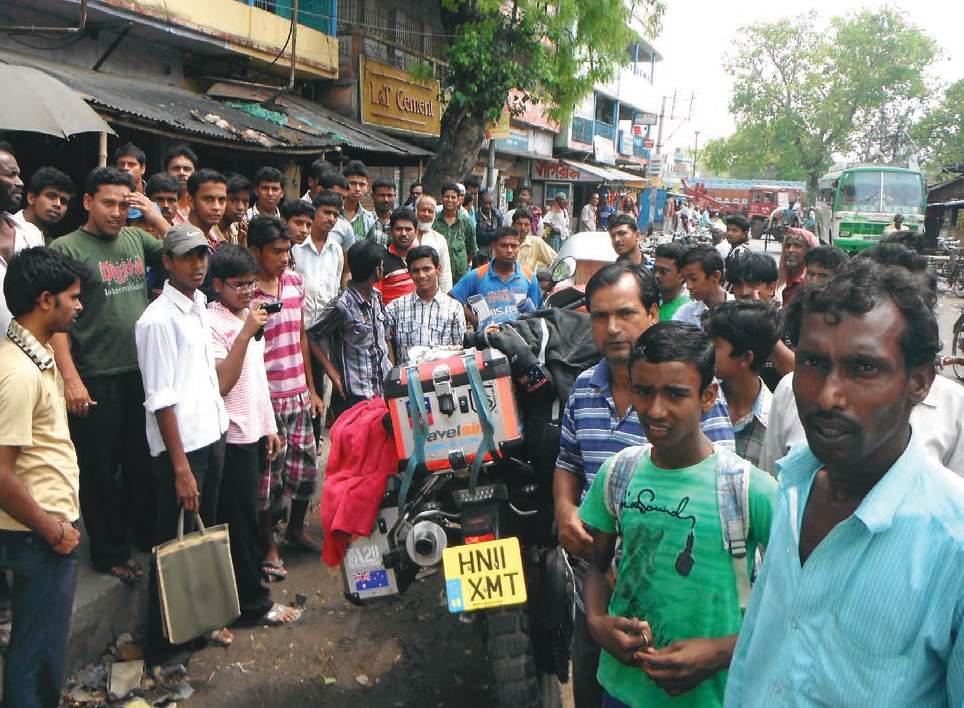
that would carry my pride and joy across to the subcontinent. The adventure had truly begun.
India could best be described as a lesson in life, and it’s true that most outsiders will never understand the complexities that make up life amongst 1.2 billion others. India included some of the highest points in the trip – like actually clearing Indian customs in the first place, but also riding over Kunzum La in the Himalayas. At 4590m it’s one of the highest motorable passes in the world. India, however, also included some of the darkest moments, like watching a small girl die slowly in the back of a tuk-tuk, coming over the India/Nepal border and sweltering in the heat. At the end of that same day, I was overcome by a mixture
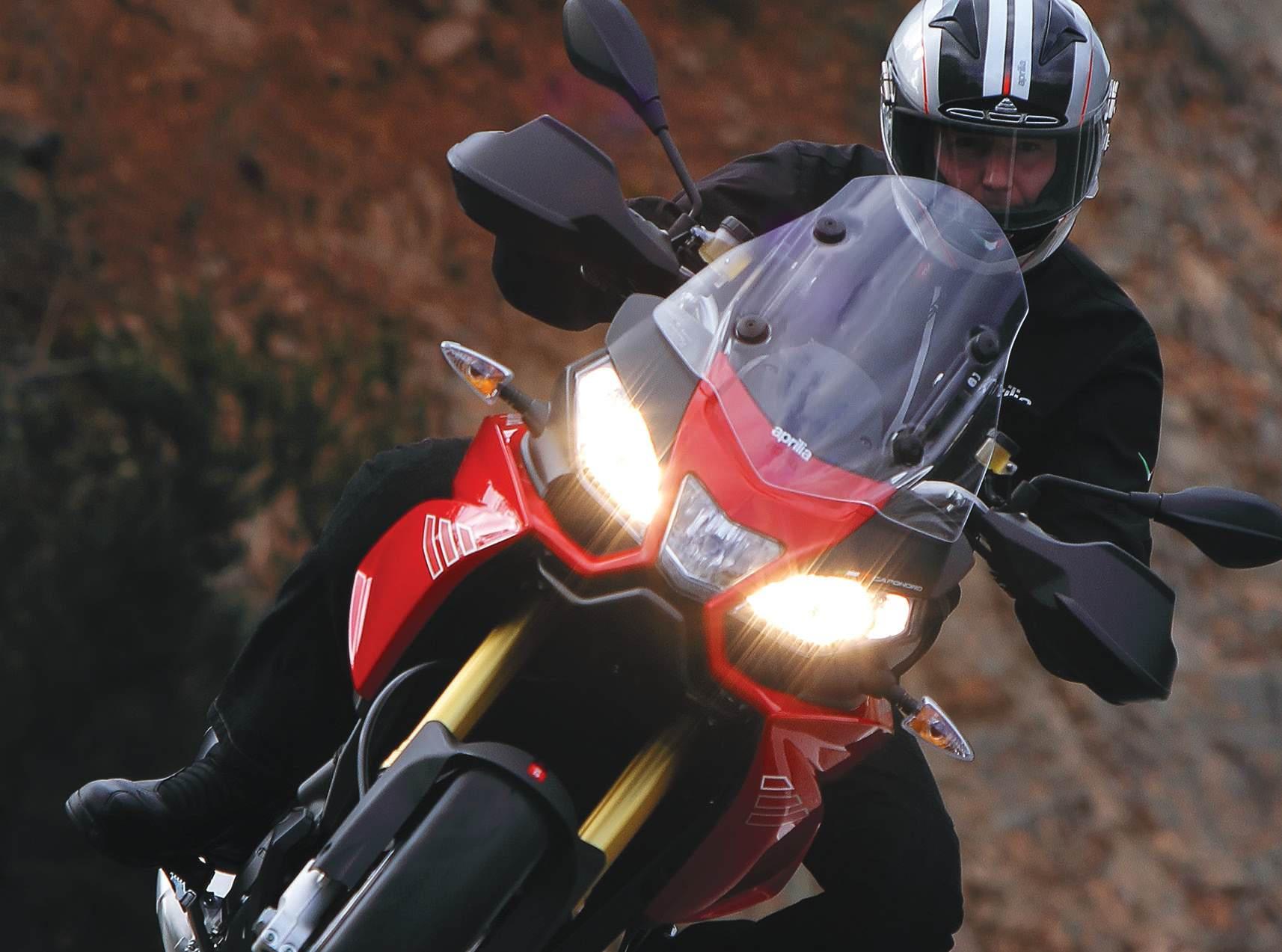

Scooters, Quads, Jet Skis, Trikes, Side x Sides and all the latest bikes on show, Accessories, Apparel plus related services & products, Huge accessories clearance centre, Info sessions right across the weekend on the QBE stage, Cafe Racer Flat Track & Bobber display by Sydney Cafe Racers, Special guests appearing right across the weekend, See live streaming from the riders on massive Super Screen, ‘Walk of fame’ Feature Bike Display And much much more!!! Enter onsite to win a Motorcycle Tour of Vietnam! Featuring Performances by





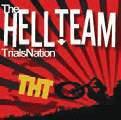

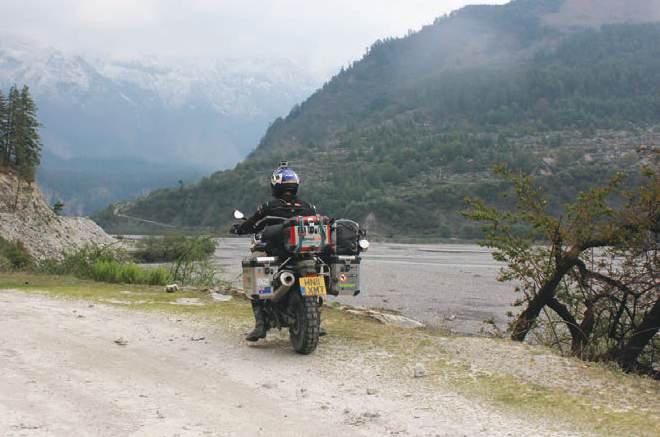
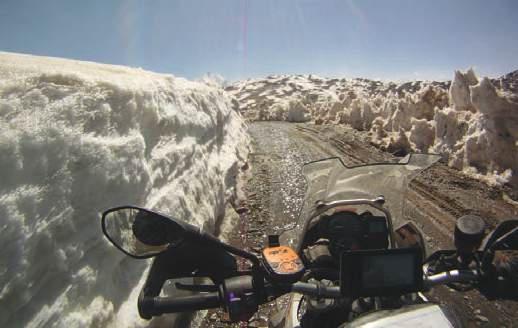
of exhaustion, dehydration and emotion, and passed out in the searing night-time heat, slumped over my bike in the backstreets of Varanasi. It took four days to recover, by which point inhaling the torrid smoke from burning human bodies became too much and I simply had to get on with the journey. India was always going to leave
an indelible mark on my consciousness, but as the border gate slammed shut at Amritsar I was glad to put it behind me and saddle up for what was going to be a challenging four-day crossing of one of the world’s more dangerous countries: Pakistan.
Pakistan heralded a change in pace. The vast stretch between Lahore in the east and the Iranian border in the west meant big distances, big temperatures and big unknowns in personal security. As it turned out, most of the last agenda item fell into place when I was visited by the Internal Security Service (ISS) on my second night in the country at the southern town of Bahawalpur. Perhaps this shouldn’t have been a huge surprise, but it explained why it took the hotel owner three hours to “…photocopy your passport, sir”. Two neatly, traditionally dressed members of the secret constabulary
appeared in reception to ask me questions about what on Earth an Australian was doing in southern Pakistan. Fortunately my time in India had taught me the knack of dropping the names of Australian cricketers.
“Yes,” I offered, “Ricky Ponting and I had dinner together just before I left, and yes I’m hoping to catch up with Shane Warne in London”.
The next day, after covering 684km in 58-degree heat through central Pakistan, I was scaling the Central Bhrahui Ranges at dusk. It meant riding the only road to Quetta, a flashpoint of sectarian violence and the site of a very recent smattering of mass killings between Sunni and Shia Muslims. It was also a vital point for the opium-smuggling trade out of nearby Afghanistan. Perhaps I should’ve been afraid, but I pushed on, nervously watching the sun set as high ridges grew on either side of the road and I started viewing the infrequent passing of headlights as a morbid threat. I eventually drew
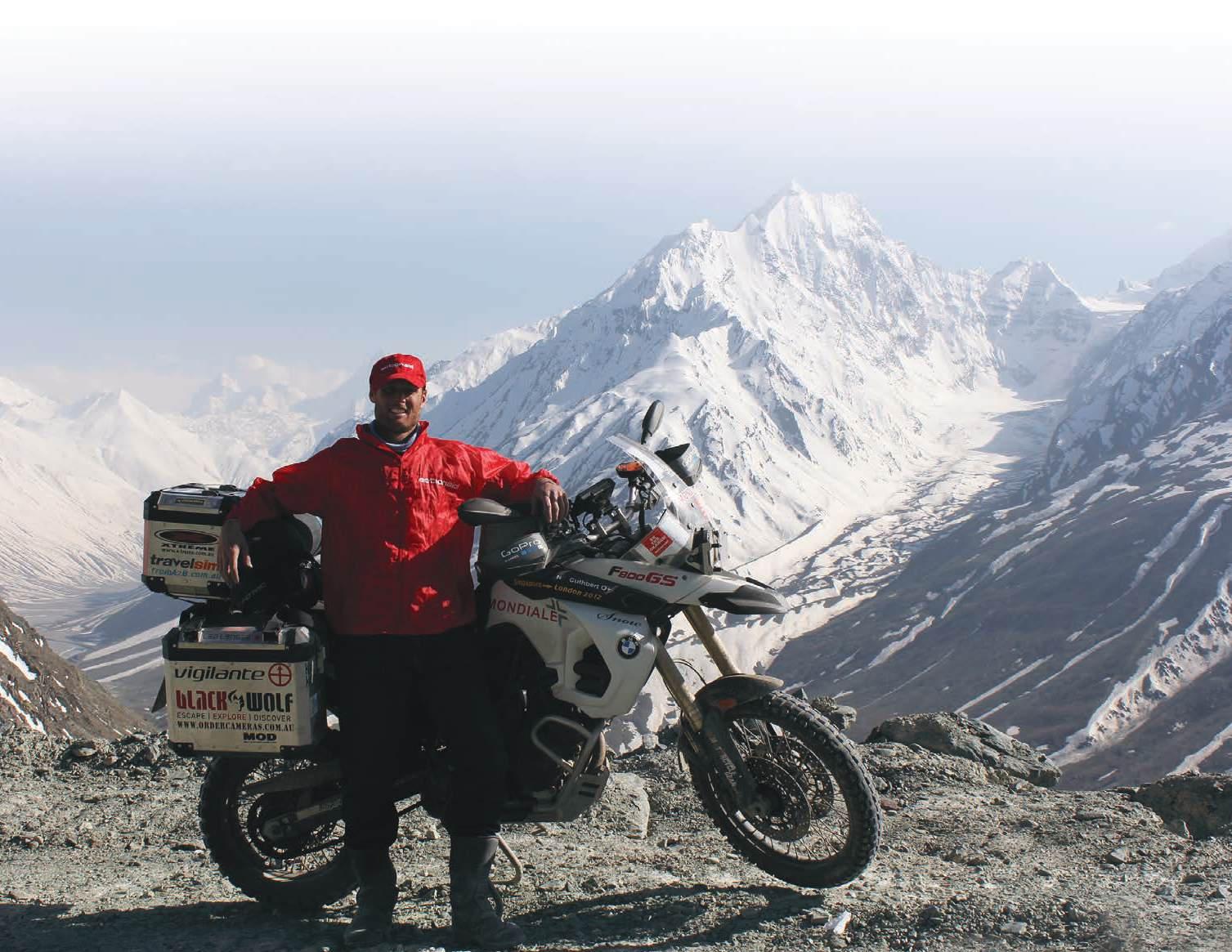
up at a checkpoint with questions of trust running through my head. At this stage of the trip I knew a uniform didn’t necessarily mean authority.
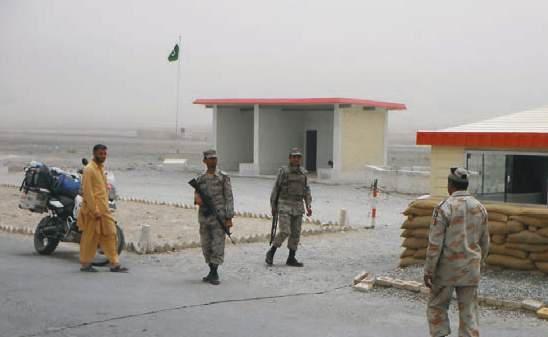
Four men with Soviet-era AK47s beckoned me off the road and by their various hand gestures and attempts to communicate it became obvious I’d be travelling no further that evening.
The gents helped me to quickly move the bike into a small but high-walled compound nestled into the side of a cliff. They pulled out a bed frame without a mattress and motioned for me to rest. I was exhausted and more or less passed out, especially after I could see, and was therefore safe in the knowledge that, they had a guard covering the high point of the ridge above the compound.
Later that night the guards woke me and offered me a traditional dinner, cooked in the ground like



damper and eaten with our hands around an open fire under a crescent moon. I couldn’t have felt more alive. A short while later I was again putting head to bedframe, this time having asked the guard next to me to point his gun the other way after he’d loaded it, cocked it and neatly placed it under a puffed pillow facing in my direction.




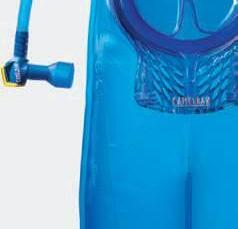


Top left: A remote checkpoint in Pakistan. Left: At least he was persuaded to face the barrel the other way.
Two days, a massive dust storm and 2200km under the protection of the Balochistan Military Police later I pulled up at the Pakistan border ready to tackle the next news headline: Iran.
End of part one
Nic’s attempt to make it to London via the deserts and perils of Iran, the exotic sites of Turkey and the historic wonder of Europe continues next issue.






















































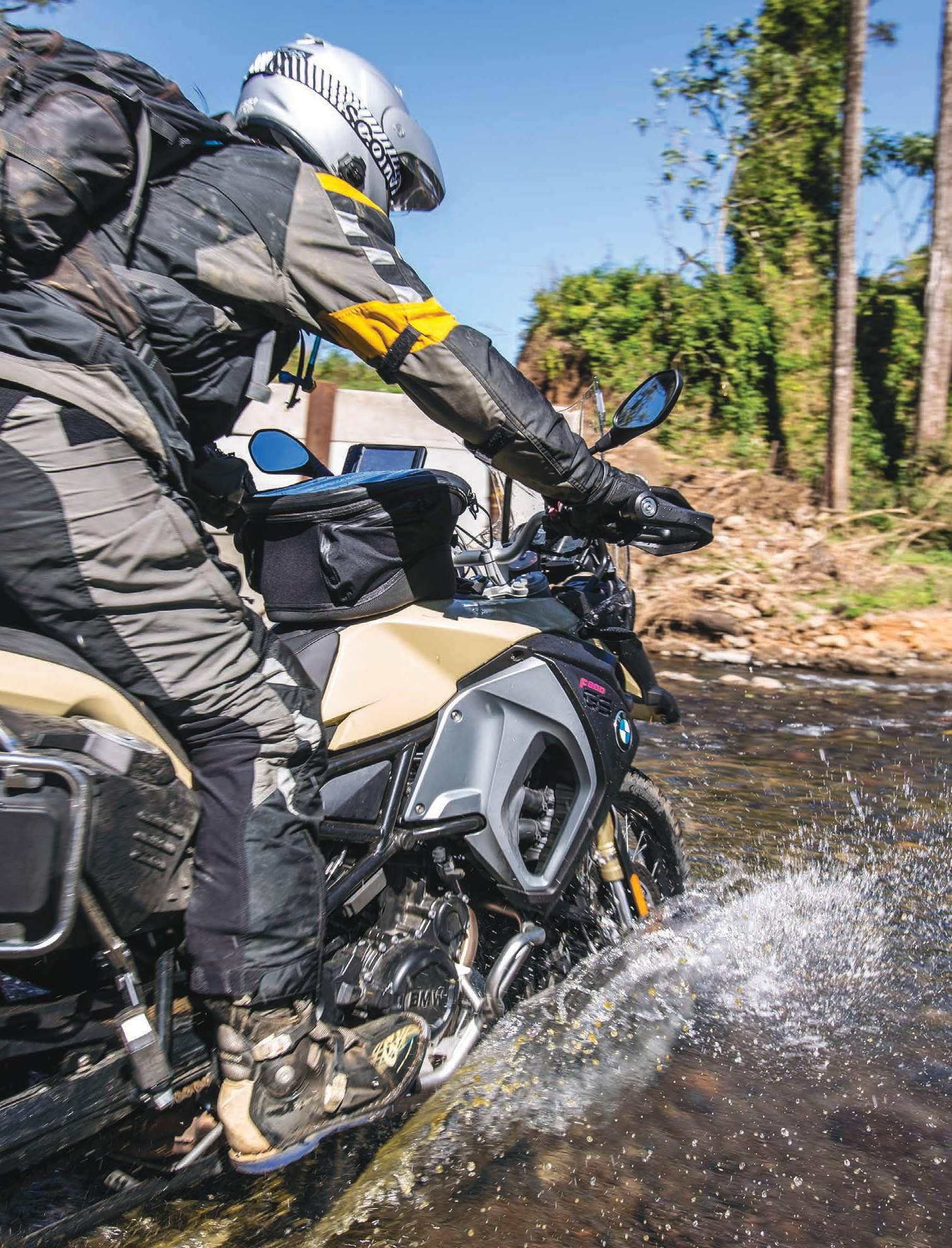
Despite a whopping 50 per cent increase in fuel capacity, it’s still a tidy and smooth-looking bike.

Improving BMW’s F800GS was never going to be easy. It was a great bike when it first hit dealer floors back in 2008. The motor was smooth and torquey, the bike was big and stable but felt slim compared to it’s big-brother 1200, and, being a BMW, it was beautifully engineered and very quiet and comfortable.
What could be done to improve a bike like that?
Offer it in an adventure format, of course. Bigger fuel capacity, more rugged crash protection, boosted lighting and more technological gadgetry.
The new gear on the 2014 F800GS Adventure works, and whether your riding is commuting or death-before-DNF adventure epics, the additions to the standard 800 are big winners.
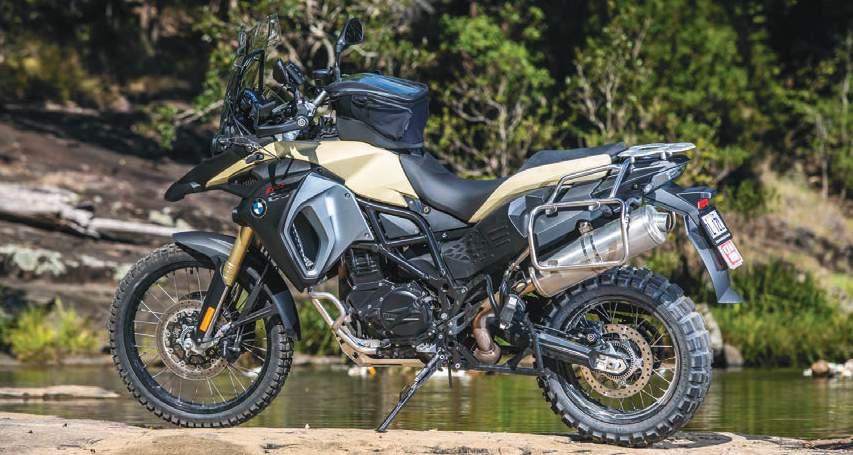
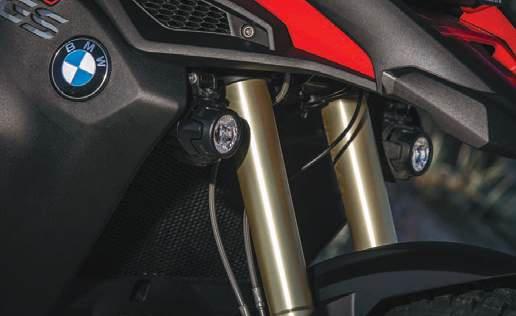
Above: The LED spotties are awesome. After a couple of night rides on the 800 Adventure, we’re not looking forward to riding bikes that don’t have them.
The parallel-twin, liquid-cooled, fuel-injected 798cc powerplant is still the heart of the bike, and it’s a brilliant motor. Somehow BMW has made the parallel twin feel like the boxer twin of the 1200. It’s turbine-smooth and torquey, and will deal with just about any situation with a minimum of fuss, driving through a six-speed box via chain to the rear wheel. The cable clutch is far from light by today’s hydraulic standards, but it’s far from heavy too. The clutch on our test bike was smooth with a nice, easy take-up and a progressive action.
Mechanically, the bike is pretty much the F800GS we’ve all been used to for a few years.
The changes to earn the Adventure badge are the interesting bits. First up, and a huge bonus, is a 24-litre fuel cell. It’s an under-seat tank, as usual, but it bulges out the sides a little, and in a great piece of design work it doesn’t interfere with anything. Its doesn’t even feel like it’s sticking out. Somehow the Beemer boffins have made it fit like it just belongs there, but it’s holding a whopping eight litres more than the standard tank, giving a realistic range of around 500km of mixed riding.
ABS is standard, and as always, it’s an ‘opt-out’ system. If you turn the key and start riding, you’ll have
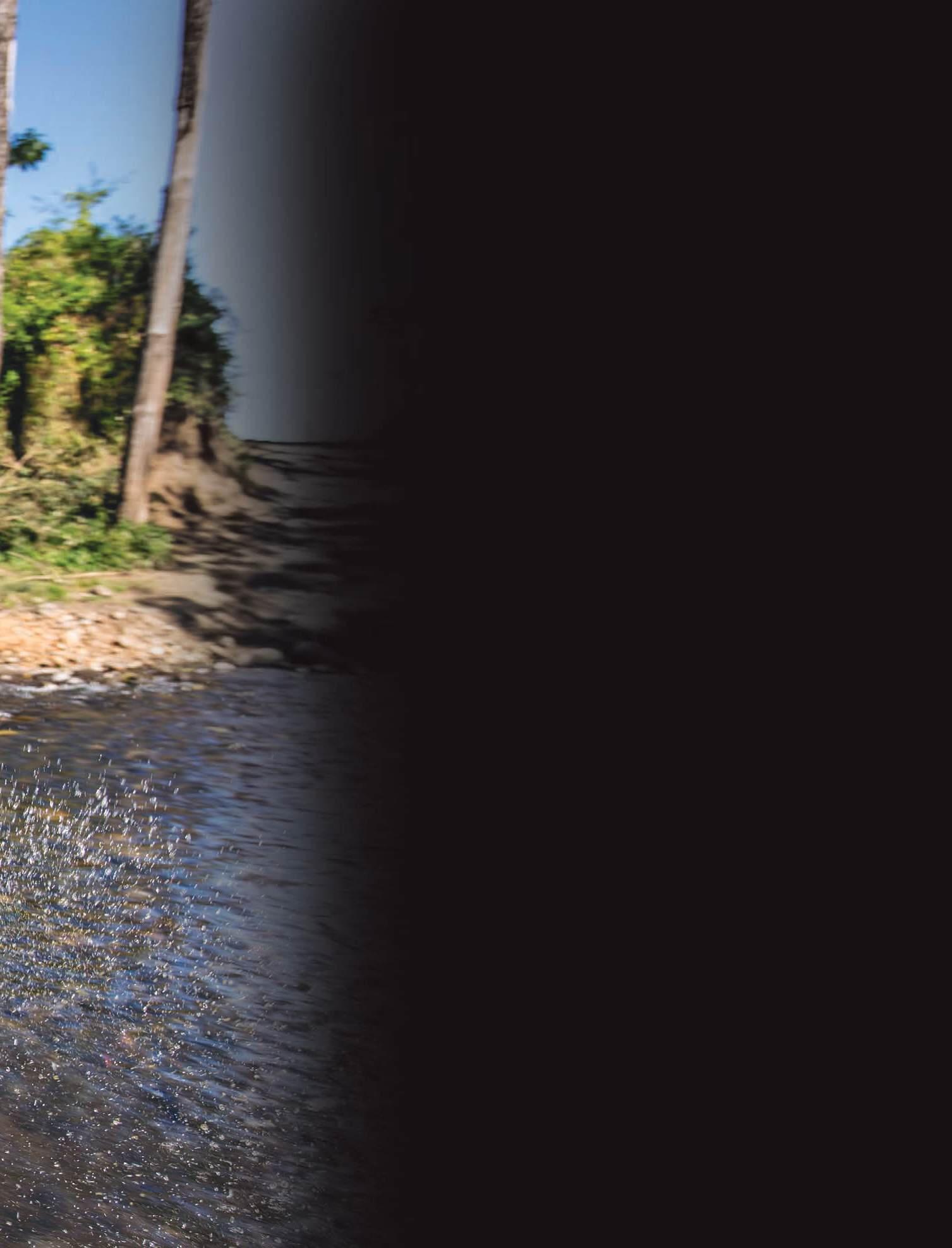

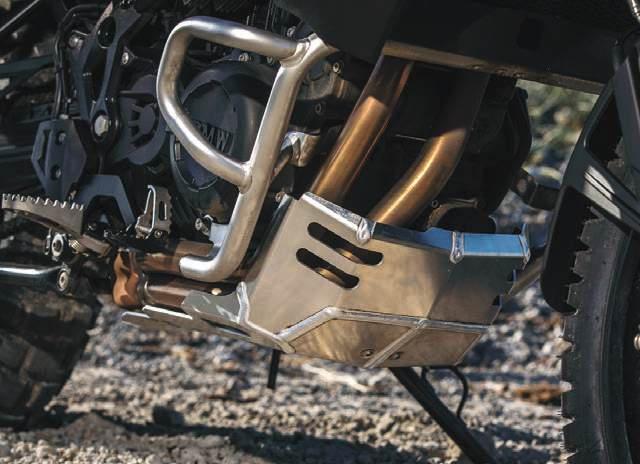
the ABS operating. If you jiggle the button on the left switchblock before you ride away, you can turn it off, but you have to make the decision and take the action.
A big screen, crash bars, pannier racks, a bigger bashplate and some superb extra lighting round out the basic adventure package.
There are a couple of optional extras available that were fitted to our review bike. On the dash they light up as ESA and ASC. ESA is Electronic Suspension Adjustment, and although it sounds all very exciting, it actually only alters the rebound damping of the shock. The three choices are Comfort, Normal and Sport, and they can be selected on the fly as conditions change. Preload is still a 30-second job of winding the small hand wheel on the right of the bike. No problem.
The other interesting factory option is ASC – Automatic Stability Control. It’s a traction control system that, as near as we can figure it, allows a kind of ‘medium’ setting between completely off and completely on.
According to BMW’s description the Enduro setting allows the rider to “increase the slip threshold”, which we figured means being able to hang the back out ‘a little bit’. It allows more aggressive braking, too.
It’s easy for good riders to turn their noses up at traction control and
Far right: A smooth, easy-to-use powerplant, no doubt about that. Left: Plenty of good protection goes with the Adventure badge. Below: It’s all there at the touch of a button. ABS on/off, electronic suspension adjustment, spotties and a heap of “normal” stuff.
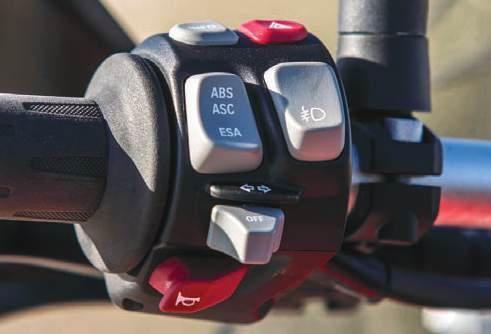
ABS, but we reckon if you’re being honest, it’s just too good to not use these days. It doesn’t matter how good a rider you believe yourself to be, there’ll still be times when there’s oil, ice or moss on the road or some knobber who’ll prop in front of you halfway around a roundabout, and that’s when those features can save you. On the road we hardly notice the ABS and traction control except when we need it.
Off-road is a different story, of course, but even then, towards the end of the day when we were feeling a little ragged, the traction control made things very easy as we attempted to pilot the 800 through some slippery single track. For sure, if we were feeling all full of ourselves we turned everything off, but there are times the systems worked well and made things a great deal easier.
The traction control was interesting, though. The BMW motor is so tractable we turned the ASC off and had a ball until we got a bit tired (after five minutes). Then the Enduro setting allowed us plenty of fun, but kept the rear of the bike well under control. The rear wheel can still light up to a certain degree, and the ABS will allow stronger braking for more stressed conditions, but the safety

factor is vastly increased, especially for a rider who may not be a national champ in the making. We can see that with a little more time to get used to the new settings we could become big fans.
The suspension on the 2014 F800GS is good. It’s about what can be expected from a good dualsporter these days. At sensible speeds it copes well and the action is smooth and progressive at both ends. Still, if you go launching off erosion mounds or smashing rocky creek beds at speeds, both ends are going to bottom out hard. It’s not an enduro bike, and for its intended purpose we thought it was well set up.
The electronic shock settings didn’t change our lives, but they did work.
We started off with a heap of bitumen, so we left everything on, selected Road, and off we went.
We had a ball, too. The motor isn’t a banshee screamer like a four-cylinder sports bike, but it does a damned good job of smoothing along the tar at legal – or maybe a little better than legal – speeds.
Then, when we hit the dirt, we pounded along having a good time until, after a few hours, we started to feel we were being treated a little harshly. It took us a while, but finally

Above: The new Adventure version of the F800GS is a very capable dualsporter indeed.
the light dawned, and we selected the enduro setting. It wasn’t chalk and cheese, but our ride definitely became smoother. When we hit the bitumen again we tried messing about with the settings, and sure enough, on the road in Sport mode the 800 is definitely more precise.
Not too many brands can match BMW for sheer comfort. The tall screen and wide, comfy seat on the 800 Adventure combine with an incredibly smooth power delivery and excellent handling manners to make this a supremely comfortable dualsport bike. We know there’s a bit of web chatter about the throttle responding too sharply in the initial application, but we just don’t see it. It’s snappy, but all fuel-injected bikes seem to have their quirks, and this one we adjusted to, and forgot about, very quickly.
On the tar or on the dirt, it’s easy to cover whopping long distances with only very minimal
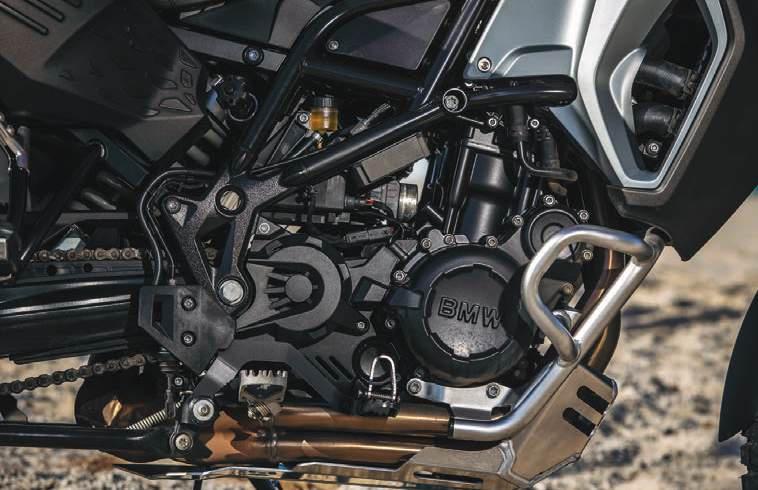
fatigue. Things like heated grips and good shelter from windblast play their part, but the way so little effort is required to get the bike to do anything is the biggest factor. It’s a real pleasure to ride, and for riders around the 175cm mark, the seating, standing, ’bars/’pegs/ seat arrangement is going to be close to spot-on. Handling is good, especially off-road when the pace is on a little and the rider stands up and gets aggressive. As the sun goes down those little spotties fire out an amazing spread of clean, white light that’s a huge improvement over the squint-and-hope technique we’re used to.
The base model Adventure sells for a recommended retail of $18,550. Our optioned bike would go for a smidge over $20,000, and we reckon the value was easy to see.
The 800 may not suit the diedin-the-wool fans of the 1200 because it doesn’t have the outand-out horsepower or the full-blown tech aids of the big girl, but hoo-aah! It suits us.

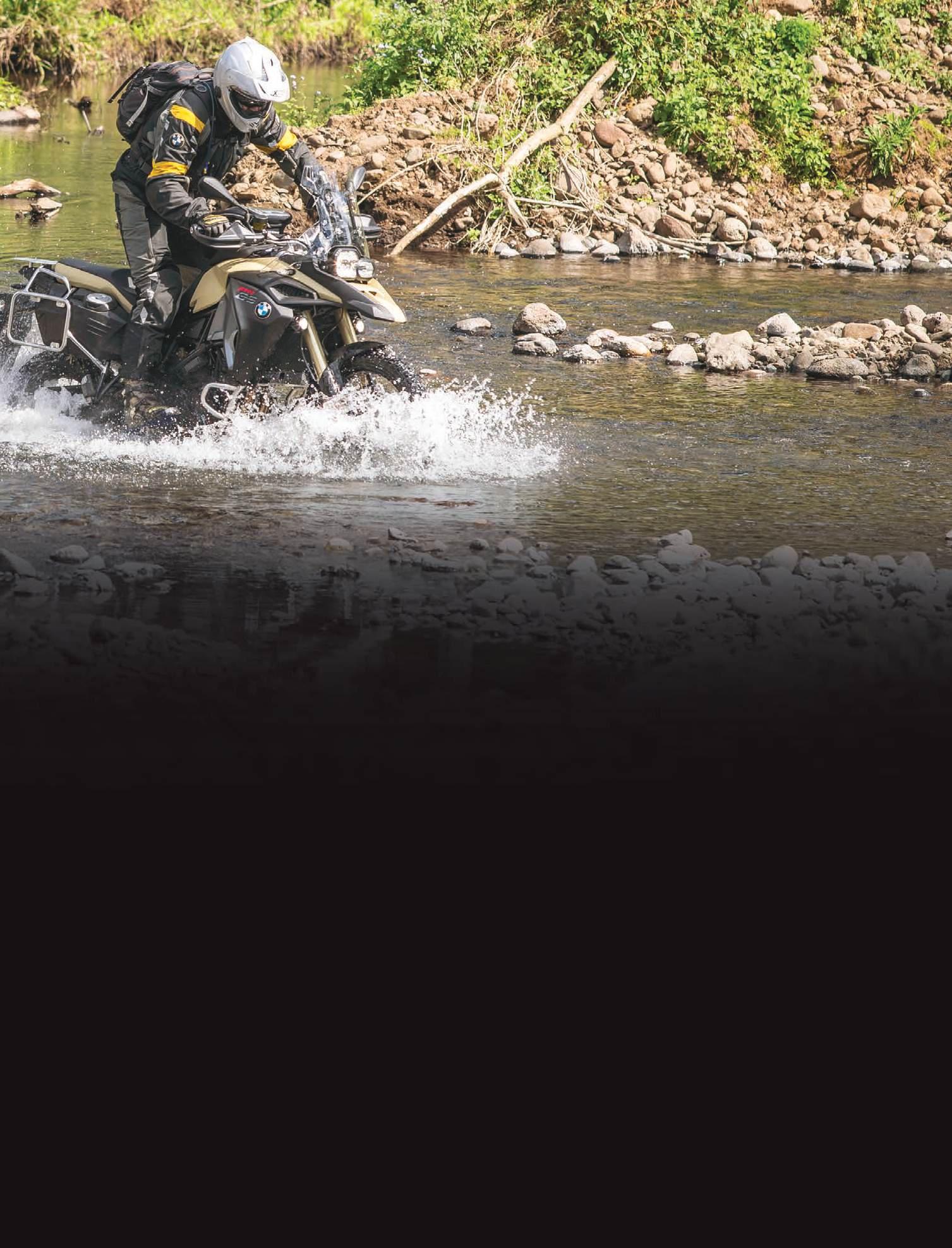
Engine Type: Liquid-cooled four-stroke in-line twocylinder engine, four valves per cylinder, two overhead camshafts, dry sump lubrication
Displacement: 798cc
Bore/Stroke: 82.0mm X 75.6mm
Compression ratio: 12:1
Rated output: 63kW (85hp) at 7500rpm
Possible reduction: 35 kW (48hp) at 7000rpm
Maximum torque: 83Nm at 5,750rpm
Possible reduction: 63Nm at 4000rpm
Engine Management: Electronic intake pipe injection, digital engine management (BMS-K+)
Emission control: Closed-loop three-way catalytic converter/emission standard EU-3
Starter: Electric
Fuel tank capacity: 24 litres
Transmission: Constant mesh six-speed gearbox integrated into crankcase
Length: 2305mm
Width (including mirrors): 925mm
Height (excluding mirrors): 1450mm
Seat height, unladen weight: 890mm (860mm low seat)
Wheelbase: 1578mm
Brakes front: Dual, 300mm discs, floating brake discs, with double-piston floating calipers and ABS
Brakes rear: Single 265mm disc, with single-piston floating caliper and ABS
Unladen weight, road ready, fully fuelled: 229kg

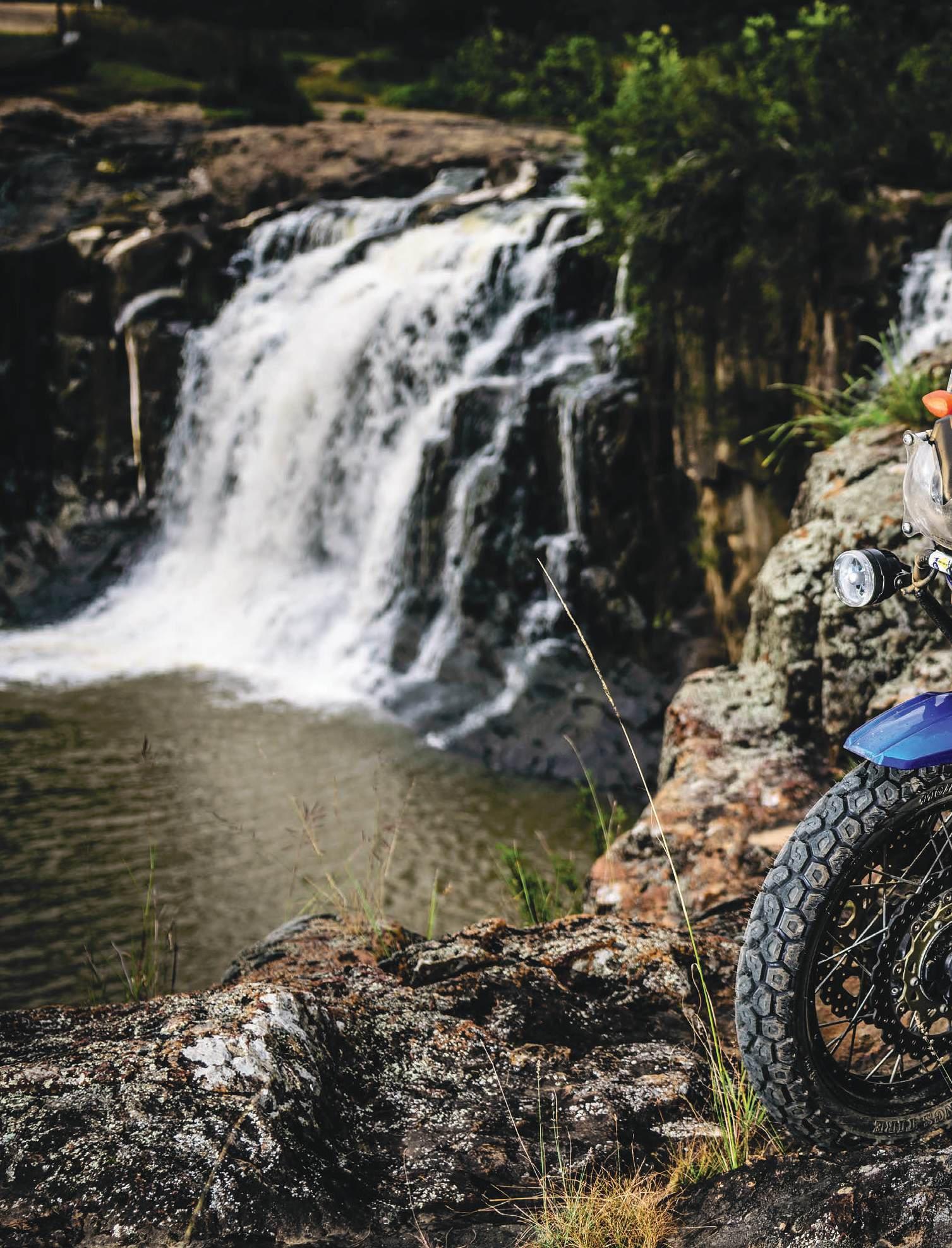
and
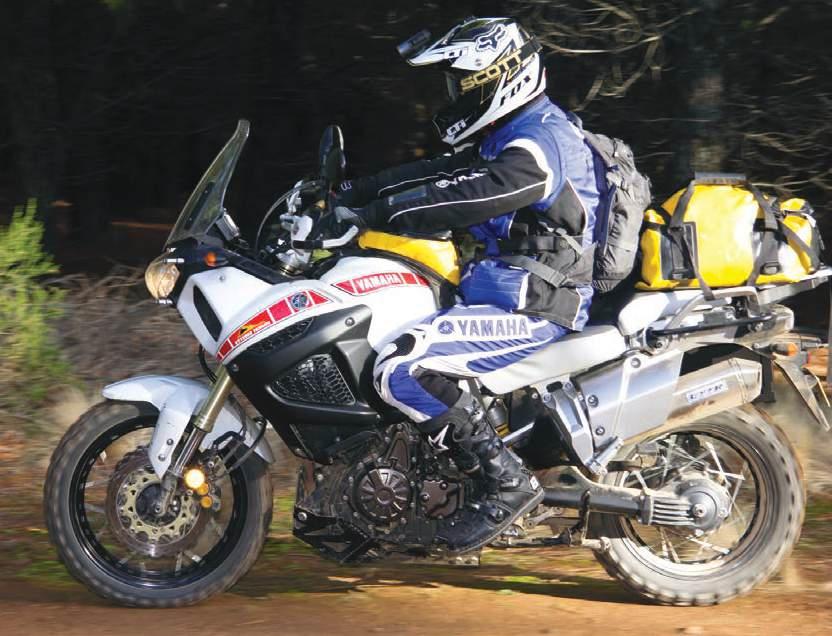
The Super Tenere is a comfortable long-distance mount that’ll haul plenty of luggage. It’ll cope well with forestry and dirt roads.
Any bike carrying around the moniker ‘Ténéré’ has a huge history to live up to. Yamaha’s heavy hitter in the adventure game carries that history, and a hefty load of comfort and leading-edge technology, with ease.
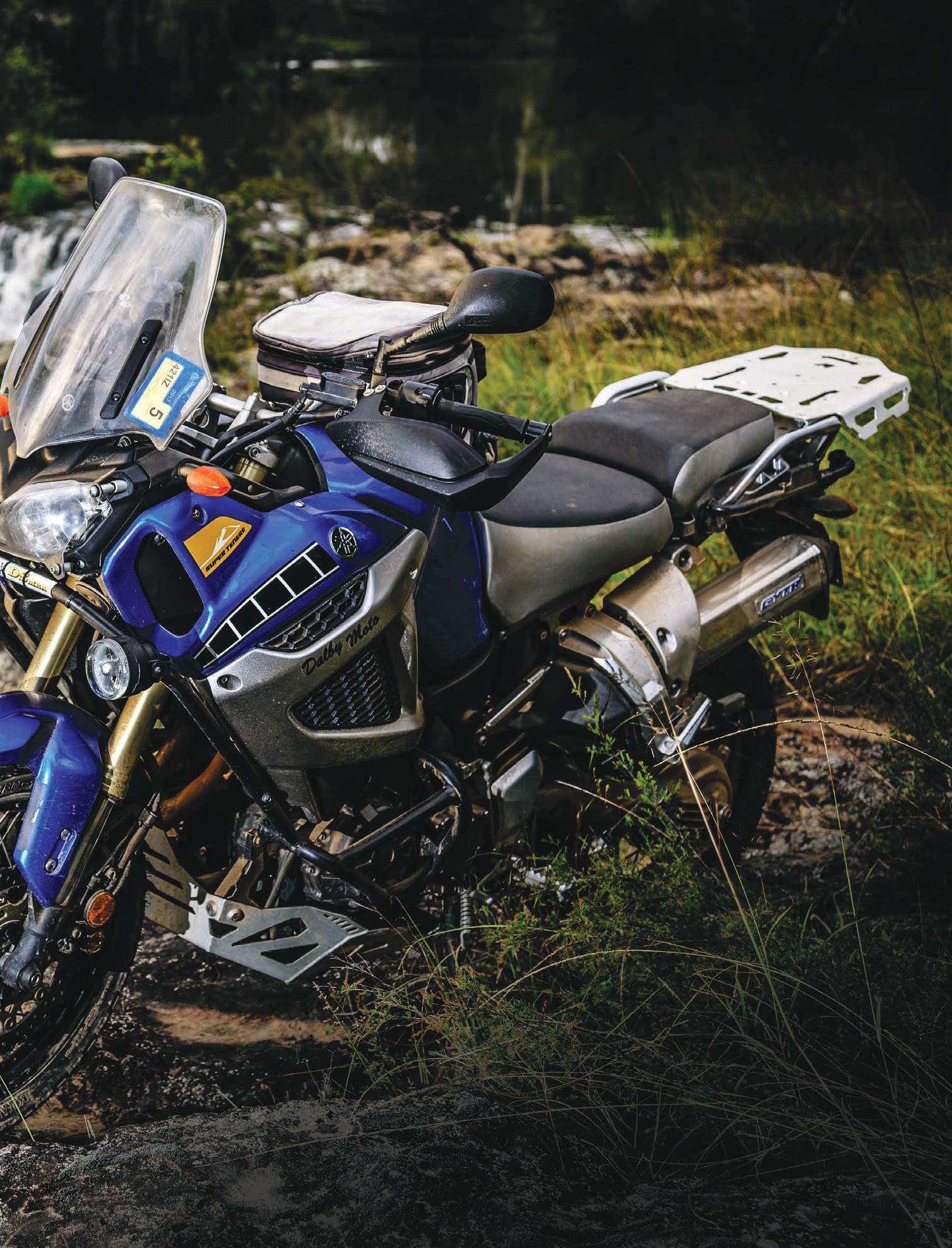
Yamaha has taken a two-pronged attack to the adventure market with the XTZ660 Ténéré and, more recently, the XTZ1200 Super Ténéré. Released in Australia in late 2010 as a 2011 model, it set diehard Yamaha off-road hearts racing. Here was a name most potential buyers associated with the carefree, big-fun days of their youth, but that bristled with modern updates like liquid-cooling, an 1199cc in-line twin, shaft drive, traction control and ABS.
Yamaha’s design team has also done a brilliant job of centralising the mass of what’s undeniably a big bike, and once the wheels are in motion, the XTZ conveys a sense of
For such a big bike, the XTZ1200 can tackle some single track with surprising results. u

stability and composure on broken tar and dirt roads that’s hard to beat.
We ran the Super Ténéré over a series of rough tar roads, flowing dirt tracks and a couple of tough, washed-out fire trails for good measure. Apart from a few lunatic diehards, that’s about the type of riding we reckon the huge majority of owners will be looking for on this bike.
Due to recent rains, the roads and tracks in the riding area were a dishevelled series of undulations and potholes. As it turned out, they were the perfect testing conditions for the big Yammy to show off its abilities in the natural hunting ground of the bigbore adventure tourer.
The 1199cc motor in the XTZ makes strong, progressive power and delivers it in such a way that the bike feels capable of effortlessly crossing the continent. The 270-degree crank formation gives the bike a unique character, but one that’s easy to adapt to. For those with Yamaha
history, it’s the same formation and firing order that was in the fabulous TRX850, and then the TDM900. The crank angle makes the parallel twin feel like a V-twin, with a characteristic lazy, tireless, long-legged lope, but somehow still delivering enough sting to make the thing a real pleasure. It’s now a tried and tested configuration with no obvious drawbacks.
Traction control is built in, but to be honest we switched it off early in our test and the bike was so smooth and tractable that controlled slides in the dirt were easy.
It’s a very interesting experience to ride with good traction control. When it’s working properly, the rider won’t notice it a lot of the time. On wet and slippery roads the Ténéré throttle can be cracked open and the bike drives away nicely. If it weren’t for the flickering light on the dash, you’d never know the rear wheel was losing traction under power. It’d be interesting to compare rear-tyre life with and without traction control.
The bike we rode was fitted with a GYTR exhaust and the rumble it generated wasn’t dissimilar to the throaty roar of a V-twin superbike. If we had a Ténéré in the shed, this exhaust would definitely be on the shopping list.
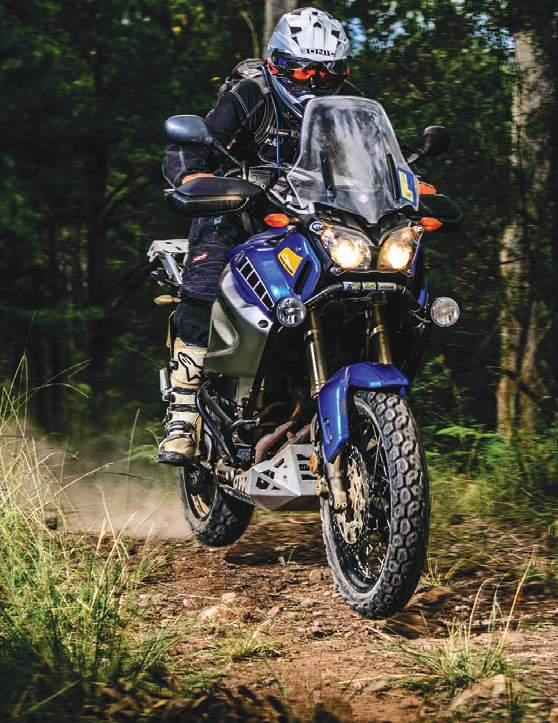
In its natural habitat. The XTZ is a superb road cruiser, but loves to get off the main highways for a look around.
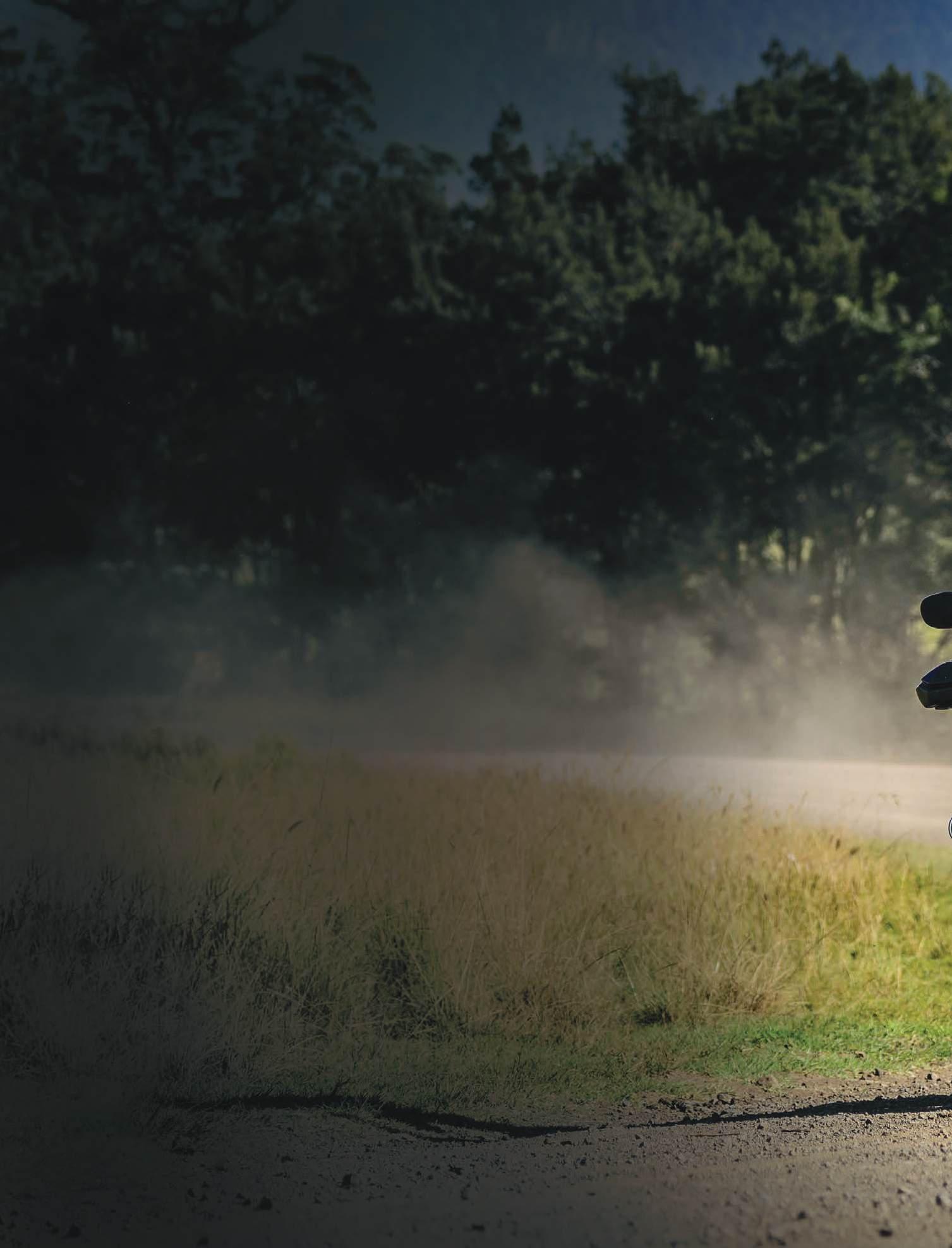
At 261kg ready-to-ride, this is certainly a big bike, but it handles the weight well. Good geometry and solid suspension result in a very stable handling package. You do feel the weight at slower speeds, but get the bike rolling along on a dirt track or lumpy tar road and it’s composed and inspires plenty of confidence. If the pace picks up beyond sensible speeds it’s possible to overwhelm the suspension on rough ground, but that’s a fair price to pay for a bike that feels so good when things are kept in check.
The ABS has three settings and features a ‘unified braking system’ that offers a controlled mix of frontand-rear application no matter what you grab and stomp in a panic. On paper the technology may sound like it runs the risk of overruling the rider input, but it’s done well on this bike and doesn’t feel that way, except in extreme situations.
Park your bum on the wide, well-supported seat and it’s hard not to envisage this bike conquering distant horizons. Sitting or standing, the XTZ1200 is comfortable, and realistically there are few things to complain about. The screen worked well during our test and is wonderfully easy to adjust. A screwdriver or pocketknife will alter the height in a minute or two. Generally things fell to hand nicely, engine vibration was minimal, and it’s a very plush and comfortable ride.
Riding big bikes in the dirt requires a confident approach, but it’s surprising where the Yamaha will go with no more than a steady hand and some decent line selection. Ground clearance is respectable at 205mm, but like most big bikes, getting carried away can lead to mischief. Having followed one into the rock garden that is the Sundown National Park, I’ve seen they’re certainly capable when the tar ends, and considerably more so than the spec sheet would indicate.
Still, there’s no pretending this is a trail or enduro bike. It’s big, heavy, comfortable and powerful, and Yamaha has a good range of accessories including a high screen, handguards, crash bars, lighting kits and heaps more. Anything Yamaha doesn’t have, companies like Touratech and B&B have by the truckload.
It’s a big-bore adventurer alright. And a good one.

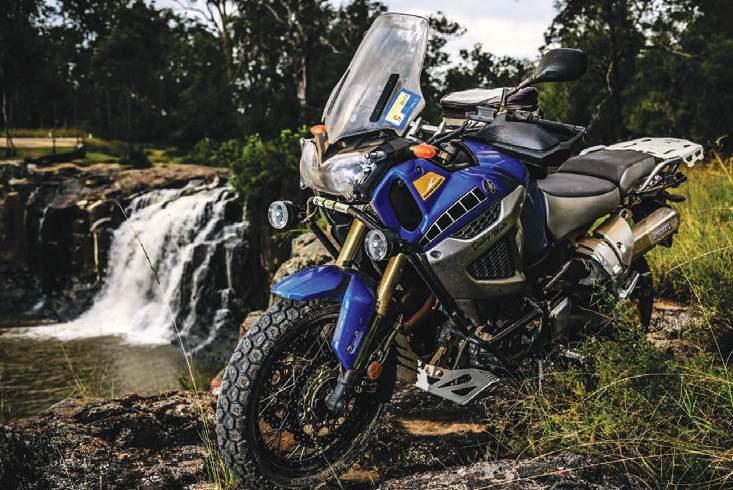
Engine Type: Liquid cooled, 4-stroke DOHC 4 valve, forward-inclined parallel 2-cylinder with YCCT and traction control
Displacement: 1199cc
Bore/Stroke: 98.0mm X 79.5mm
Compression ratio: 11:1
Lubrication system: Dry sump
Fuel management: Fuel injection
Ignition: TCI
Engine Management: EFI, YCC-T, D-mode
Starter: Electric
Fuel tank capacity: 23 litres
Oil capacity: 4.2 litres
Final Transmission: Shaft drive with hypoid gear design
Transmission: Constant mesh, six-speed
Length: 2250mm
Width: 980mm
Height: 845mm
Seat height: 845mm
Wheelbase: 1540mm
Suspension travel: 190mm front and rear
Brakes front: Dual disc 310mm, ABS + unified braking system
Brakes rear: Single disc 282mm, ABS + unified braking system
Tyre front: 110/80 x 19
Tyre rear: 150/70 x 17
Ground clearance: 205mm
Wet weight: 261kg
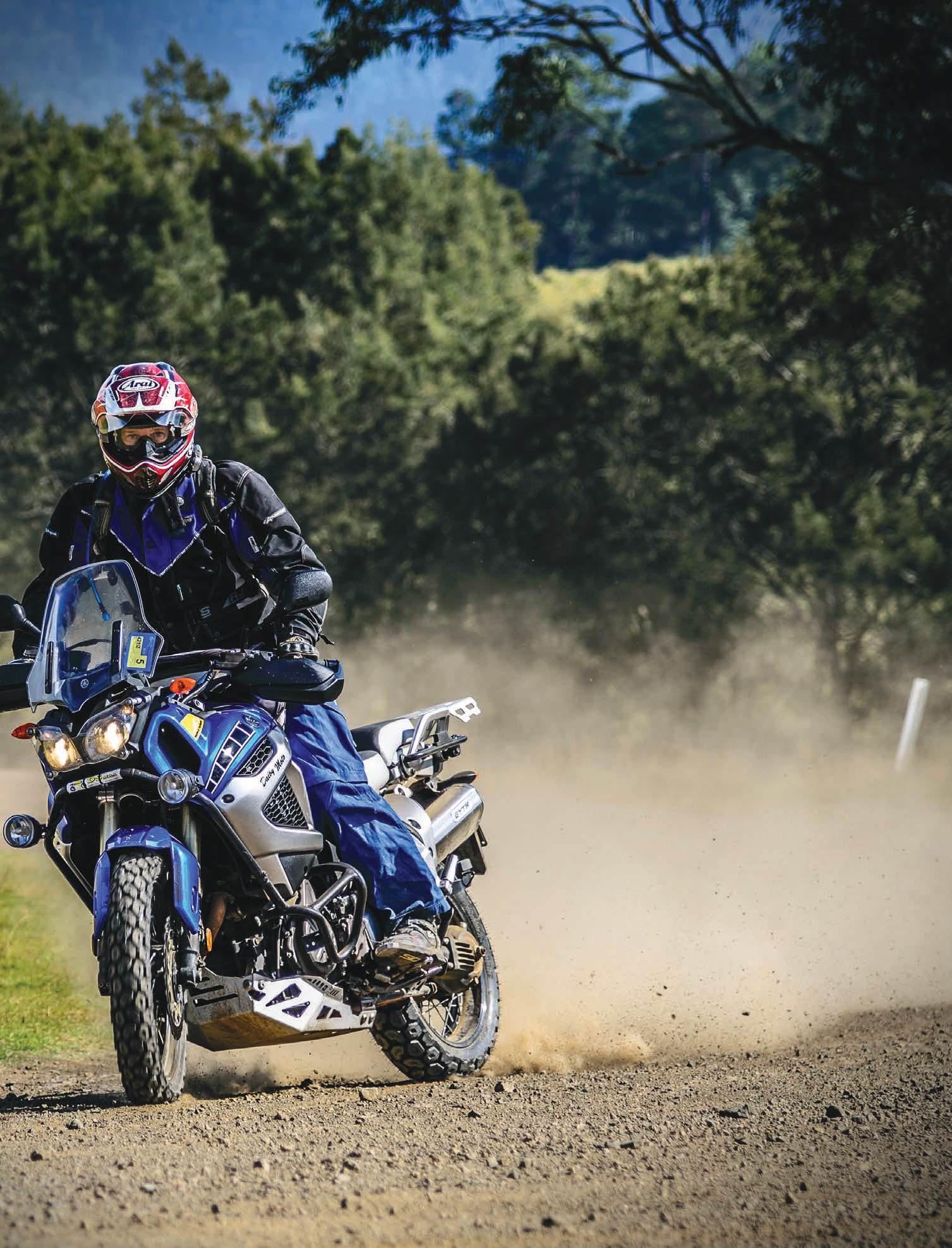
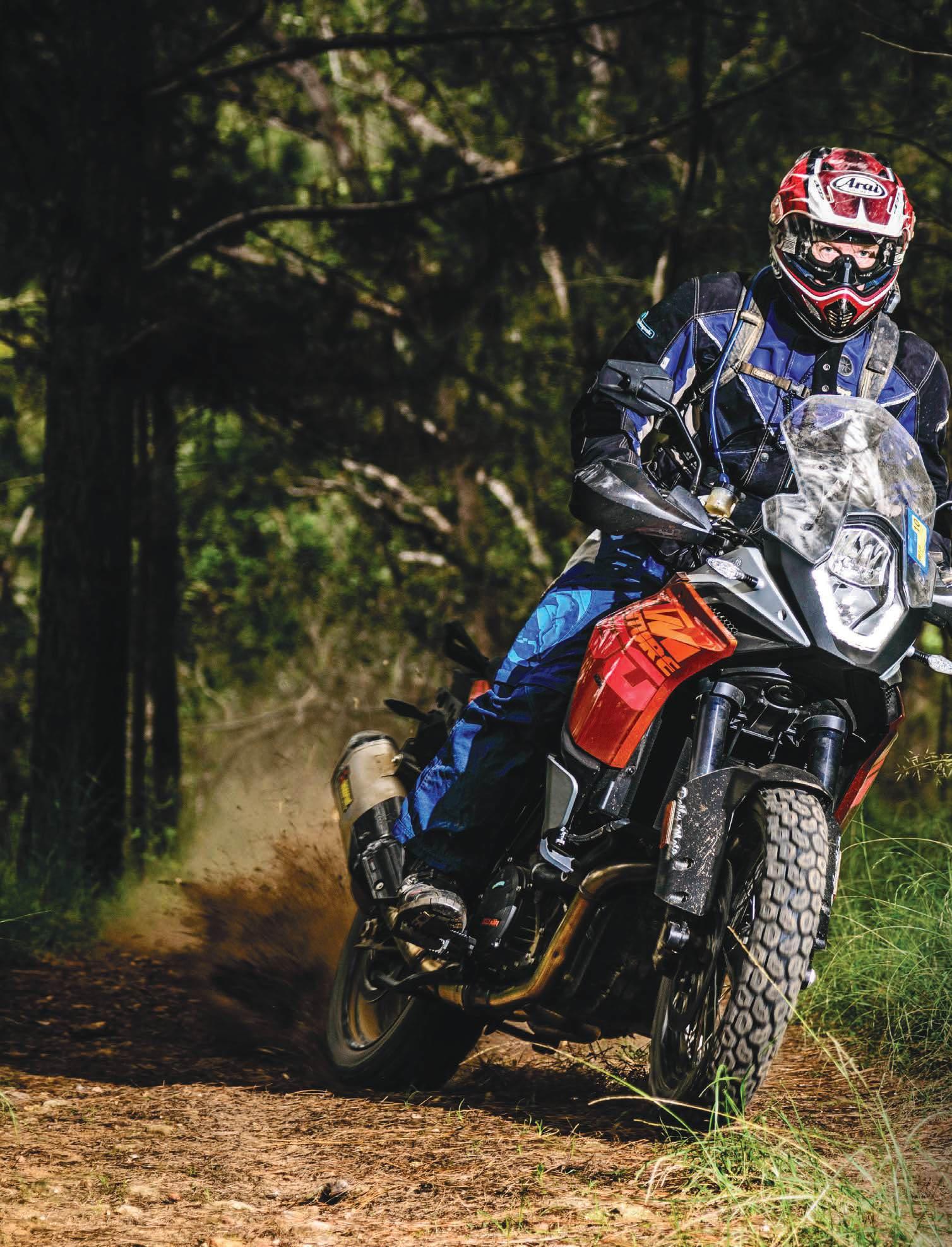

Does anyone need 150 horsepower in an adventure bike? Who cares! When it’s delivered in a package as sweet and beautifully designed as this one, the stonking great wodges of rear-wheel drive are almost a second thought.
With a long and justifiably proud history in world rallye and general adventure riding, KTM has carved out a name and reputation. The common perception is, the bikes are competition-bred, and if that gives them a hard edge here and there in performance and makes them a little more suited to hard chargers than some of the softer options, that’s okay.
Whether or not that’s true makes for good campfire debate, but there’s no doubt the 990 is a bike for serious riders, and although the 690 might have less horsepower, it’s still clearly a dirt-ready race weapon.
But now there’s a bike in the KTM range that will not only kick arse and take names for the pro rallye demons, it’s incredibly comfortable and easy-to-ride. And it’s a powerhouse.
Bells and whistles
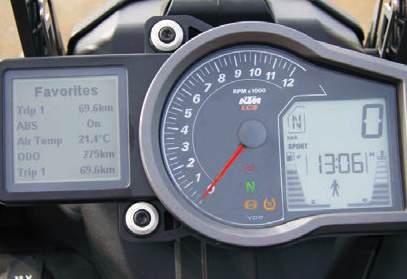
The 1190 is all-new to adventure riders. In fact, the motor is derived from the RC8 powerplant used in KTM’s superbike campaign and the fearsome 1190R RC8 road bike. That was the motor known for its sharpish power delivery – by “sharpish” we mean “freaking scary for the unprepared”.
However, since the mid-1990s KTM has been making its bikes rideable. Those with long memories will recall the change when the orange bikes arrived. KTMs went from being expert-only competition mounts to being very rider-friendly and easy-to-live-with, but still as light and as fast as ever. That philosophy has obviously been applied to the 1190 Adventure, because for a motor with more muscle than a California governor, this thing is a complete sweetheart. It’s as smooth as silk and a real pleasure to use in all situations.
Along with the luxuriously usable V-twin donk go some other very tasty rider aids. Electronic suspension tops the list, adjustable by merely selecting a suitable option from a menu on an LCD screen. The same goes for variable traction control, several engine maps, and ABS with a couple of options for front, front/rear, or ‘ABS off’. The stock tank is a 23-litre unit that should give a comfortable range well over 300km in even the most demanding circumstances, and there’s an adjustable screen, ’bars
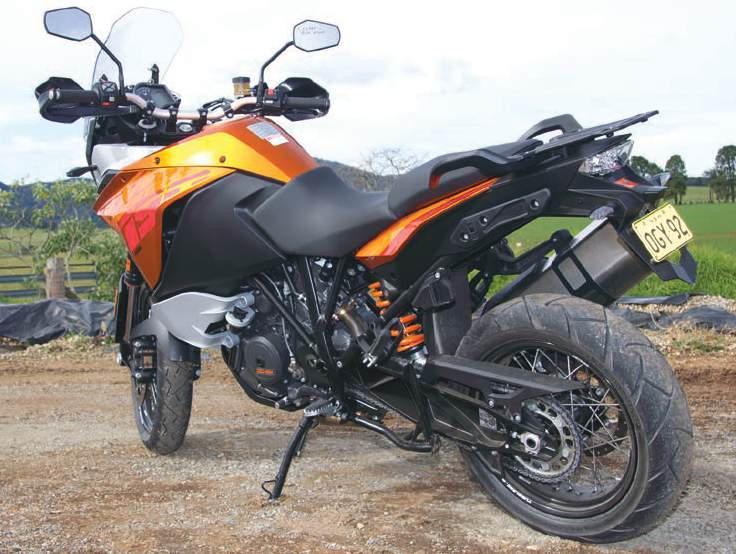
Main: KTM’s 1190 is an amazing mix of horsepower and technology, and the Austrian company has got the mix just right.
Above: It’s a very tidy-looking package. The cockpit is open and comfortable and the riding position should suit most bronzed Aussies. Luggage and accessories, KTM and after-market, are becoming available fast. Below: The Adventure R model is a screamer. Crash bars and a 21-inch front wheel are the obvious differences, but there’s no electronic suspension adjustment either. Recommended retail is $21,995 + ORC.
and seat height, tubeless tyres front and rear, and the usual catalogue of specially designed luggage systems. Phwoar. A potential buyer could go crazy loading up the options on this puppy.
We’ve ridden the ‘standard’ 1190 here, but for the seasoned rider who wants to hit the dirt a little harder, the 1190 is available in an ‘R’ version.
u
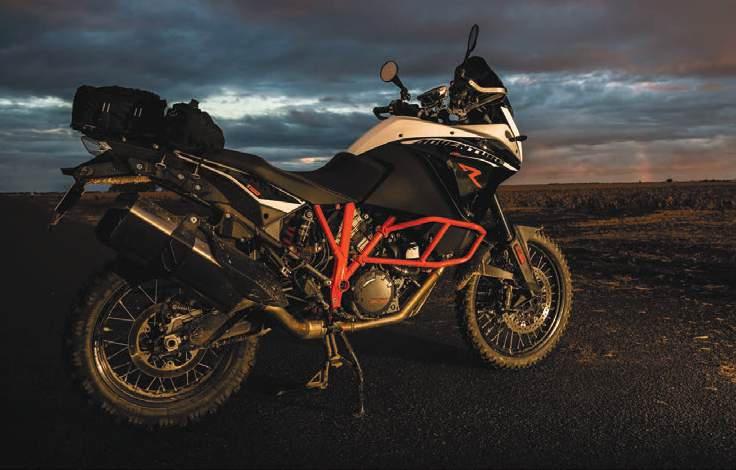
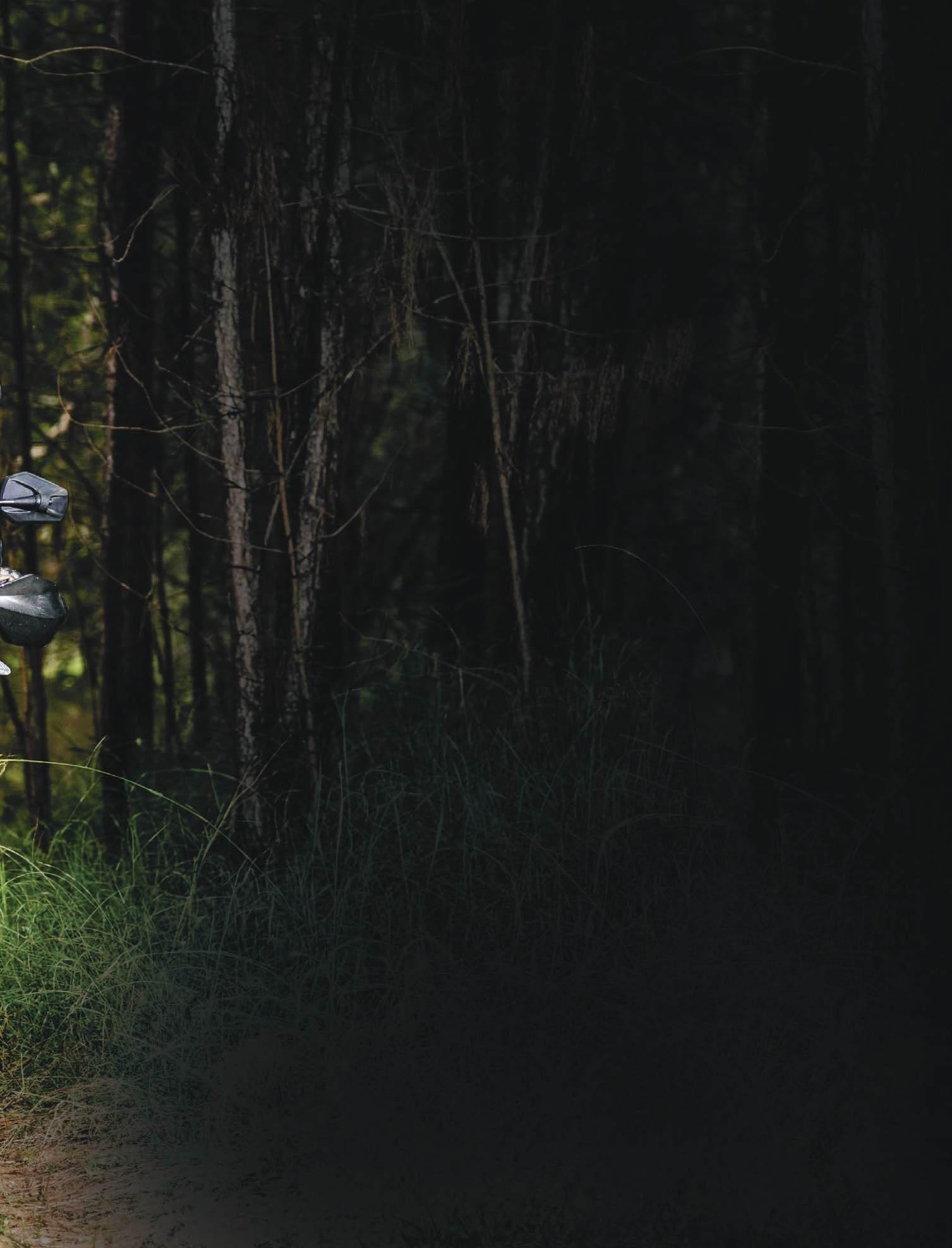

Greg Poole
Irode the new KTM from Killarney, just north of the Queensland/NSW border, down through Urbenville in NSW, and back. This area had it all: bitumen, gravel and single trail.
After admiring the bike from afar, the first thing that struck me was just how easy the 1190 was to push around, so I was keen to see how light it felt in action. It didn’t disappoint. Considering the specs and the horsepower this thing delivers, it felt really light and nimble.
Once we got into the nitty gritty of actual riding, I realised something I hadn’t in the past, and that was just
a gravelly corner confidence-building. I went to Sport mode on the gravel roads and unleashed the beast, attacking them, curious to see how smooth the power delivery and handling was. I was surprised at the ease with which you could throw this bike around. And just a little bit scared. The responsiveness to the throttle was very quick.
The biggest difference between the 1190 and 1190R is the 21-inch front wheel on the R – as opposed to a 19-inch on the standard model –and the absence of the electronic suspension controls. The suspension on the R is also a little taller. So if you feel the technology may be making things a little too easy, there’s the hard-man option.
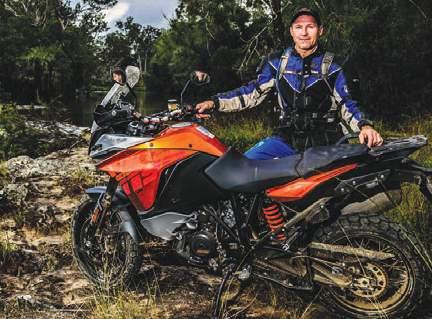
how much power my left thumb had! I could gain or lose 50 horsepower just by flexing my opposed digit. The ability to change the setting on the LCD menu to select the correct delivery of power, traction control and ABS was all new to me, and I was keen to learn more.
I started on the bitumen with the ABS and traction control on, and the bike handled very well. The 18-inch front wheel made the bike turn smoothly on the winding asphalt roads. After settling in, I decided to bite the bullet and take the ABS and traction control off and switched to Sport mode. I straight away noticed a huge difference in the power output.
On gravel roads with the ABS and traction control on, the bike tracked very true and straight. The ABS was a little unnerving on the gravel, but the traction control made coming out of
Single-trail would have to be my favourite terrain, and the 1190’s agility combined with the power and suspension on this bike didn’t disappoint. The fluid motion through the small trails was awesome. Ground clearance, though, could be one shortfall I can find with this bike. It needed just a little more height to clear very rocky knobs and some erosion mounds comfortably. That said, there’s still a lot of fun to be had on the single tracks. My overall experience with the KTM 1190 Adventure was that I want to ride it again and again and again. It’s a fantastic bike that’s very light and well-balanced on both bitumen and gravel roads, making it a versatile crossover mount for both terrains. Combine with that the ability to input your settings to suit your own particular riding style and it ticks a lot of boxes.
I preferred the ABS and traction control to be off; I like to throw the bike around a bit and feel a little restricted with the settings on, but the option is there if you want to use it.
The 1190 would suit any adventure ride, even considering the ground clearance. I’d love to load it up with gear for a trip and see how it performs, but I’m sure it would live up to my expectations.
Some experience would be necessary to use the full potential of this bike; it’s definitely not for the novice or faint-hearted. With all its capabilities and credentials, it’d be criminal to have a bike like this in the shed, not used to its full capacity.
So, can I have one, please?

The power settings are there on both, and they’re a gift to those sensible enough to use them. In Sport mode the rider gets it all – 150hp, straight up the back passage. Real men only need apply. But then there are settings that intentionally drop the horsepower for given riding conditions, and they’re brilliant. ‘Street’, ‘Rain’ and ‘Off Road’ are there on the menu and ease the power delivery in steps down to a supposedly meek 100hp. Along with the variations available in ABS and traction control, it means the bike is just so incredibly easy to ride. Fast riders will find the 1190 blindingly quick and incredibly sure-footed. Less-then-expert riders will find they’re riding much faster for much longer than they ever have before, and doing it with considerably less effort. What could possibly be wrong with that?

“Idunno what all the fuss is about,” I thought. The new 1190 tracked straight and true as I lit the wick down a dusty gravel track. Sure it was comfortable and the suspension gave a high degree of confidence through the broken rock, but I was waiting for the unbridled surge of power that comes with a claimed 150hp. Curiosity is a dangerous thing, but I wanted to see exactly what that meant in the dirt.
Don’t get me wrong, it was still meaty, big-bore power, but it was delivered in such a way that it was no more intimidating than other big-bore adventure tourers that boast considerably lower peak-power outputs.
Perplexed, I flicked through the LCD menus to ensure that the Sport mode was selected. Amid the dust – and thoughts of looking after someone else’s shiny new bike – I only took a cursory glance, saw ‘Sport’ highlighted and twisted the throttle further to see what I was missing. Naturally the bike bolted forward, but the big-bang factor was somewhat subdued. We stopped to grab some pics and on the way back and I double-checked the selection. Yes, the Sport mode was selected, but only for the electronic suspension. Power was in the more manageable Off-Road mode, limiting it to 100hp (I almost feel stupid writing this – ‘only 100hp’!).


Select ‘Sport’ power. Twist throttle.
Hang on!

Web:
Everything about the 1190 shows its KTM pedigree. There’s no bits sticking out to snag or hook up, ground clearance is good, and there’s smooth, usable horsepower to spare.
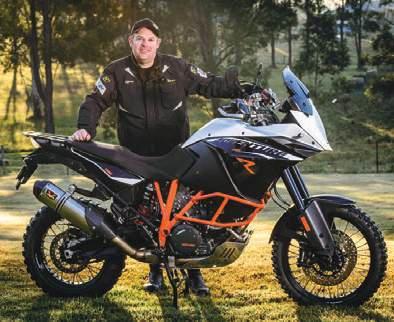
The rear tyre lit up, spun until it hit bedrock, and then the bike launched forward. I gripped with my knees to make sure I didn’t fly off the back and pretty soon that gravel track became a narrow tunnel through a blur of green paddocks. I reached the tar and in the interests of science twisted the throttle again. The front wheel hovered inches of the ground, the rear scrabbled for traction on the well-worn bitumen and I developed delusions of grandeur.
Truth be known, it’s the kind of power that could easily corrupt a person. The bike’s suspension and geometry combine to make it feel considerably lighter than the spec sheet would indicate, and before long you’re spinning the rear tyre out of tight bitumen corners and thinking it’s time to start wearing your undies on the outside, superhero style.
KTM has created something pretty special here. It’s a bike that handles well and goes like stink, yet with the touch of a button becomes perfectly agreeable. In typical KTM fashion there’s still a sense of rawness, reminding you that amid the new-found sophistication it’s still a bike to be treated with respect.
Engine Type: Liquid-cooled, 75-dgree, V-twin four-stroke
Displacement: 1195cc
Bore / Stroke: 105mm x 69mm
Starter: Electric
Transmission: Six-speed, claw-shifted
Lubrication: Forced-oil lubrication with three rotor pumps
Primary Ratio: 40:76
Final Drive: 17:42
Clutch: PAS anti-hopping, hydraulically operated
Ignition: Contactless, controlled, fully electronic
Frame: Tubular space frame made from chrome molybdenum steel
Sub-Frame: Aluminium
Handlebar: Aluminium tapered
Front Suspension: WP Suspension upside-down
Rear Suspension: WP Suspension monoshock
Suspension Travel: 190mm/190mm
Front / Rear Brakes: Two Brembo, radially mounted, four-piston calipers/Brembo fixed
Front / Rear Tyres: 120/70 ZR 19; 170/60 ZR 17
Chain: 5/8 x 5/16” X-Ring
Steering Head Angle: 64 degrees
Wheelbase: 1560mm
Ground clearance: 220mm
Seat height: 860 / 875mm
Tank capacity (approx): 23 litre
Weight without fuel: 212kg
Three times World Superbike Champion and all-round top bloke Troy Bayliss.
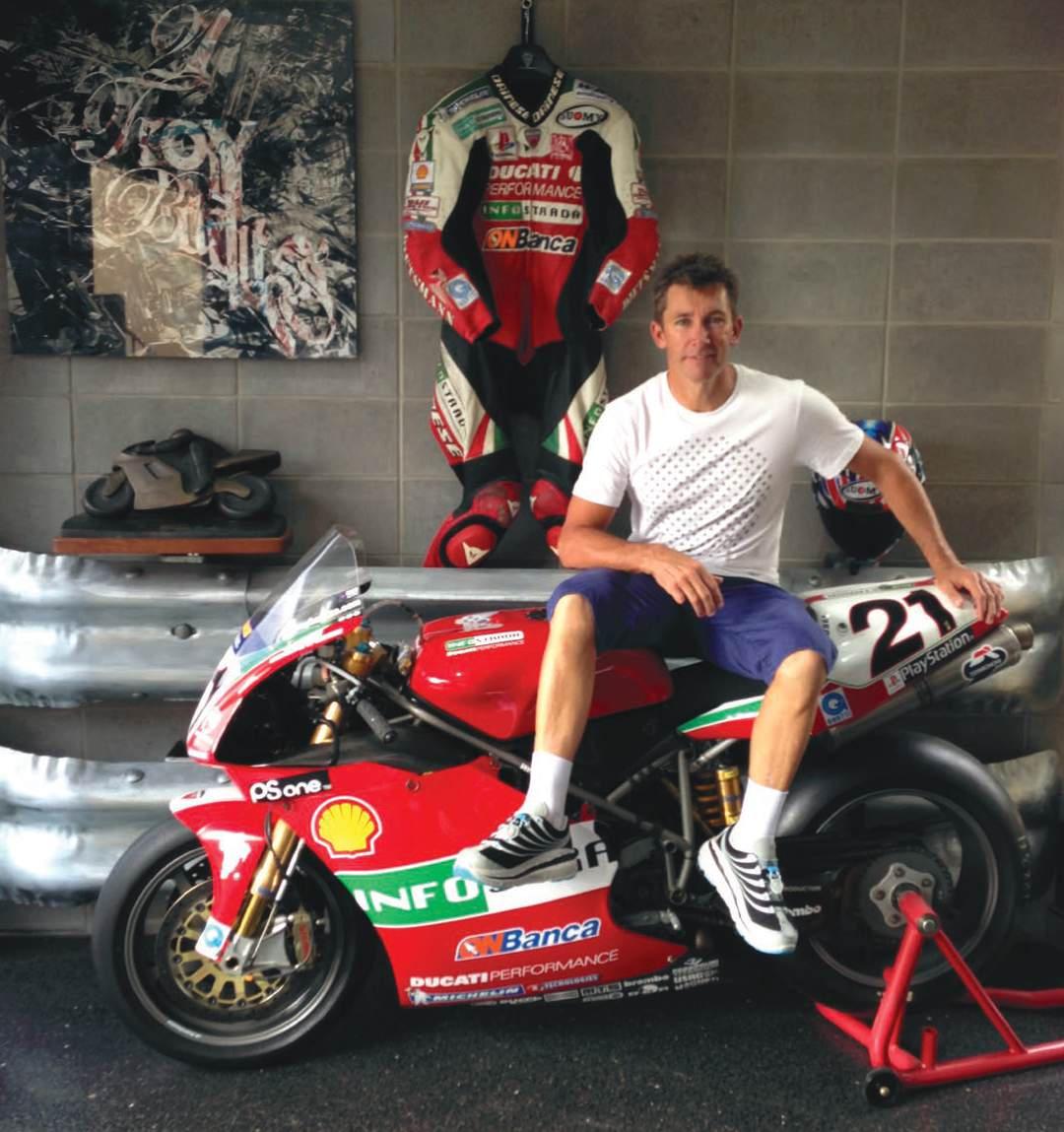
adventure riders are expected to be well catered for with manufacturers BMW, KTM, Triumph, Yamaha and Ducati already confirmed, and with more brands to be announced in the coming weeks we can expect to see the best in adventure bikes, accessories and aftermarket goodies on display.
Owners and buyers will have the chance to speak directly to manufacturers and distributors of products and it’s promised to be a great opportunity to compare a huge range of bike-related goods and services in one outing.
The program includes product launches, special guests and live demonstrations across the three days of each event.
“MOTO EXPO is a new and fresh approach to motorcycle exhibitions,” Bayliss Ducatied.
“We’ve been working
Three-time World Superbike Champion Troy Bayliss has revealed plans to start up large-scale motorcycle trade shows, and he’s promising strong adventure content.
Troy’s promotional company Troy Bayliss Events will stage bike exhibitions in Brisbane and Melbourne in 2014. MOTO EXPO Brisbane will be held at
Brisbane’s RNA Showgrounds on March 21-23, followed by MOTO EXPO Melbourne at Melbourne Showgrounds on November 28-30, 2014.
The Brisbane show will feature over 100 exhibitors showcasing a huge range of bikes, scooters, ATVs and UTVs (side-by-sides). In very good news – and the reason we’re so interested –
hard to create the perfect blend to showcase the motorcycle industry products and services to enthusiasts and the wider community.
“Both the Brisbane and Melbourne Showgrounds offer newly renovated exhibition buildings and allow expansion outdoors.
“The shows will come to life with test rides, safety
demonstrations and racing. It’s all there to create a great day out for the whole family,” Bayliss world-championed.
The Brisbane event will also stage a Superstars Of Motorcycling feature event –The “Baylisstic Scramble” –a dirt track teams challenge.
The Scramble will throb into life on Saturday evening and entry into the show will grant access to the 20,000-seat stadium where five teams of four riders will compete for points across many races to determine the team champions.
A full list of riders is promised shortly, but visitors can expect to see some of Australia’s most successful riders, past and present, competing, along with support races that include classic and vintage bikes, ATV, UTVs, mini moto, freestyle motocross, trials and more.
“To compliment MOTO EXPO Brisbane we’re bringing such a special competitive motorcycle event to the heart of Brisbane city, which is going to be phenomenal,” Bayliss backed in.
“The list of special guest riders competing are world class, and I always look forward to dirt flat-track racing. It’s where it all began for me and many other riders, and it’s always bar-to-bar action.”
A huge entertainment program featuring freestyle motocross, freestyle trials and streetbike stunts will run over the three days of the event and for the kids, a special come-and-try zone will be created giving them the chance to get their first taste of motorcycle riding in a safe environment. For further information visit troybaylissevents.com or go to www.facebook.com/ MotoExpoAustralia.

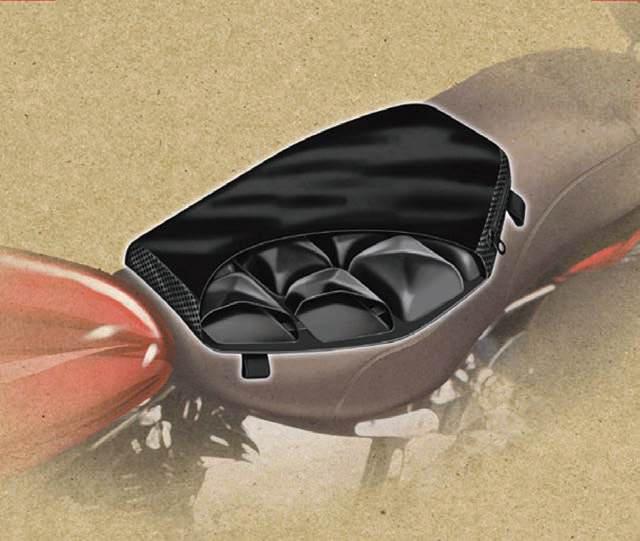

“SBK competitor and BMW dealer Chris Vermeulen is one of the world-class riders who’ll be at the new trade shows.”
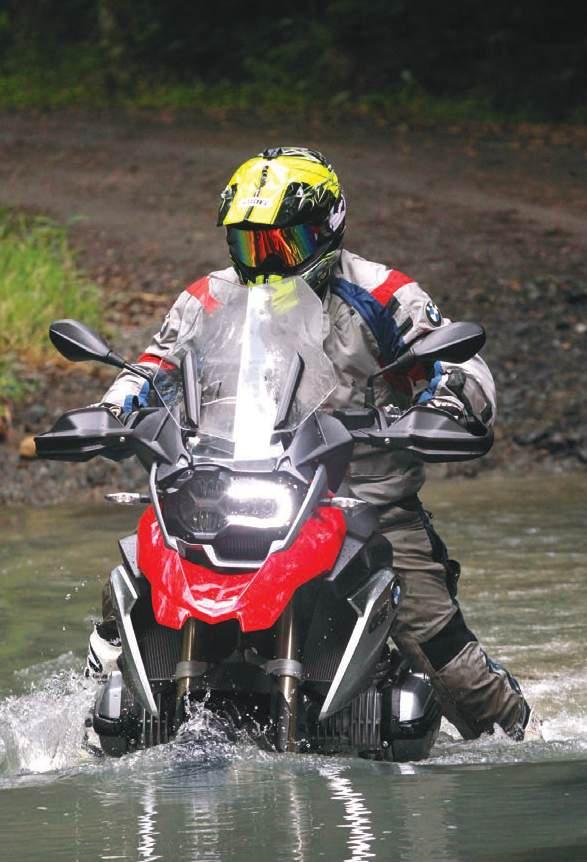
3 3 Reasons to keep Reasons to keep you on the road... you on the road...
Designed to lock your helmet to your bike. Simply set your own 4 digit code, open the lock, slip the carabiner through your helmet’s D-shackle, attach it to your bike and lock it!


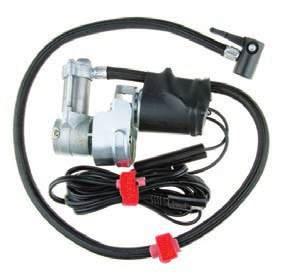

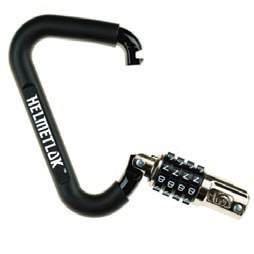
Ultra-compact, weighing in at only 570g, the MotoPressor™ can be used to inflate tyres, top off air shocks, air forks, inflate airbeds or anything else, anywhere, anytime, over and over again.
A puncture repair system for tubeless tyres. Simply remove the object that’s punctured your tyre, insert a plug into the puncture hole and pull the tool out of the tyre. Job’s done!
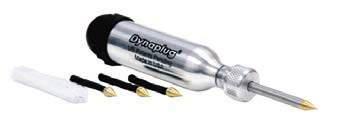
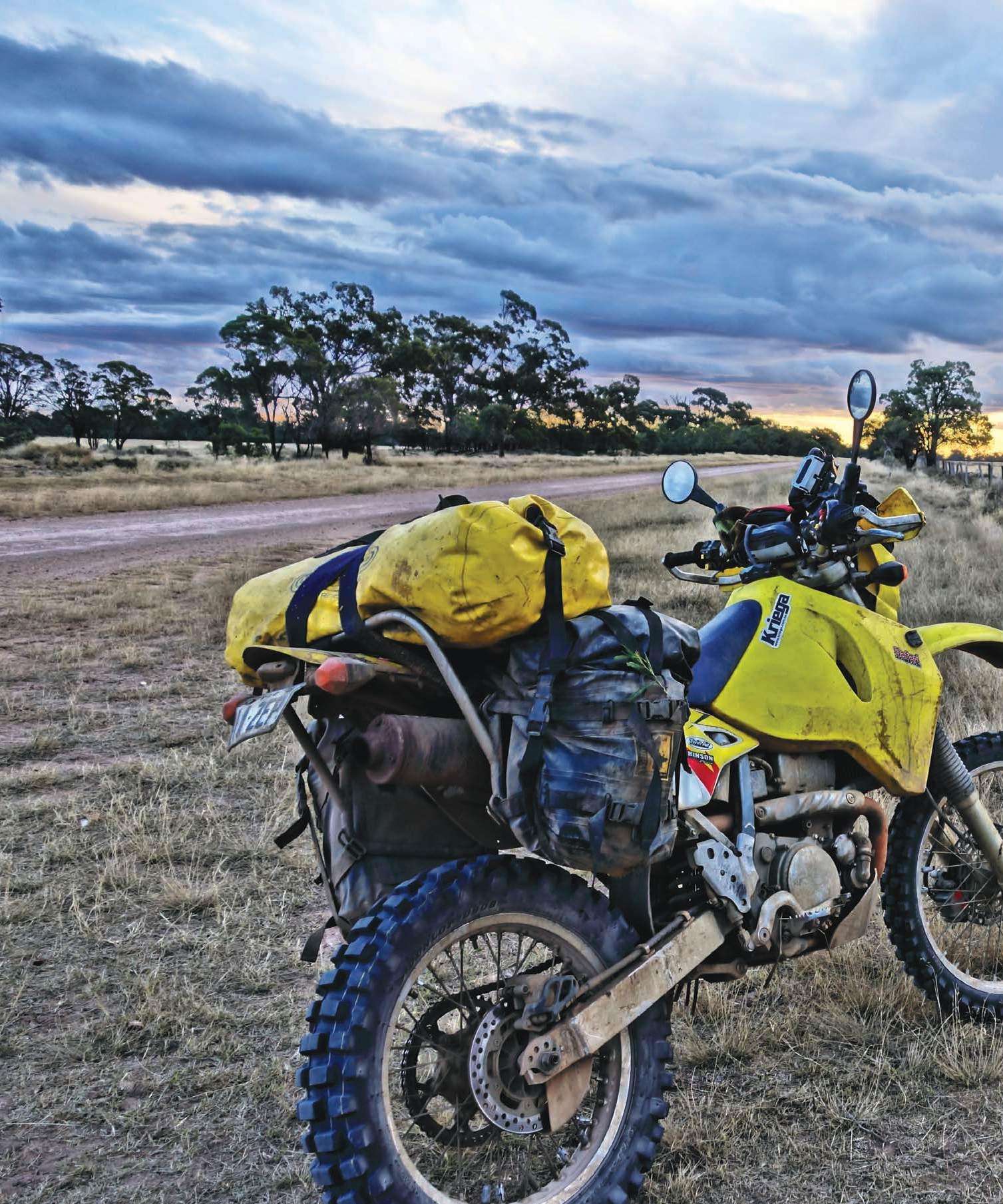
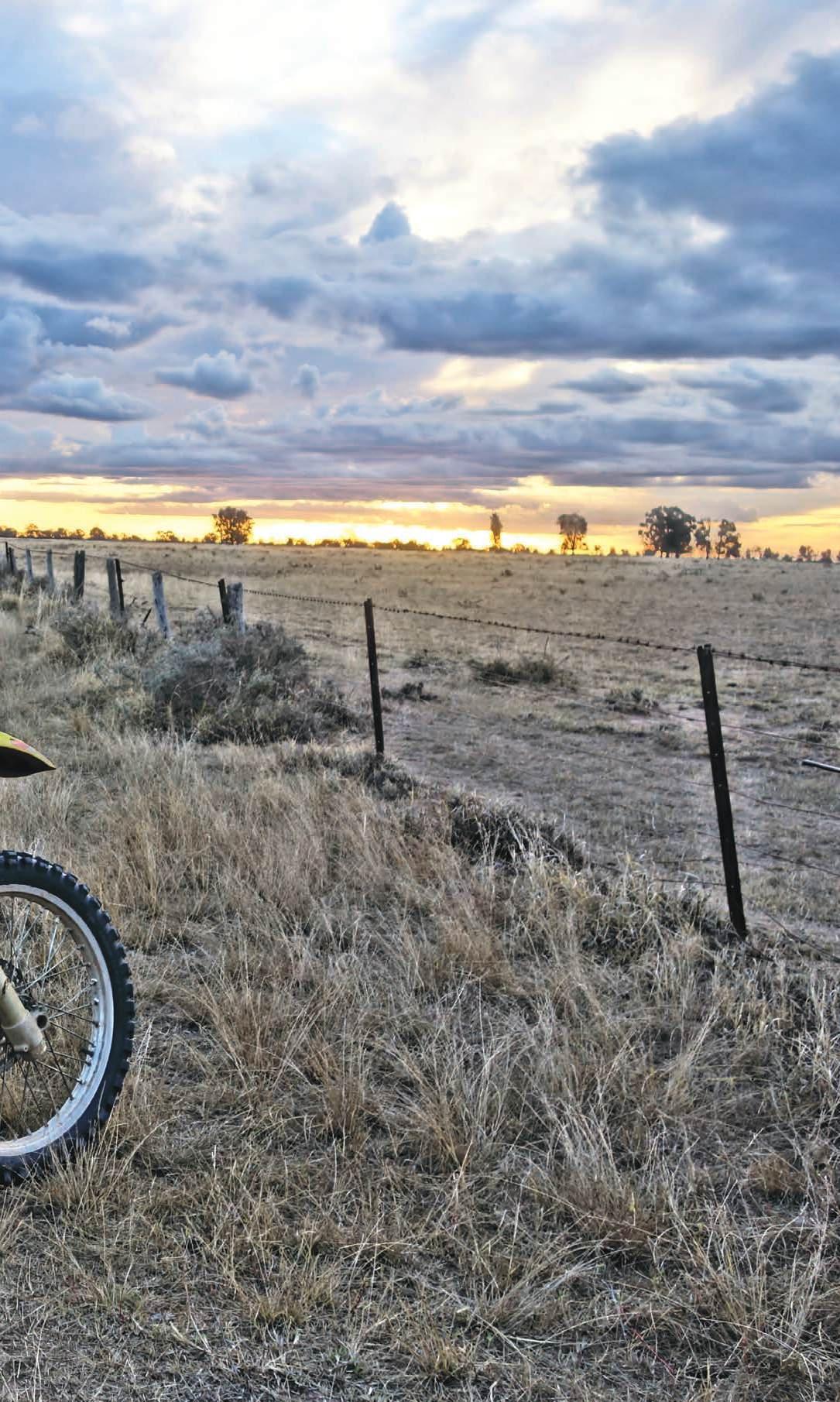
“This was taken about 20km from Goondiwindi in Queensland while I was on the APC Rally,” snapped Melbourne’s Nick Fletcher. “With only three easy days to go on what had been a tough two-week rally, I realised I didn’t have a photo of my own bike, so I stopped for this shot against a wonderful sunset. I spent the night in Goondiwindi and couldn’t get the bike started in the morning. It had got dust behind the filter and destroyed the piston, so that was the end of my rally with a 2000km recovery required to Melbourne. For the record, it’s a DRZ400E, with a 17-litre Safari tank, suspension by Chad’s Off Road, and a relatively modest sprinkling of upgrades. In many ways it’s the perfect bike for the rally.” An exclusive Adventure Rider Magazine polo is on its way to Nick. Log on to www.advridermag.com.au



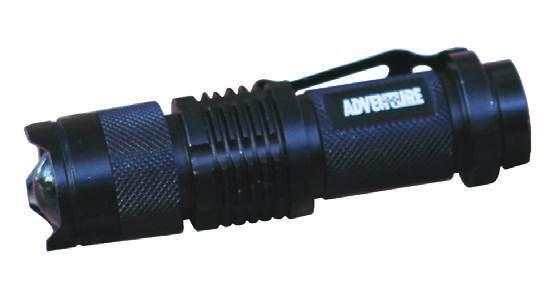
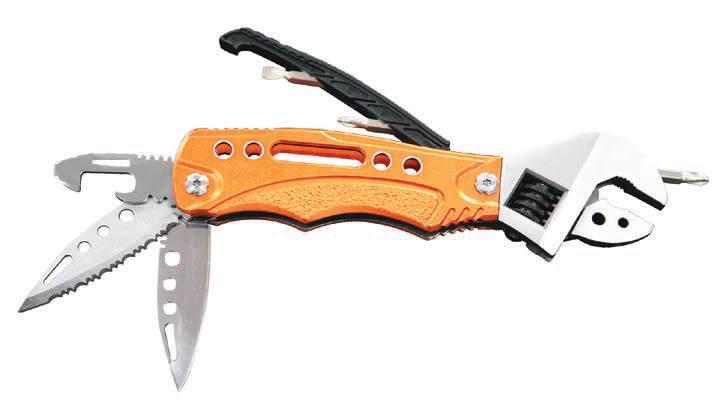

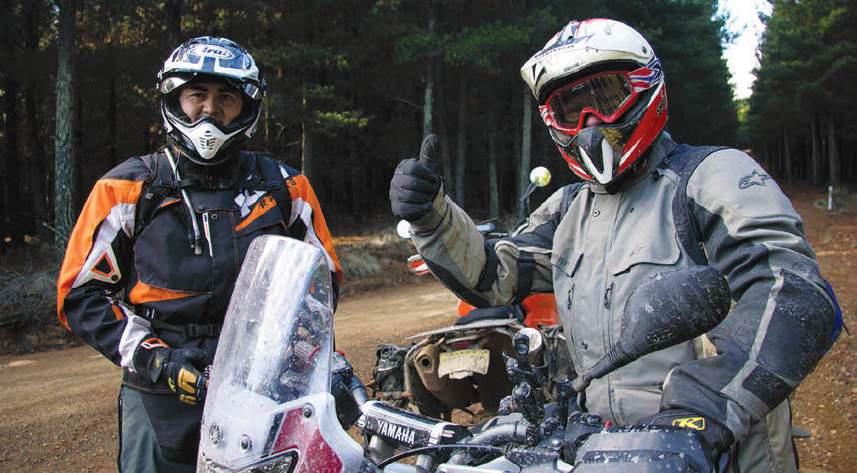

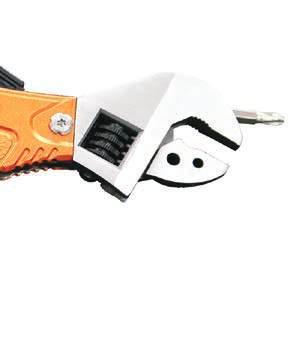



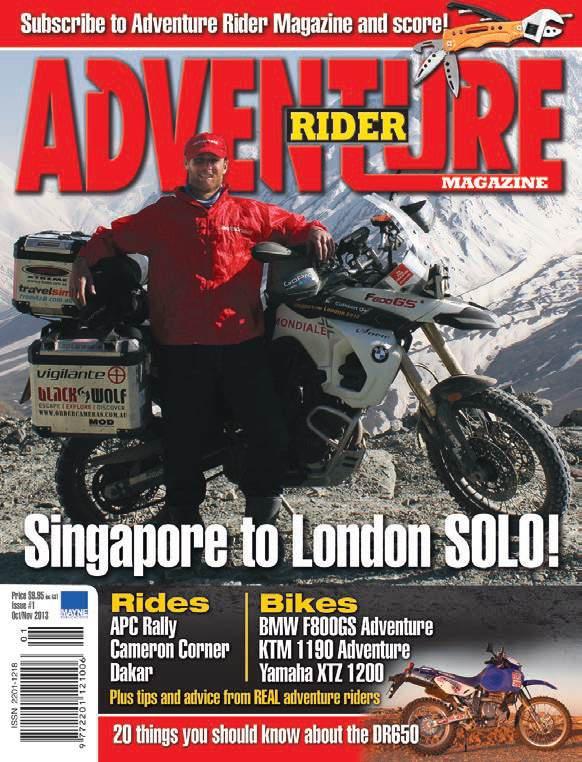
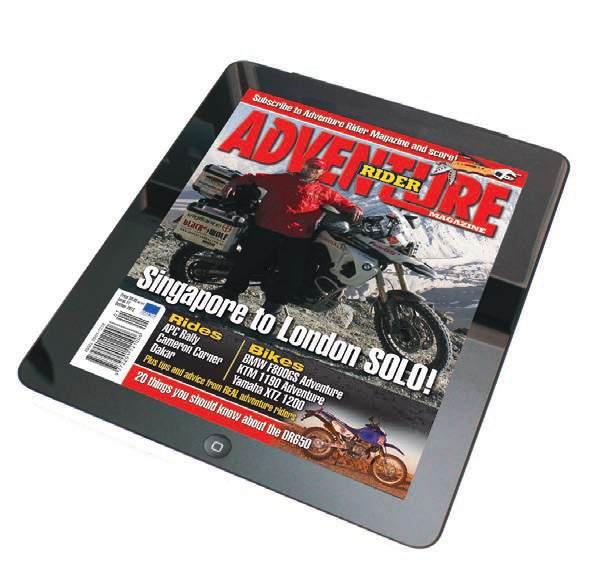
Words: Miles Davis
Body position and weight distribution are two main components of riding that will assist you in being able to make your motorcycle go exactly where you want it to go and how you want
it to get there. Of course you’ll need to combine this with other skills such as throttle, clutch and brake control and line selection, and also practise to master the right position for each situation.

At the end of the day you’re looking for balance. Balance equals more control. Optimum body position will provide improved traction, cornering and overall control.
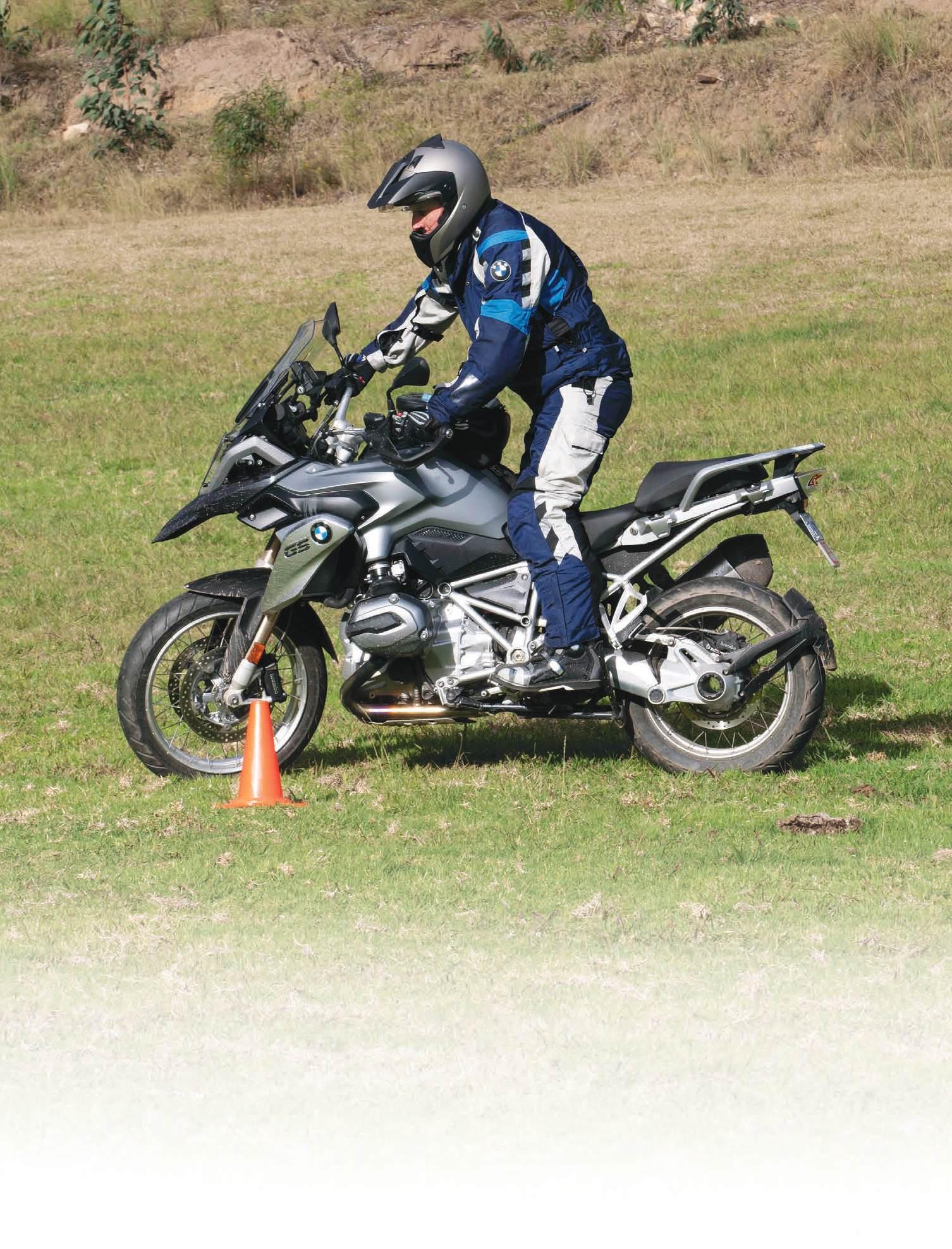
Many non-riders think you just sit on a bike and twist the throttle, but most of us know there’s a lot more that goes into riding a motorcycle well. Really good riders are very active on their bikes, always adjusting their body position and input to the handlebars and footpegs. Sometimes this is very obvious and sometimes it’s so subtle you can’t tell.
Adventure riders come from all sorts of backgrounds and have a broad range of riding goals. Some are very relaxed when riding off-road and are happy to sit down much of the time, while others are more into attacking off-road terrain from the standing position. At the end of the day you need to know what suits you based on a few factors – your bike, the remoteness of your ride, your level of fitness and even how much you want to risk your bike or body. You don’t need to be the fastest rider out there, but it’s a very reassuring feeling to know you have a good grasp of the right skills to use when required.
The first thing to think about here is if you were to stand beside your bike with the sidestand up and simply hold it with one hand on the grip, you’d notice it doesn’t take much effort or strength to hold it up when it’s vertical. But to turn, motorcycles need to lean, and this is where correct positioning can make or break this nice, neutral balance.
As a rider you have forward-toback and side-to-side weight distribution to think about. You need to think about when you need to sit and when you need to stand. Then there’s the blending of all of these movements in a smooth, instinctive way to get the ideal result. This takes a lot of practice and can take many years. If you’re always thinking about your riding this way you’re probably always improving, which is part of the buzz of riding for many riders.
The standing position is typically used for any off-road terrain that isn’t relatively smooth. If you stay seated over rough ground you’ll immediately become a passenger because with your bum on the seat you have a high centre of gravity. Your weight will be over the back wheel and you’ll feel every bump though your body, losing your ability to move your weight around effectively for maximum control.
If you stand in what is known as the central standing position all your weight is through the footpegs and this gives you a lower centre of gravity.
What does this all mean, you might be wondering?
When you’re standing on the footpegs in the centre of the bike you can work as one with your bike, using your arms and legs as extra suspension, complementing your bike’s suspension.
Standing up will allow you to move your weight forward as you accelerate and backwards as you brake, and that really gives a lot of extra control as well as saving a lot of energy.
When standing you can also lean forward up a steep rise or alternatively push your weight towards the rear on your way down to keep the bike well balanced.
Cornering is an interesting one. Whether you’re riding on- or off-road there are many techniques. But let’s just say many road riders lean off the inside of the bike because the high grip levels make this possible. But don’t try this off-road or you’ll taste dirt! This is because the grip levels are much lower. Weighting the outside of the bike through body position and footpeg pressure can create massive traction benefits and give a lot more cornering control whether standing or sitting.
There are six main points that will assist you in getting into the correct standing position. u
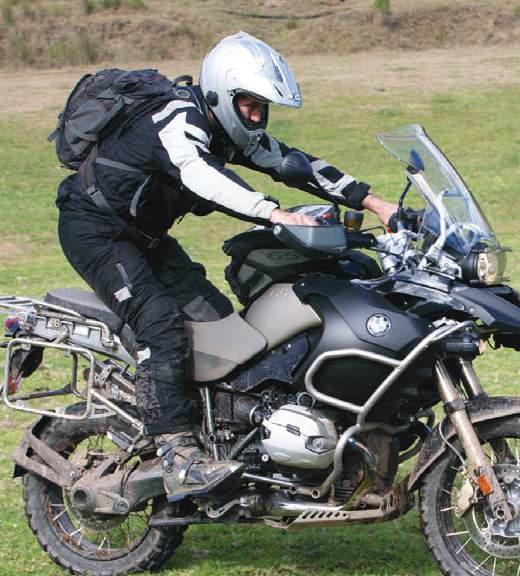

v Position your feet so the footpeg is roughly in the centre of your foot for balance.
v Have your legs slightly bent and lightly gripping the motorcycle from your ankle to your knee for increased control.
v Arch your back over forwards not straight for comfort.
v Keep your elbows up for extra control.
v Keep your head up and looking forward, roughly over the handlebars for optimum vision.
v Avoid the ‘death grip’ and try to have one or two fingers over your clutch and front brake at all times for efficiency and easy, subtle control inputs.
For adventure riding there will always be a compromise between standing and seated position, but you’ll find over time and with practice the standing position will become quite natural
and comfortable. Once this happens it’ll become second nature to you when to stay seated and when to stand.
You could almost put money on it that we have all been guilty of overdoing it with the packing at some stage. This is one point you need to put some thought into before heading off. Of course there are essentials you need for your adventure, but if it’s just a luxury that’s going to add weight to the wrong area of your bike, you may be better off without it. The difference between riding a nude bike versus an overloaded bike off-road is massive and multiplies as the terrain becomes more challenging.
One of the main problems we’ve seen with carrying luggage is having way too much piled up on the rear, hindering how far back you can get

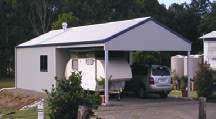


your body weight. Also, if you’re taking panniers, make sure they’re packed with similar weight on each side. The more challenging the ride, the more important it is get your luggage packed properly.
You and your bike are a team. You need to feel comfortable and balanced in a range of situations. If standing feels alien to you, it makes sense to work on it so you have it in your bag of tricks when needed. Find an area where you can practice slow-speed exercises, see how much you can move forward, backward and side to side. Make a little obstacle course and practise. Start off fairly flat with turns, then throw in some slopes and work your way up from there. For inspiration get on YouTube and watch some trials, enduro or even BMX competition.
Happy trails!

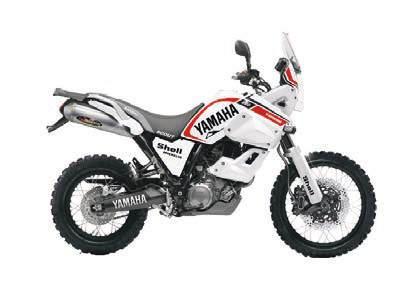
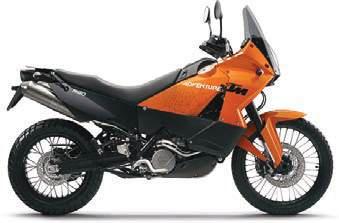




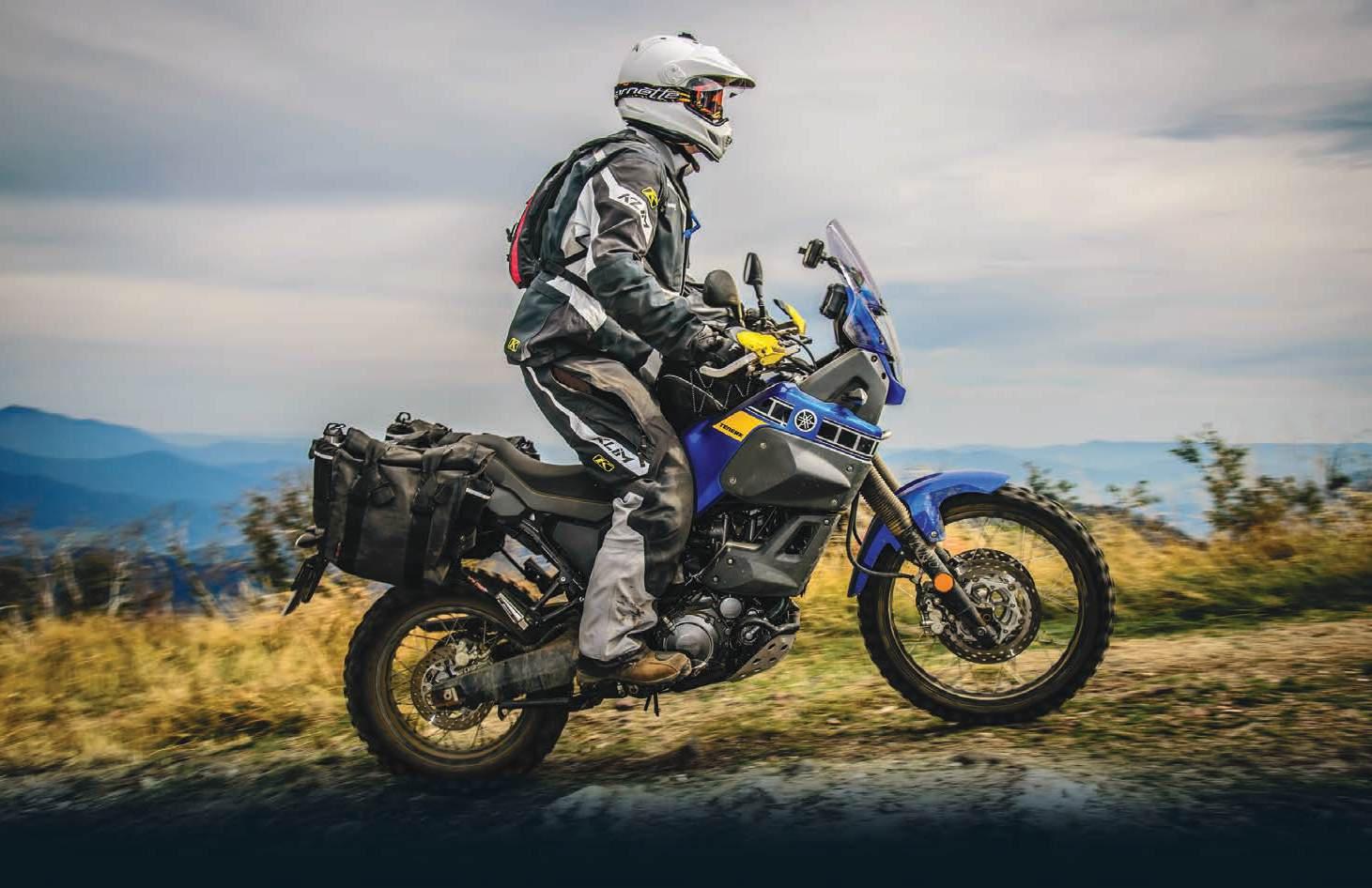
So, you’ve bought a new bike. While there are many modifications you may have in mind, or perhaps a few personal touches to make that bike truly yours, there are few changes that will bring the rewards of improved handling.
The standard suspension package on most current motorcycles has seen the benefit of an evolutionary process that has made the modern bike a far more agreeable, friendly beast. Longer suspension travel, improved ground clearance, easier steering and greater impact absorption have widened the scope for both application and type of terrain that motorcycles can now negotiate. Part of this evolution has been the provision of greater
levels of adjustability. We now have the ability to tune the bike to suit our intended tasks or personal preferences. Unfortunately for some, all this adjustment adds an unwanted level of confusion, but it’s really not so hard to understand. So, where do we start?
These days most bikes’ stock suspension set-ups seem to favour a rider who weighs between 75kg and 85kg, and are sprung and damped accordingly. If you fall outside this zone, there’s no need to worry. There are aftermarket springs available for most bikes and rider weights. Damping can also be tailored to suit individual needs.
If you’re lucky enough to fit the
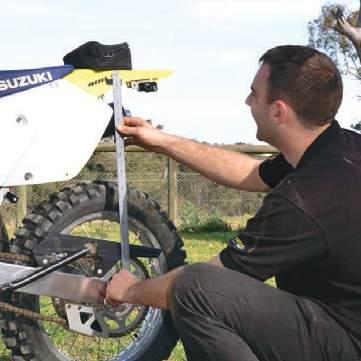
weight category that the bike was set for, or you have procured the appropriate springs, the next step is to optimise the set-up to suit you.
The fork springs should initially be installed with five millimetres to 10mm of preload. The shock spring should have between 10mm and 14mm. Now we set the ‘sag’. Starting with the rear of the bike, we use three measurements to determine the correct sag and see just how suitable the spring is for our application. Consult the specifications page in your manual to determine the amount of rear-wheel travel your motorcycle has.
v Place the bike on a suitable stand so the rear wheel is unweighted and can fully extend.
v Measure from the rear axle to a point on the back of the bike that is as close to vertical as possible (a piece of tape on the rear guard works well).
v Note the measurement. That measurement is your free sag.
u


1
v Set the bike on the ground and have the rider get on and assume their normal riding position. This should also be done in the complete riding outfit with all additional gear –bumbag, CamelBak, fuel load, camping gear, etc. Fuel levels are best set to halfway as they’re variable. v Measure between the same two points as used for free sag. This measurement is your rider sag.
The difference is… We’re generally looking for the bike to settle between 30 to 35 per cent of the rear-wheel travel when fully laden.
For example, if your bike has
300mm of travel we are looking for 90mm to 105mm of rider sag. This allows for a tuning range to suit your application or hard/soft preference. With less sag the bike will steer quicker, but with more sag the bike will generally be more stable. Most people will start with 100mm and adjust from there. The sag will be adjusted by moving the preload collars on the rear shock up or down and remeasuring until the desired figure is achieved.
This measurement is taken using the same two points as we used for our first two measurements, only this time the rider is off the bike and the bike is held upright, allowing the rear to settle under the bike’s own weight. Ideally the static sag should be between 10 per cent and 15 per cent.
So on a bike with 300mm of travel we’re looking for between 30mm and 45mm of static sag. If your measurements fall outside this range then your spring is not correct for your needs and should be replaced.
Important note: static sag is an indicator only and not a tuning point. If your spring is not quite right, but you can’t replace it immediately, don’t compromise your rider sag to try and achieve a more appropriate static sag measurement.
2 u

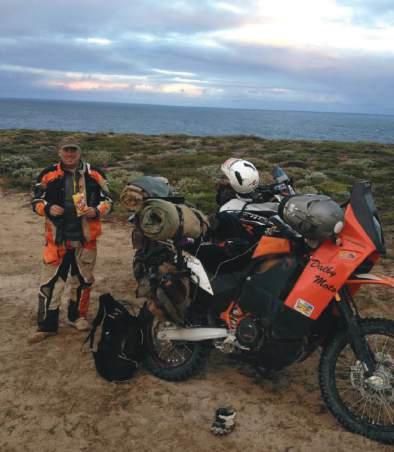

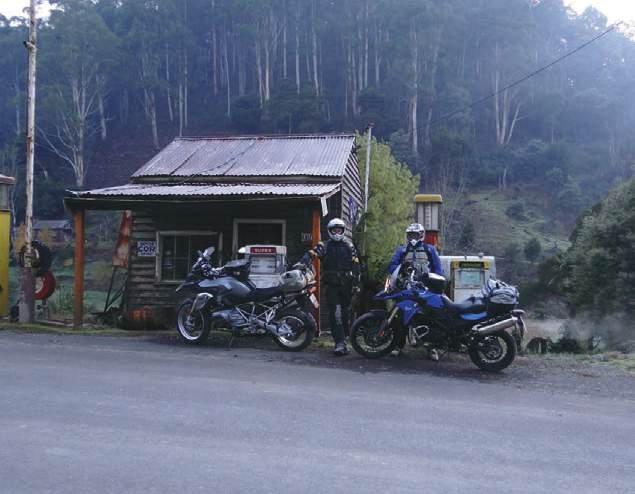
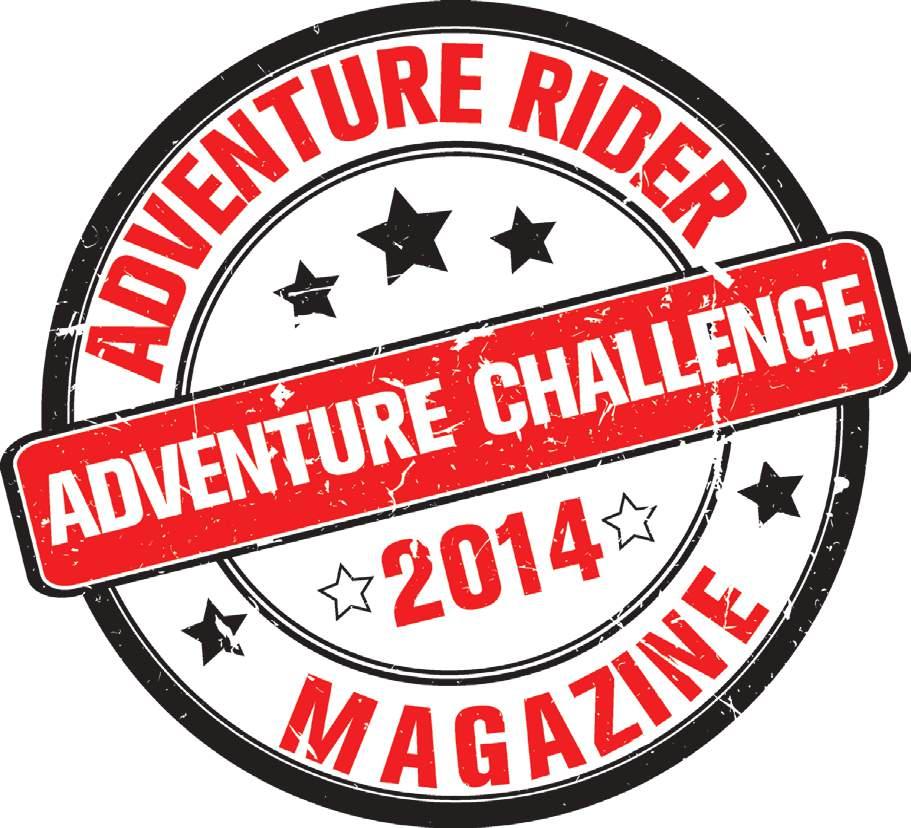


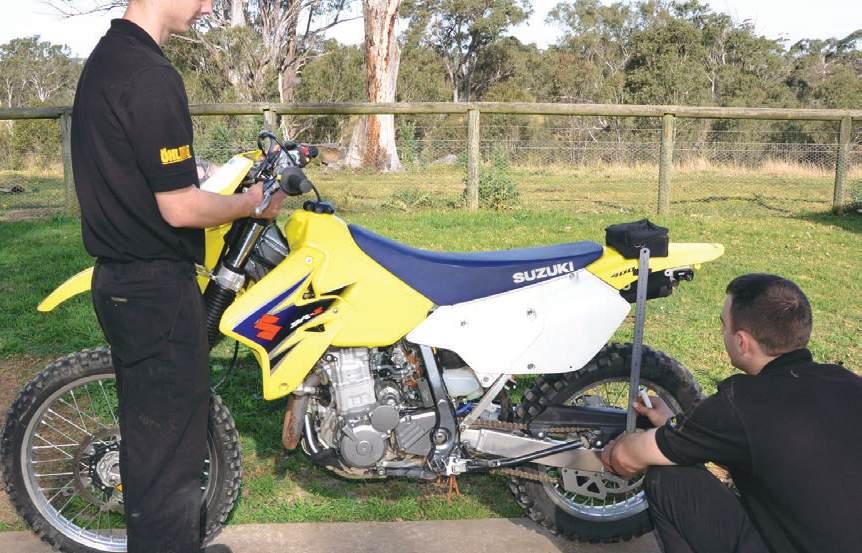
Step 3
I personally consider front sag to be fraught with inaccuracy due to the friction and binding associated with the telescopic fork, and rather than a measurement, I prefer a dynamic tuning option. By that I mean, “ride the bike”.
Your spring preload will determine the final ride height of the bike and will be relative to braking performance as well as initial feel.
Too little spring preload and the bike will dive excessively under brakes. Too much and the front will ride high, producing slow steering and being more prone to wheel deflections from square-edged bumps. The most important thing here is to achieve a balanced feel and have the front work well with the rear of the bike. Some bikes, like KTMs and Husabergs, have external preload adjusters. Others can be adjusted internally using spacers or preload shims.
reaction or the recovery. Sadly, we tend to notice the reaction more than the initial action, creating confusion in the diagnosis of the problem incurred.
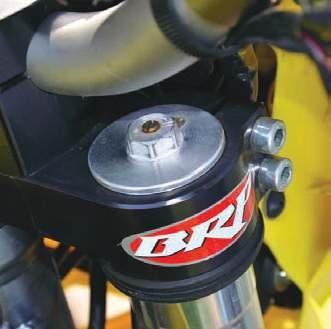
So let’s simplify this. If a fork didn’t compress, it wouldn’t rebound.

Most bikes have adjustable compression and rebound damping these days, allowing changes to the level of comfort, control and traction. The greatest mistakes people make when adjusting their damping is with the rebound circuit. If we view this logically we will find that compression is the action of the suspension when an impact is experienced and the rebound is the
wheel movements that are more likely occurring due to the compression phase. If the compression is too hard we’ll experience wheel deflection due to the lack of compliance. If the compression is too soft we’ll see the suspension move too far through its stroke, storing excess energy in the springs as a result. This energy will have to be released on the rebound stroke and excessive movement will occur.
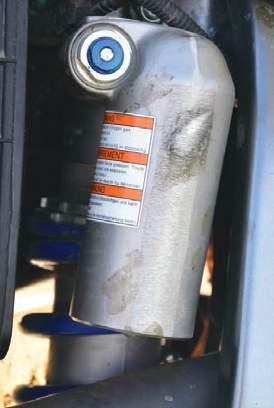
Above left: Fork Compression Adjustment. Above right: Shock Compression and Spring Preload Adjustment.
Fork Rebound Adjuster. Rebound Adjuster.
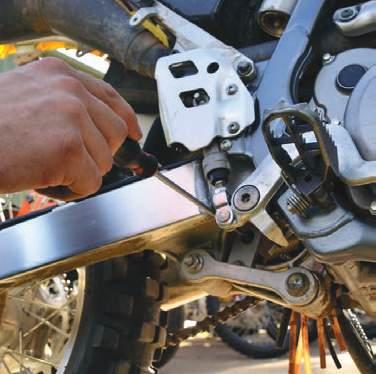
As a fork or shock compresses, energy is stored in the springs. This energy needs to be released and this provides the mechanism for the suspension to reset itself, ready to handle the next bump or just to get the wheel back on the ground to restore or maintain grip.
All too often people slow the rebound in an effort to stabilise
Knowing this, it makes perfect sense for us to address the compression first before touching the rebound adjusters. Ride the bike and adjust the compression until the desired feel is achieved. Once you’re happy with this we can look at the rebound. Be aware: you’ll find a bike with the rebound a little quick will function much better than one with the rebound too slow. Ride the bike and speed the rebound up. As the wheel reactions get quicker, your grip will improve. Go too far and the bike may start to feel a little loose or tend to wallow. Come back in on the adjuster until the best blend of grip and control is achieved. Now you’re set. Note the position of the adjusters for future reference.
All your testing should be done on a familiar track at a moderate pace.
As your bike gets dialled in and you feel more comfortable you can increase your speed (within reason). Remember: nobody ever won a trophy during testing.

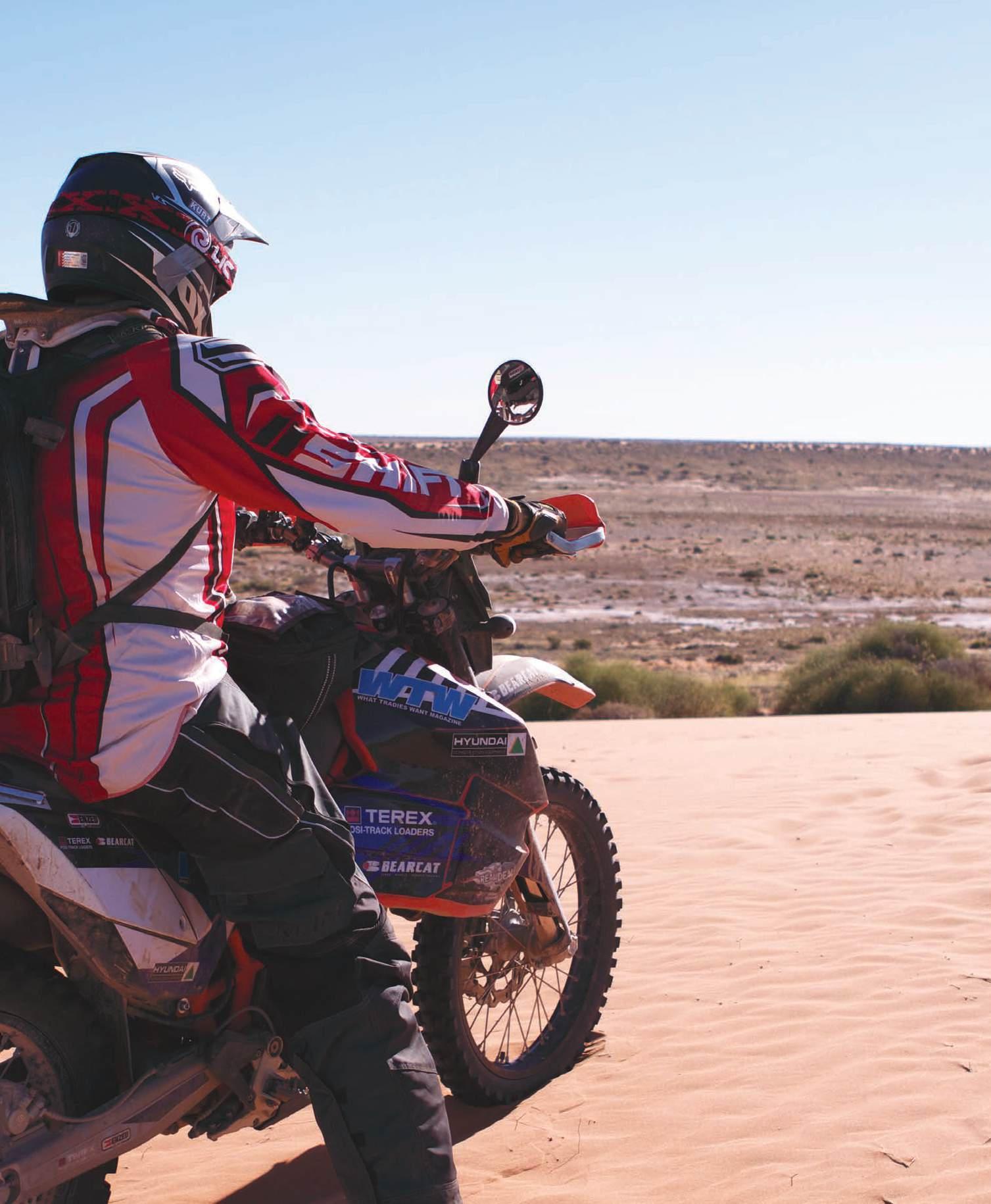

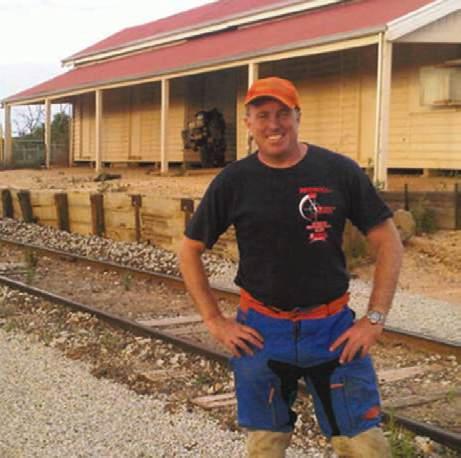
APC Rally owner and organiser John Hudson knows a thing or two about how an adventure bike should work. Not only does he organise Australia’s premier adventure event, but he’s completed a few Australian Safaris. So when Homer wants to offer a few tips, we’re keen to listen. This issue he shares a few thoughts on basic setting up for adventure riding.
ost bikes are pretty good these days, but even the best and most expensive bike will benefit from some personalisation.
Because we love our bikes, there’s a tendency to buy the brightest, most expensive, most heavily marketed items and bolt them on, convinced they’ll make us better riders. No accessory will do that. Good quality accessories can allow a rider to be comfortable and to ride with less fatigue, and that’s a huge gain in itself. Before searching for the biggest boost in horsepower or the most expensive suspension mods available, a rider needs to set up his stock bike to work at its best. Once he’s achieved that he can start assessing where improvements might be made.
Here are a few things to think about when you grab your bike and start tuning it for your next big ride. We’ll start from the ground and work our way up.
Good tyres are probably the single most effective performance enhancer available to any bike. Choosing the right tyre for a specific surface is a science these days, but tyre manufacturers offer plenty of advice on the recommended use for each of their models, and you can start there. Experimenting will show which tyres work well for you and the way you ride, and which don’t. I ride big KTMs – 990s and 1190s – and I’ve found Motoz to be the best for me. Whatever brands, compounds and tread patterns you decide to try, one thing you can be certain of is the bike
manufacturer’s recommendation for the size of tyre you should be running. Have a look at your owner’s manual and try and stick with the figures there. When you have everything settled and know what you’re looking for, a different width or profile tyre might be an option, but until then, you’ll be best served with the tyre size the bike was designed to use.
Suspension is one of those areas where everyone has an opinion and all kinds of advice circulates about various mods. The first thing to do is find out how your stock suspension performs. Set the correct ride height and static sag as outlined in the workshop manual. If you can’t get those two figures within the parameters shown in the manual by adjusting the spring preload, it means you have the wrong spring for your weight. If that’s the case, no amount of fiddling with clickers or paying for expensive valving is going to help. Once you have the components performing as they should, what are you going to try and achieve? More comfort? The bike to perform better at speed? Maybe landing off supercross triple jumps is a little tricky? Don’t laugh. If you don’t know what you’re trying to achieve, the suspension tuners won’t have any hope of getting it for you.
Another tip specific to adventure riders: you’re never going to get the suspension perfect. Your luggage loads are likely to vary a great deal, road surfaces will range from highway to choppy rocks and mud, and on the big bikes the difference between a full fuel load and an almost empty tank can be 25kg.
No matter how much you spend, you’re going to have to compromise in some situations. Aim for the best all-round result with the luggage and fuel load you have most often.
A lot of riders think because their bike’s louder, it has more power. Plenty of aftermarket pipes don’t actually increase a bike’s horsepower. Some do, but a lot, especially the less-expensive offerings, just make it louder. That’s not to say there’s no advantage in the cheaper pipes. Overall mass is a problem on big adventure bikes, and a pipe may be loud, but it may also be several kilos lighter than a stocker. Once again, identify what you’re trying to achieve before you go bolting on bling. If you’re struggling with the weight of your bike, an aftermarket pipe might be part of the fix. If you honestly feel your bike is short of horsepower, maybe you


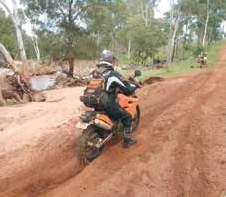
bought the wrong bike, but if that’s what you want to achieve, ask the salesman for facts and figures. And don’t forget a pipe is at the end of a carefully controlled fuel system. If you make a big change at one end, you may need to make big changes elsewhere in that system to gain a benefit. Fuelinjected bikes mostly deal with that, but with carburettors there can be a lot of tuning to get benefit from a change of exhaust.
I can’t think of a better title for this one, so comfort will have to do, and it’s an important issue.
A comfortable rider will suffer far less from fatigue than an uncomfortable rider, and less fatigue means more endurance and better concentration, so it’s a big safety factor as well. Things like wider ’pegs, heated grips, screens and even seat shapes and covers can all play a big part in rider comfort. Good
apparel can make a huge difference, keeping a rider warm and dry. And don’t forget boots. Motocross boots give good protection, but they’re not waterproof, and they’re not too pleasant for walking around sightseeing or to and from the bar. There are some really good adventure boots around offering good comfort and good protection. Have a look at your local dealer and see what’s there. The same with helmets. A motocross helmet is hell in the rain at 100kph, and it’s noisy even when the weather’s good. Try some dualsport helmets. You’ll be amazed at the difference. Under this same heading go things like handlebar and footpeg position, luggage placement, and even lighting. Riding along at night, squinting like a horny baboon behind a mango tree will wear you out really fast. Good lighting makes a huge difference to comfort, and therefore safety.
See you next issue!

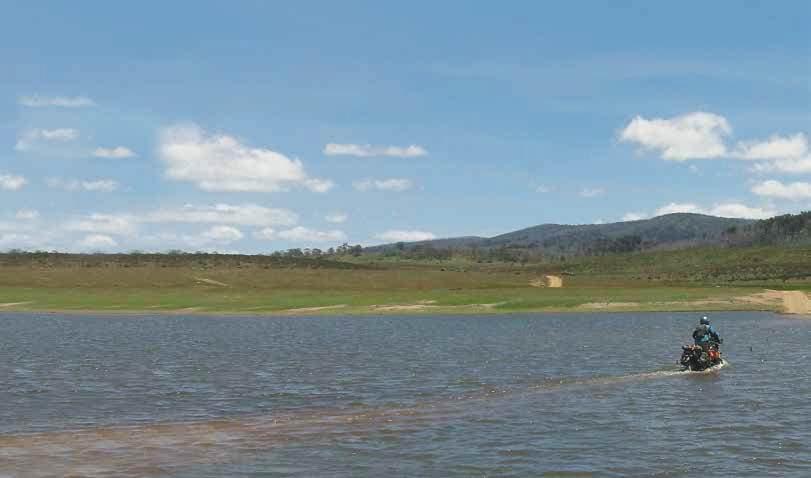
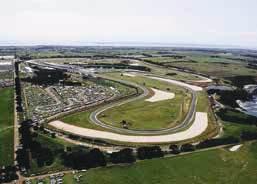
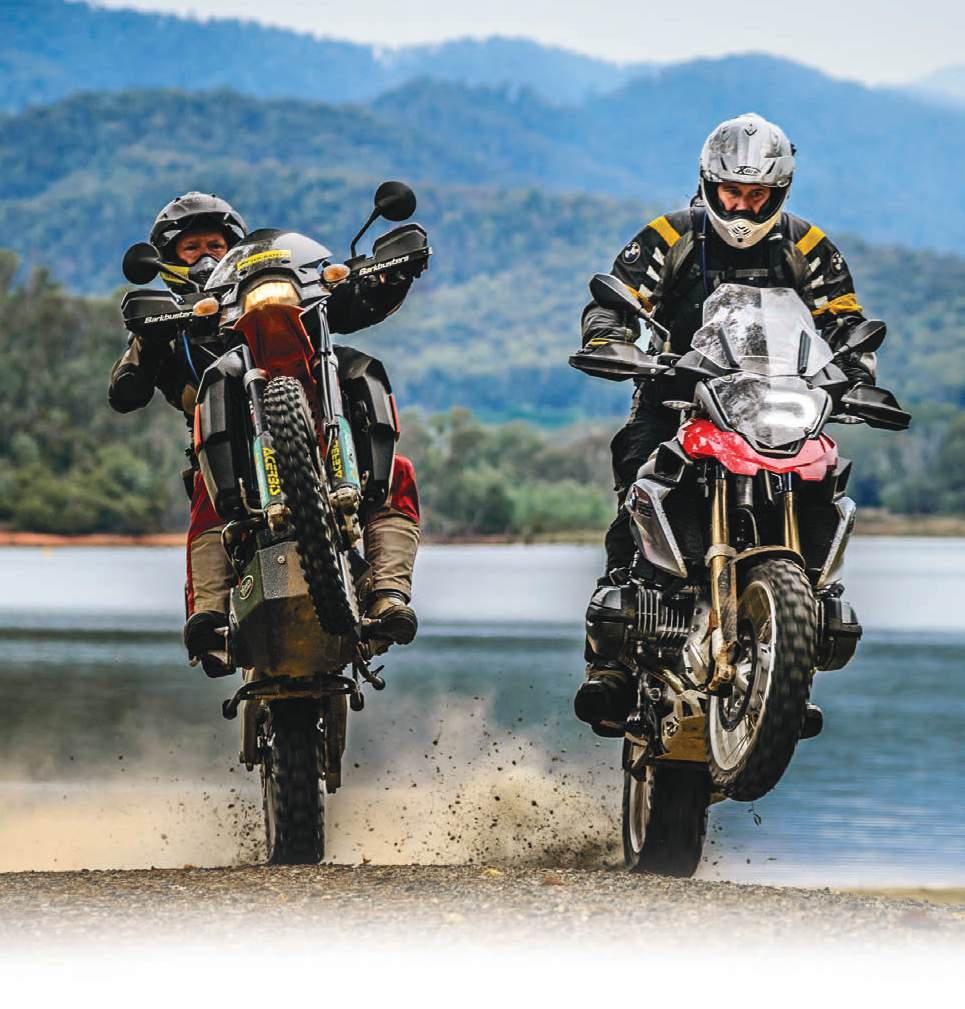
The hills around Bright in Victoria came alive recently, when some great people got together to make a dream ride a reality.
Having ridden with Brendon Roberts from Triumph in the past, I knew he was a handy bloke on a bike. So it was surprising to see him on his best behaviour, calmly punting the big 1200 Triumph Explorer through a series of Victorian high-country trails. I put it down to the proliferation of ruts and mud holes, keeping the bigger bike at bay while I tucked in behind on the more nimble 800XC.
I carried that illusion for a couple of kilometres, right up until he disappeared sideways around a tight corner and the air in front of me filled with an enormous shower of roost. The howl of an angry triple
accompanied the cloud of airborne debris and it was evident Brendon was back to his usual self.
It was one of those times where you couldn’t help but grin in your helmet. It was great to be on a bike, filling in time with a lateafternoon trail ride while waiting for the Touratech Travel Event to kick off later that night.
With 50 bikes surrounding the Bright Chalet on our return, and the promise of a smorgasbord the likes of which you don’t often see on an adventure ride, it was easy to settle into the swing of things. Mick McDonald from Compass
Left: Huffy and Miles on their way around Lake Buffalo.
Expeditions ran a presentation on his life-changing trip across the Road Of Bones and it only took a cursory glance around the room to see he had a captivated audience.
With images of untamed landscapes and Mick’s entertaining account of his travels, the time passed all too quickly. An inspired crew then set upon Pedro’s rear tyre because it was somewhat lacking in the inflation department. Full of enthusiasm, Pedro had ridden down from Sydney on his KLR with only the clothes he was wearing. He’d rung to say he was running late due to a flat tyre, so Glen ‘Huffy’ Hough grabbed the keys to the ute and headed out to pick him up. Ian Rider got stuck into the tyre change on his arrival while Glen made an additional stop at home to find a spare pair of riding boots and some warmer attire he could borrow. It was a good indication of the quality of the group and I was confident we were in for a great weekend.
As the night was winding down at the Chalet, a courtesy bus appeared and I tagged along to see the sights of Bright. Later I looked above the bar in the foggy, strobe-lit surrounds of the local pub and saw a picture of Huffy on a speedway sidecar taking pride of place. Curious, I asked him about it later and he modestly mumbled something about a national title in years gone by. Typical of blokes that are genuinely fast, if I hadn’t seen the photo that night, I probably never would have known.
After a buffet breakfast fit for kings on Saturday morning (a person could get used to this) it was time to head out for a riding clinic run by Miles Davis and Chris Urquhart from BMW. With a PA system wired to his helmet, Miles put the
new 1200GS through its paces and ran through some great principles for riders of all experience levels.
The entertainment didn’t stop there. Property owner Ian McGillvray punted his ag bike up an impossibly steep hill for the enthralled onlookers.
Another talking point was the brief stumble at the end of a long line of parked bikes that created a domino effect. It was one of those things you only expect to see in the movies. Watching the bikes tip one by one, I grabbed a 1200GS to stop the procession, which numbered four by this stage, before it reached the portapotty and things really turned to bent shifters.
With bikes resurrected and new skills to test out, the group proceeded on a guided run
over Mt Porepunkah before splitting up for the afternoon’s trail and road options.
Touratech importer Robin Box took a group to Mt Buffalo via the tar, while Miles led a ride up over Goldie Spur and around Lake Buffalo. A few of those on the trail section openly admitted to having limited dirt experience on the big bikes, so the rocky trails were enough of a challenge to keep them paying close attention. It was great to see them buzzing at their newfound dirt skills by the end of the day.
Brian from GPS Oz made his way down from Sydney for Saturday night’s GPS presentation. Once again, there were plenty of attentive listeners as he ran through the tricks and traps of navigating by satellites and an LCD screen.

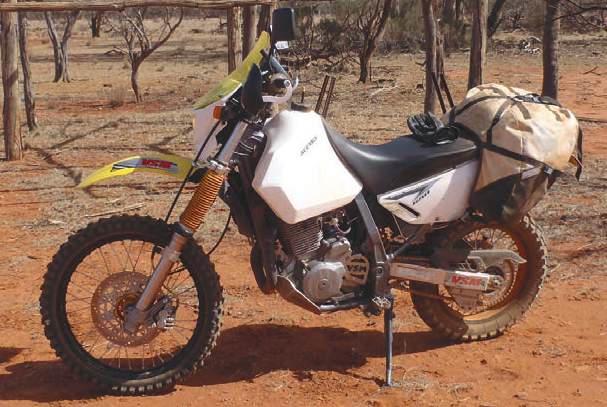
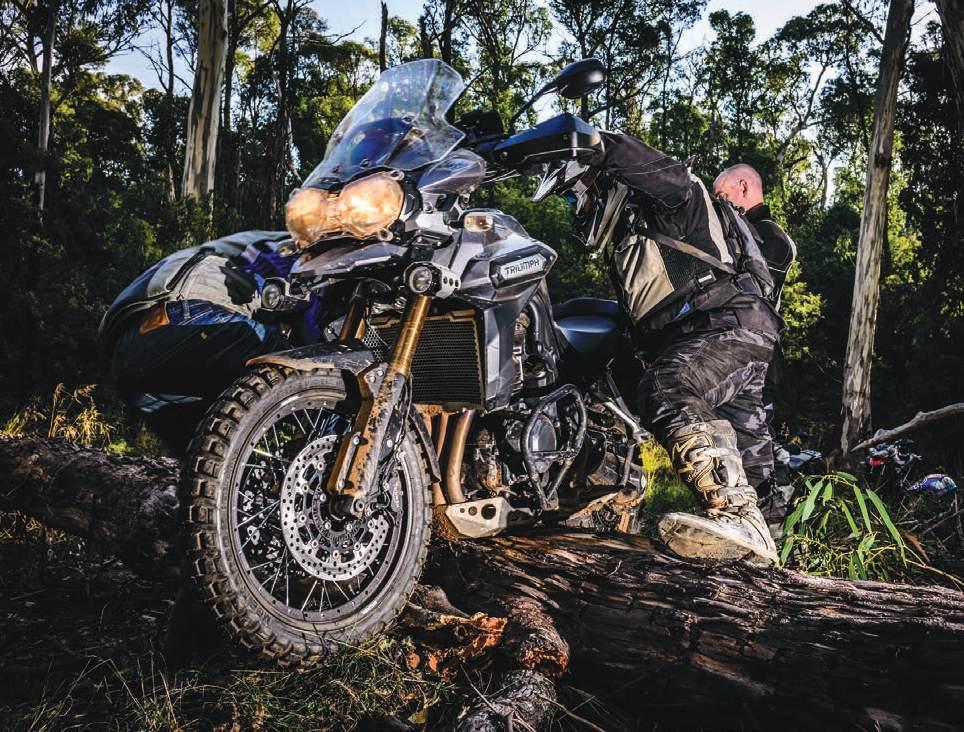
A thick mist rolled in for the start of Sunday’s ride and it was a cautious start over the slick tar of the Great Alpine Road as it wound its way south past Harrietville. Brian had loaded the day’s route into riders’ GPS units so it was a nicely spaced group that hit the tractable dirt near Mt St Bernard for the start of the Dargo High Plains Road.
Clearing skies and unfolding high country vistas made for a memorable journey down to the adventure riding hub of Dargo. After a quick break in the small township, I was one of the last away as Robin pulled on his helmet to ride sweep.
“You know what TK used to say,” he muffled, “more than one bike leaving at the same time and going the same place equals a race”.
I looked over as his daughter Lisa laughed on the pillion seat and figured he was mucking around.
Just to be sure, I gave the Tiger a bit of throttle on the way out of town, but seeing the twin lights of the GSA drop back in the mirrors I thought nothing more of it. Cruising along at a respectable pace, I was enjoying life and the mountain scenery when the big BM swept past me on the outside of a corner, Lisa perched nonchalantly as though it’s a regular occurrence (it probably is).
Tackling a few technical trails with Brendon and Mark from Triumph before the start of the event.
Robin was beaming at the turnoff to the dirt a little further on, revelling in his short spell off the sweepriding leash.
Flowing forestry roads on a gorgeous autumn day followed, with terrain varying from muddy ruts to pockets of powdered bulldust. That may not be unusual, but the fact that they sometimes occurred within a 100m stretch of each other was enough to keep everyone on their toes.
We stopped for lunch at the Dogs Grave camping area and continued our way along a myriad of winding dirt roads until we reached the bitumen near Omeo for the run over Mt Hotham.
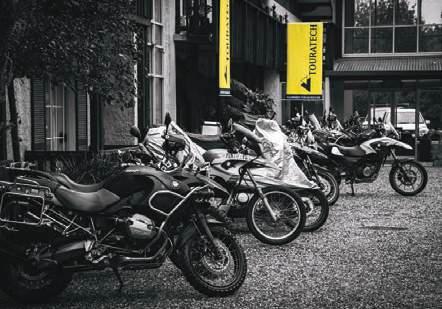
Dealing with adventure riders from all walks of life on a daily basis, the team at Touratech Australia established the Travel Event in response to a growing interest in adventure travel and the requirements to successfully get out and explore the world. It was clear from the outset a lot of work went into the event. The end result was a variety of riding options, spectacular scenery, practical presentations and, to top it off, everybody was well taken care of at a great venue. Stick a bunch of enthusiastic people into the mix and it is not surprising the event was a big success.
With plans already underway for next year’s event, I’m reserving my place now so I don’t miss out (on the comprehensive dessert buffet, among other things).
Reserve your place at the next Touratech Travel event now. It’s on April 4-6, 2014. More info: www.touratech.com.au

Every now and then you strike a place at exactly the right time so it almost glows. Sitting high on a grassy knoll overlooking Mt Hotham was one of those times and it was hard not be content with the world. The afternoon sun scattered patches of light over the panorama below and fresh mountain air filled your lungs and made you feel alive. It was a fitting end to a great few days in the Victorian High Country, and one of those times where you wouldn’t swap adventure riding for any other pursuit.
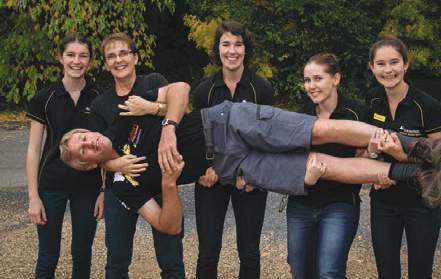

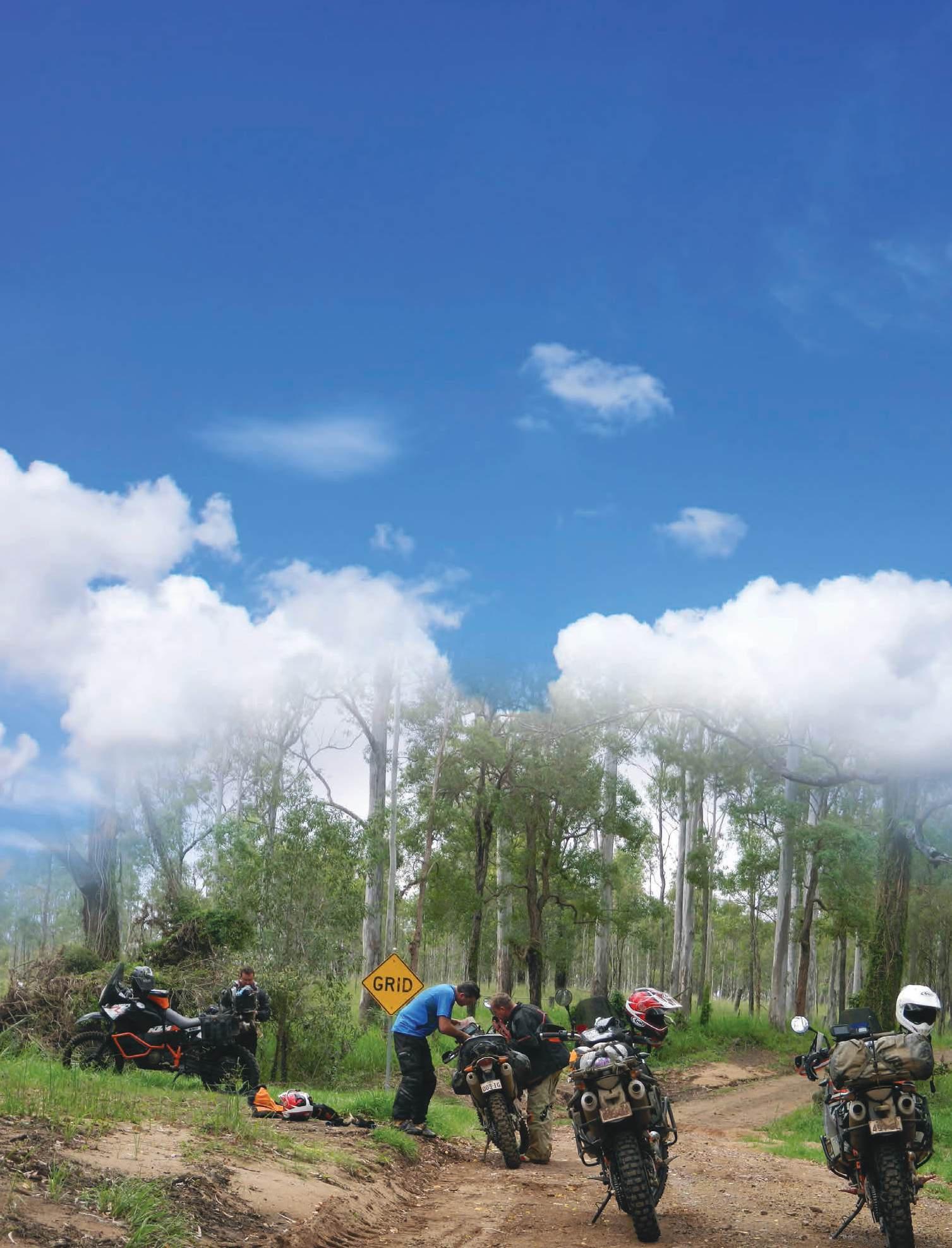
2 Day Lithgow NSW
12th-13th Oct 2013 $240
8 Day Phillip Island GP Ride
20th-27th Oct 2013 $1100
2 Day Urbenville NSW
1st-2nd Feb 2014 $240
4 Day Wisemans Ferry NSW
20th-23rd Feb 2014 $480
4 Day Brisbane QLD
20th-23rd March 2014 $480
14 Day APC RALLY
Multiple start points all over Australia
11th-30th May 2014 $1250 (early entry) no event in 2015
From the NSW coast to Cameron Corner – where Queensland, South Australia and New South Wales meet – is around 1500km and west of Bourke there’s not much bitumen, no bike shops, and bugger-all hospitals and ambulances.
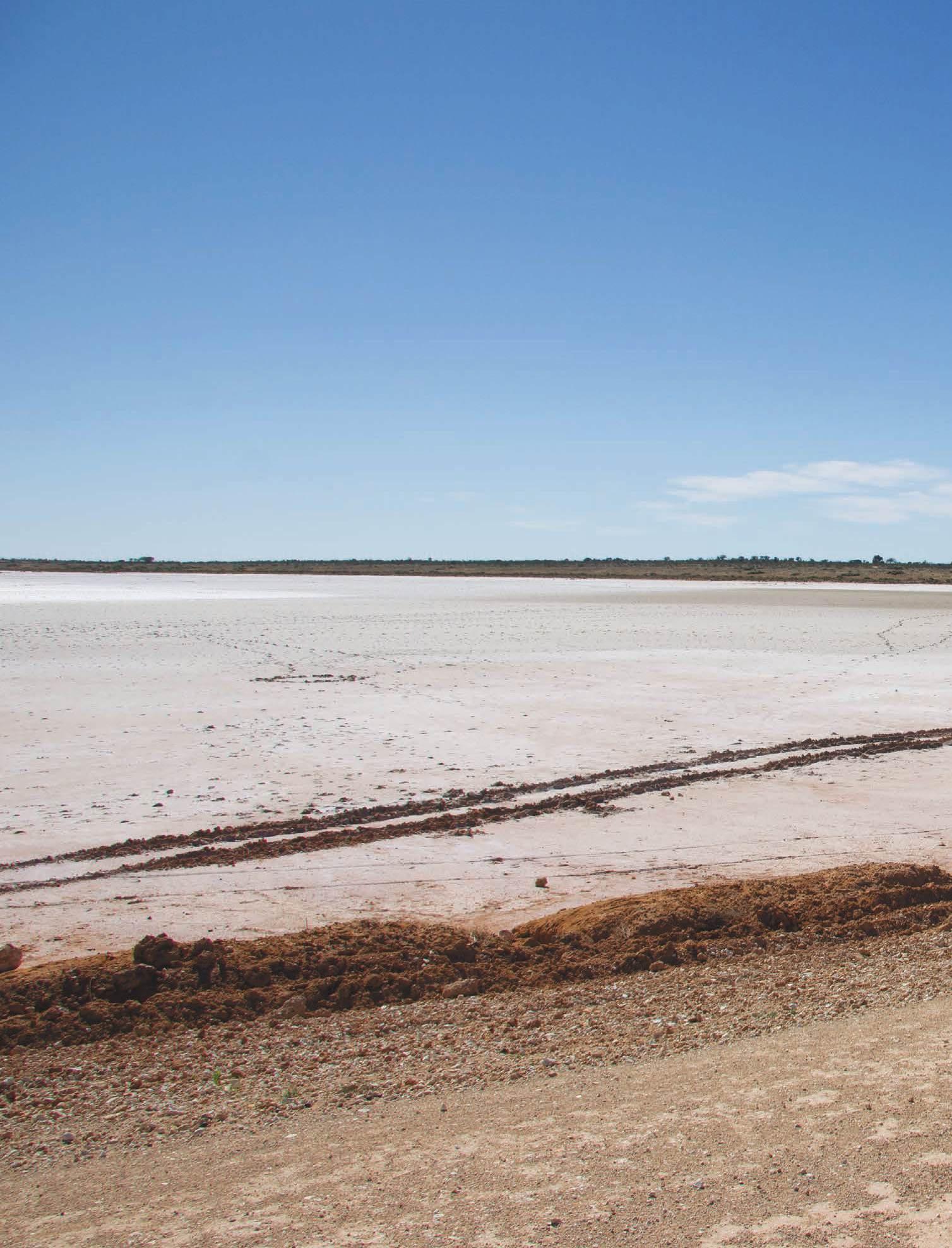
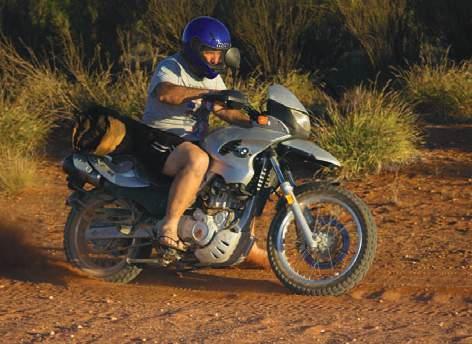
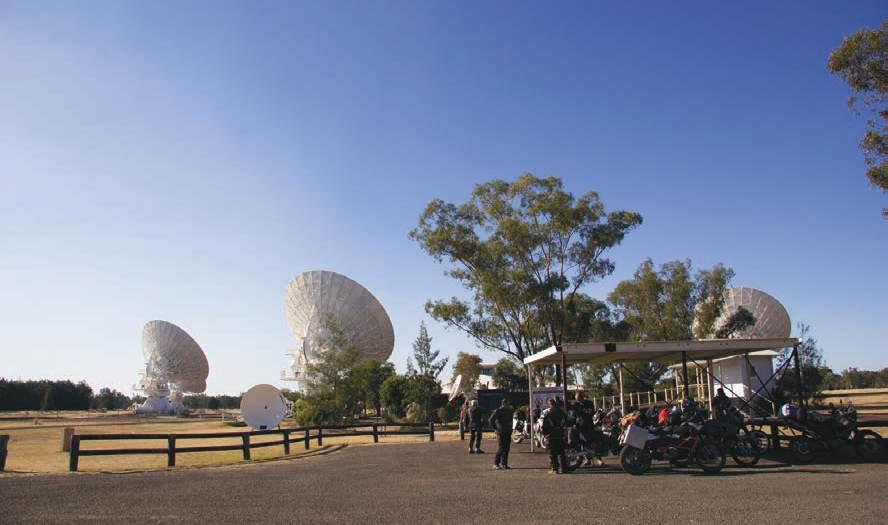

What there is a lot of is desert. Heaps of it. Huge, empty plains of red dust from one horizon to the other. For a novice rider it can be intimidating. Some salty-dog adventurers teamed up to help some less-experienced riders make the journey.
Saying someone is an ‘identity’ is sometimes a polite way of describing a bloke who’s a bit…well…wacky.
Among the Coffs Harbour bike-riding community, Gav Gill can be fairly described as an identity.
When Gav had the idea of taking a group of not-too-experienced adventure riders out to Cameron Corner, he couldn’t keep up with the people who wanted to be part of it. After a little discussion with some key players – discussion is one of Gav’s specialties – Coffs KTM came
on board as a sponsor, and in no time at all there were more riders signed up than anyone could keep track of. So nobody did.
The meeting place for the start of the ride was the ex-serviceman’s club in Coffs Harbour on April 25.
The original five-day ride would have to stretch to six, and even that meant pushing hard for the first two days.
This was a brilliant stroke on Gav’s part, because it can be damn tricky to get any group moving early on a chilly April morning. Including ANZAC day in the schedule meant

riders had only to take Friday and Monday as annual leave days to get five clear days. All were genuinely keen to show their respect at a dawn service, so Gav’s cunning strategy had everyone on their bikes just after dawn. Well…almost everyone.
A few decided, seeing as the group was going past their house or street, to wait until a big group rode past, and just tag on the back. Somehow the times were confused, so some people were sitting on coastal corners and phoning each other while the main group was enjoying its first coffee at Ebor, 140km west. And that meant nobody was really sure how many people were on the ride.The best guess was 17. Roughly. At the start.
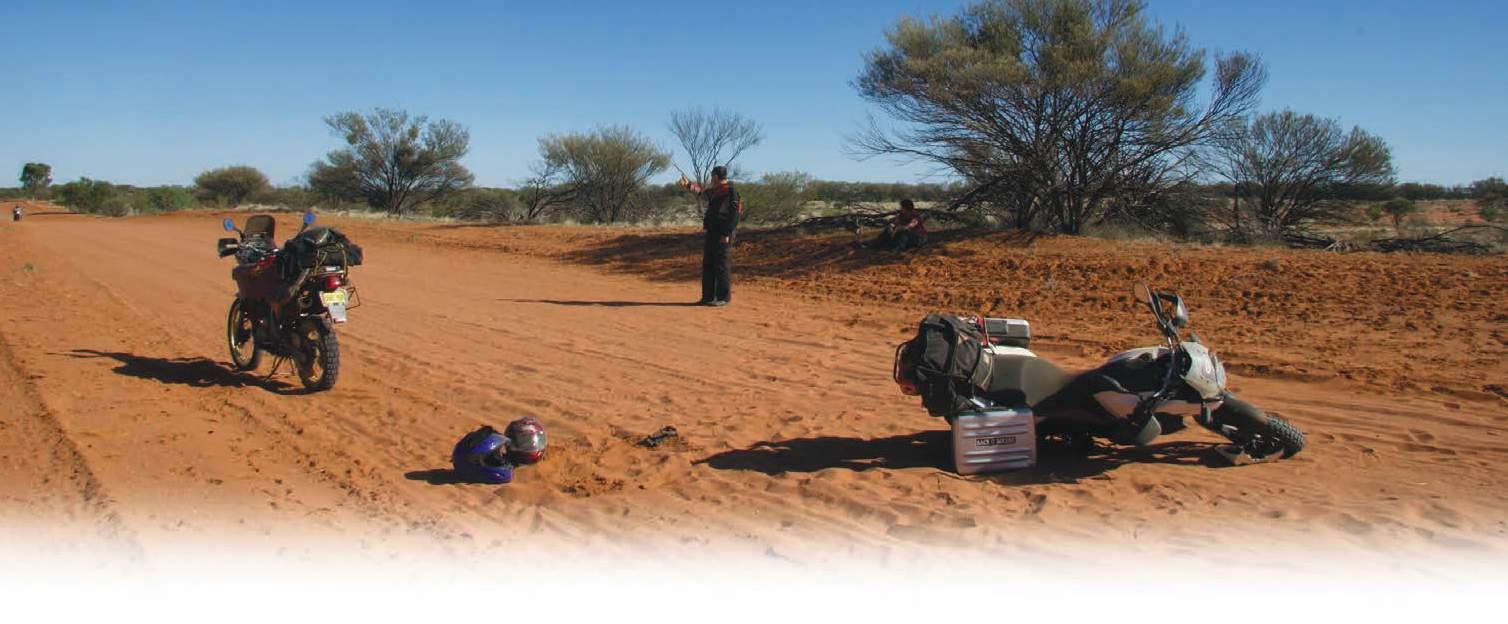
a long stretch
At the core of the group were the ‘novices’ making their first attempt at Cameron Corner. There were nine in this main group, including the only female, Karen Ramsay, on a BMW F650GS. Karen’s husband Dave roosted along on an F800GS, and the rest of the novice contingent was made up of a collection of different mounts ranging from a Honda Transalp through Super Ténérés and DR650s with the occasional KTM thrown in.
Among the Old Hands were some very experienced riders, and while the novices planned to hammer along the Kamilaroi Highway to smash distance fast, the experienced guys were planning to split away, searching for more dirt and far-flung locations, agreeing to re-join in the evenings.
The main group made its way westward, stopping to check out sights like the Glacial Area campsite near Sawn Rocks on Mount Kaputar and the radio telescope at Narrabri. It then pulled in at the Burren Junction pub to take advantage of the cabins, counter meals and two-up. The Old Hands arrived well after dark and full of stories.
The pattern was repeated the following day. The Hard Cornerers headed for Bourke while the rest of the guys went for a look at Lightning Ridge. The rendezvous was to be Bourke at lunchtime…or maybe Wanaaring. Whatever.
Bourke was the start of the ‘real’ adventure. While there were several glorious stretches of scenic dirt road between the coast and Bourke itself, there was heaps of highway and tar road, and with the big distances to be covered in the few short days allowed, the ride to Bourke was really a sprint to get to the edge of the desert. As it worked out the original five-day ride would have to stretch to six, and even that meant pushing hard for the first two days.
When you’re 100km from help in one direction, and 140km from help in the other, there’s only one option: you have to help yourself.
The persistence paid off. With minimal stress a heap of riders tumbled off their bikes and onto the banks of the Darling River at Bourke around lunchtime on the second day. The café and display at the Crossley engine – which was running when the group arrived – wiled away an hour or so on a sunny afternoon and gave everyone a chance to wonder where everyone else was. And how many there actually were.
In the early afternoon the group tightened up and continued the run west. The weather was perfect, the “road” in good shape, and all looked set for a charge out to Cameron Corner. But then there was the sand.
The challenge in a ride to Cameron Corner comes more from the distances between help than anything else. The condition of the road varies from week to week, and it can be a huge factor on its own. It can be near-highway standard and suitable for a Hyundai Getz with worn tyres, but it can be much, much worse.
Local knowledge is gold and Marg and Ben at Wanaaring shop have been helpful and welcoming to bikes for a lot of years. A phone call to Ben before leaving Bourke had elicited his opinion the road was “as sandy as I’ve ever seen it. The truck couldn’t even hold a straight line.”
The run from Bourke to Wanaaring is about 180km, and the first get-offs started about 20km from the end of the tar and continued for the remaining run to the overnight stop.
The odd fall and necessary running repairs meant many ended the day riding directly towards the huge, flaming orb of the setting sun, desperately trying to shield their eyes with one hand and hold on to their bikes in the deep sand with the other. With retinas seared and eyestrain-tears streaming down dusted faces there were some wild lines carved on that stretch.
Injuries were inevitable and two of the newbies had to find someone to cart them and their bikes back to Bourke, bringing the group down to seven. It left 15 or 16 riders…

maybe 17…who mounted up from Wanaaring on a gorgeous, sunny morning and began the long haul to Tibooburra.
In a happy change of circumstances the road west of Wanaaring was hard-packed. In some places there were rocks! Only little ones, but after the end-swapping of the day before, any kind of hard, predictable surface was welcome and the pace rose accordingly.
There were still a few sand wallows though and the first one grabbed Karen and sent her down hard. She kept smiling and said she was fine –except for a stabbing chest pain and breathing being a little difficult. Is she tough, or what?
Unfortunately her GS really copped it, and a few of the group filled in time sifting the surrounding dust for instrument clusters, rear-guard extenders, panniers and contents of panniers.
The problem is, when you’re 100km from help in one direction, and 140km from help in the other, there’s only one option: you have to help yourself.
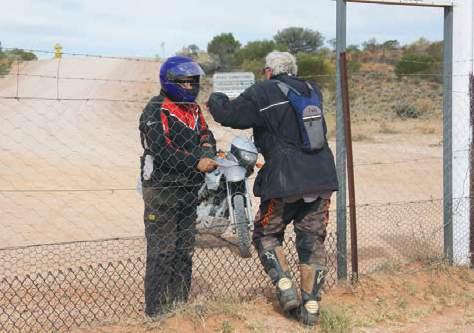
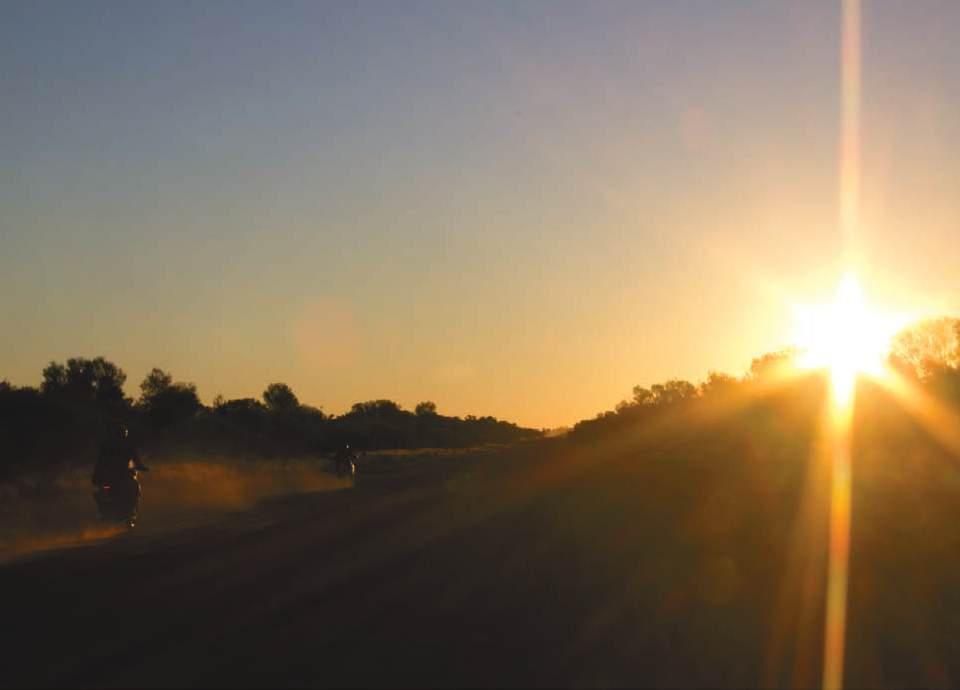
Above: Riding west at sunset is tough work out here.
Left: “You have to pay before you can cross the State line.” Pete Watson spins a yarn for Nick, who wandered around in the desert sun looking for somewhere to hand over his cash.
With a heap of bending, strapping, wiring and hurling unnecessary luxuries into the surrounding desert, Dave and a few helpers got the bike rideable and he and Karen headed back to Wanaaring. They arrived just in time to catch the truck organised by Glen and Kev, so were able to put the stricken GS on board and make it back to Bourke that same day.
It’s 240 kilometres from the Wanaaring General Store to the next fuel at Tibooburra, and that is pushing the range of a lot of carburetted bikes. So while some cruised along, dodging emus, ’roos and even camels, those with fuel-injection bolted like maniacs, keen to grind down the distance.
The desert rolled away in all
its majesty until, inevitably, the stark, black rock piles that mark the eastern approach to Tibooburra and the Sturt Desert hove into view.
From Tib there was 140km to go and the fast guys were all over it, busting sandhills, tackling rocks, and trying inviting trails that branched off in every direction.
From Tib the final run to The Corner was a clear, firm run with a few sandy corners to keep everyone focussed. As the main road approaches the dingo fence there are a few options offered here and there, taking travellers out to various campsites and points of interest.
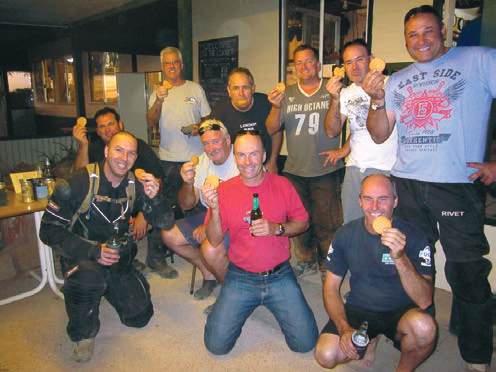
Flying high
As the afternoon wound on, the riders straggled in, each with a story and well-deserved air of satisfaction. Some of the newbies had tagged along successfully with the more experienced group and enjoyed the experience. The three still under Gav’s care were rapt at having made the distance and were busting for more adventure.
Cameron Corner put on its usual hospitality. The hot meals, cold drinks and tall stories went long into the night and even those staying at The Corner who weren’t part of the ride joined in. As the crew sat enjoying the atmosphere a bloke pulled up, unloaded an ultralight, and headed up into the evening desert sky.
The cabins were cosy, the water hot and the steaks thick. It was a fitting end to a great journey. And for those wanting more adventure, there was still the trip home.
But that’s another story.

Left: The crew enjoying the cookies Dave “Ramdog” Ramsay sent out to celebrate a previous ride.
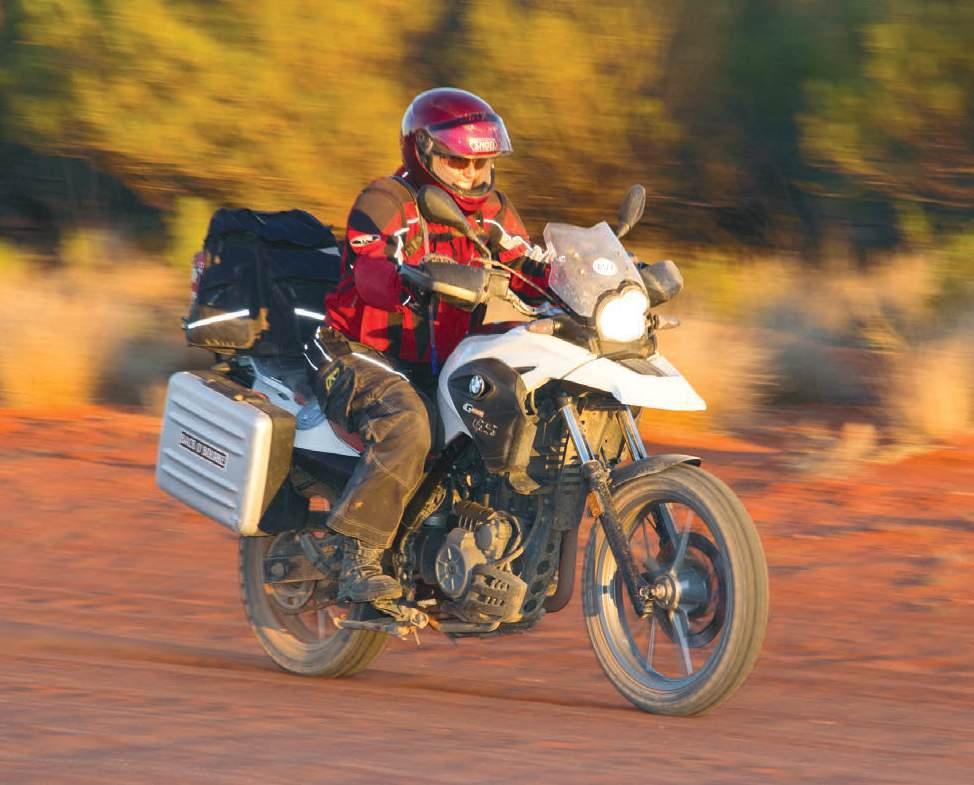
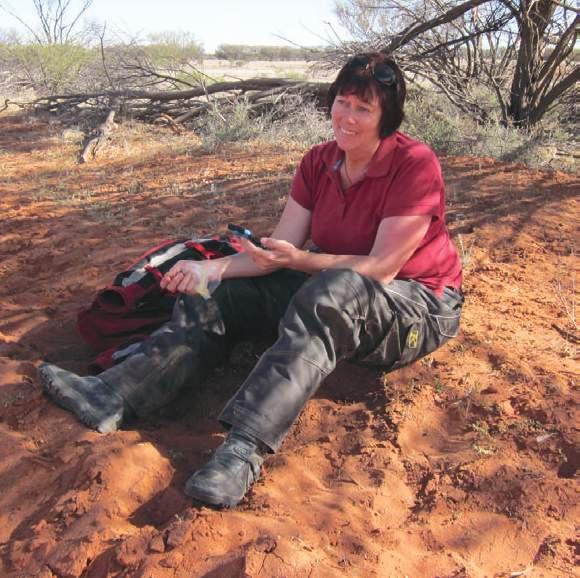
Words: Karen Ramsay
Left: Heading towards Tibooburra and straight into the setting sun. Note the teeth gritted in determination.
Above: “I’ll just see if Ewan McGregor has mobile reception.”
There is nothing quite like the euphoria of riding when everything in the universe is in perfect alignment. Heading towards Tibooburra from Wanaaring through the shrub-covered sandhills, the track stretching endlessly and the sun at my back, was bliss. I knew then that I was born to ride adventure. The euphoria was replaced by panic shortly after, but more on that later.
The idea of this column is to give a female perspective on adventure riding. Before you go getting all
excited thinking this will feature a lithe young woman in a bikini draped over a muscle-bound desert bike, I have to tell you that’s not what this is about. I hope to give encouragement to new riders, and to remind experienced riders of where they started out.
I’ve only been adventure riding for the past year or so and have some 30,000km under my belt. Being a mother of three, wife, and working more or less full time presents some challenges to my riding. Finding time to spend with the kids and meeting work obligations balanced with my eagerness to be out riding is a
constant juggling act. The fact I’m a mum has made me a cautious rider, but it doesn’t diminish my enjoyment. I ride to my abilities. As a wife, I’m very fortunate to have a husband who shares my passion for adventure riding. Any adventure is much better shared, and not only do I have a riding companion, but the two of us having a common interest is pretty special. Particularly when our children are becoming independent and we start going through a new phase of our lives. Adventure riding wasn’t so much a conscious decision for me as one that just happened because the bike I owned was capable of
handling a bit of dirt riding. Soon after getting my licence I got a BMW G650GS, mainly because I’d always liked BMWs (and somewhere at the back of my mind there was probably the thought of bumping into Ewan McGregor on a dusty track somewhere). As a family we spent a lot of time and miles exploring Australia by four-wheel drive. One year we spent so much time camping that, even when we were at home, the kids preferred to sleep outside in their swags. Now they’re starting to leave home, my husband and I have found riding to be a great new way for us to spend time together and a different way to explore.
Surprisingly (or perhaps not, because of the nature of adventure riders), I haven’t come across any patronising males – or females for that matter. Perhaps it’s just the people I’ve had the opportunity to ride with, or maybe this is a generalisation about adventure
riders, but they’ve all been supportive and willing to offer advice to improve my riding, make the ride more comfortable/ergonomic, or point out more great places to ride. Even the mechanics at my local bike shop – who delight in telling me I’ll have to stay home and do housework any time my bike has to stay in the shop over the weekend –offer advice to improve my skill and enjoyment.
It’s hard to say just what it is that I love about adventure riding. For me, probably like many others, there are multiple factors: the affinity with the countryside, the incredible feeling of freedom, spending time with my husband, meeting and riding with great people, that incredible feeling of elation at the end of a tricky section or long day and the possibility of bumping into Ewan McGregor on some dusty track just to name a few things. Adventure riding gives me a sense of accomplishment and
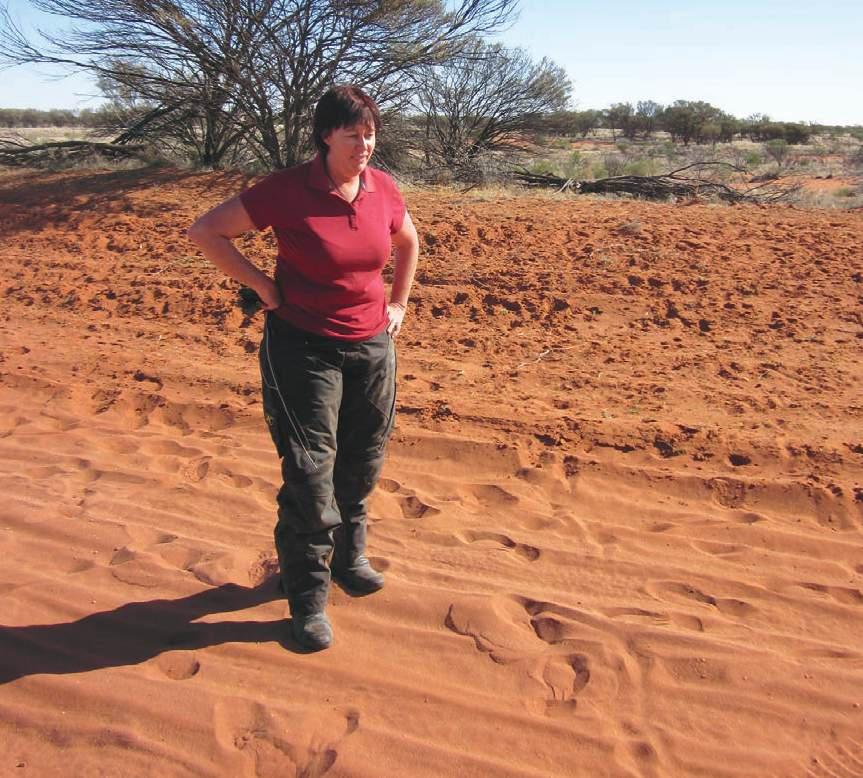
Adventure riding takes you places a lot of people will never see.
satisfaction. It’s stimulating, exciting, and very addictive.
And so it was I went from euphoria to panic as I lay on that same red sandy track I introduced this column with, in pain and unable to breathe. As a mother, I was terrified by the thought of not seeing my kids and that my husband, who was up in front, had no idea what had just happened. Fast forward a few months, the bike was written off and I had the opportunity to get a new bike that would specifically suit me for adventure riding. But that’s a whole other story. For the whole other story of how Karen came off her bike on that red sandy track, see ‘Cameron Corner Caper’ on page 66 of this issue.

v The likelihood of meeting Ewan McGregor on an adventure ride is fairly slim, so the fact the application of sunscreen attracts dirt through every air vent in my helmet and gives me the look of someone who has spent the day ploughing a burnt paddock doesn’t really matter. Apply sunscreen liberally and leave the makeup at home.
v No-one notices helmet hair when they’re too busy looking at how dirty your face is.
v Whenever I leave my teenage kids at home while I’m away for a ride, I make sure I lock up the alcohol and firearms.
I’ve found it never hurts to make a polite call to the police through the night and lodge a noise complaint against the home address so they’ll check up on the kids.
v Mechanical knowledge is not a prerequisite for riding. Having said that, making an effort to learn some basics will put you a step above car drivers who call roadside assistance for a flat tyre.
v Having a good attitude will turn any situation into an adventure
v Riding beats housework. Always.
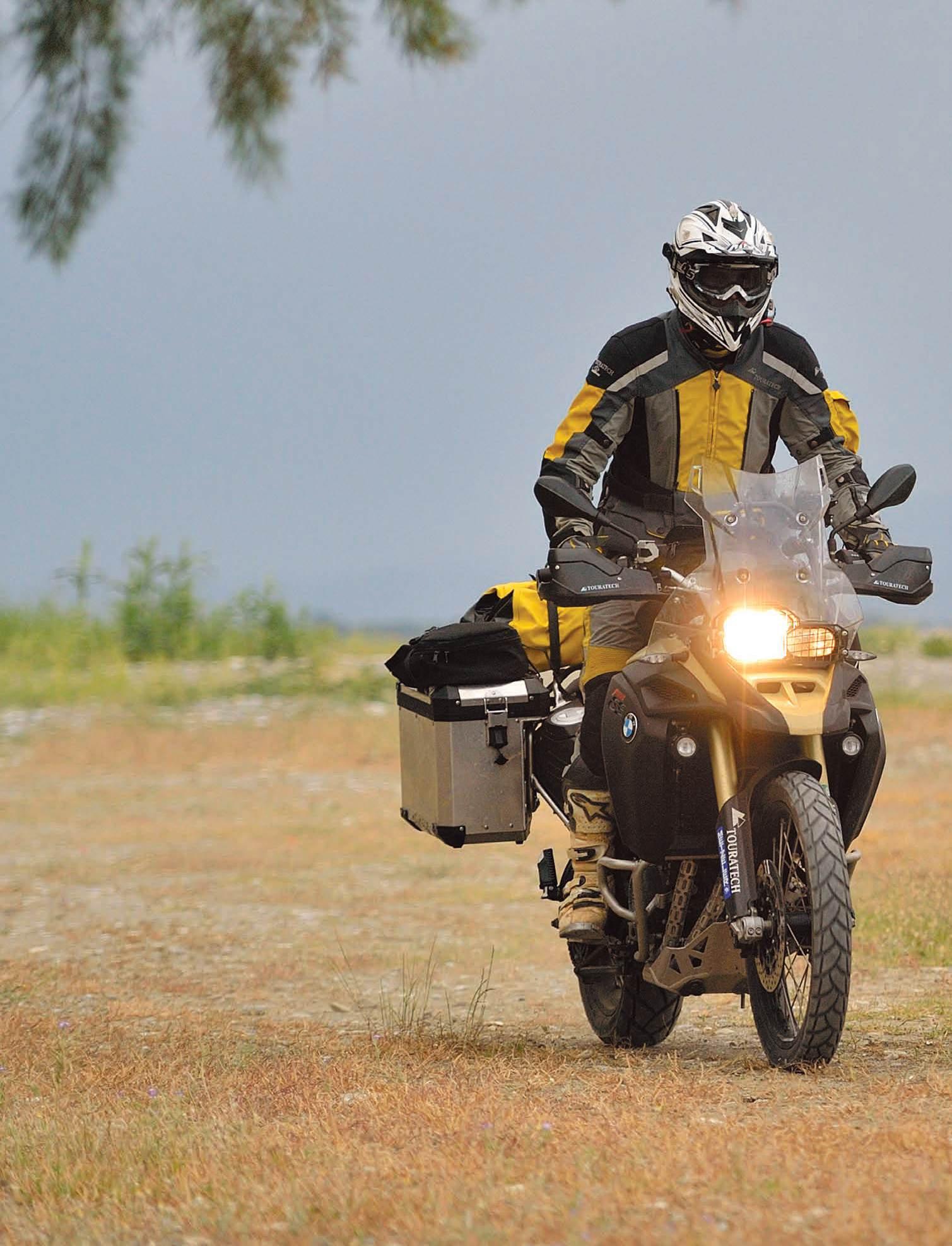
Imagine you’ve taken an extended holiday and are finally taking that long-awaited trip around Australia. Now imagine Casey Stoner. He’s a MotoGP World Champion – the best in the world –and probably capable of riding any bike, anywhere. But give him an adventure bike for a week or a month riding in Australia’s outback and he may not know what to pack, how to pack it, or what he needs to take to make the trip successful. It’s a scenario common not just to Casey Stoner or the ’round Australia traveller. Everyone needs to start somewhere, and while there are lots of books and magazines about adventure four-wheel driving and caravanning, it’s not so easy to find information on adventure motorcycling. Until now.
Over the coming issues of Adventure Rider Magazine, this ‘Packing for Adventure’ series will aim to assist you in your adventure travel planning and packing.
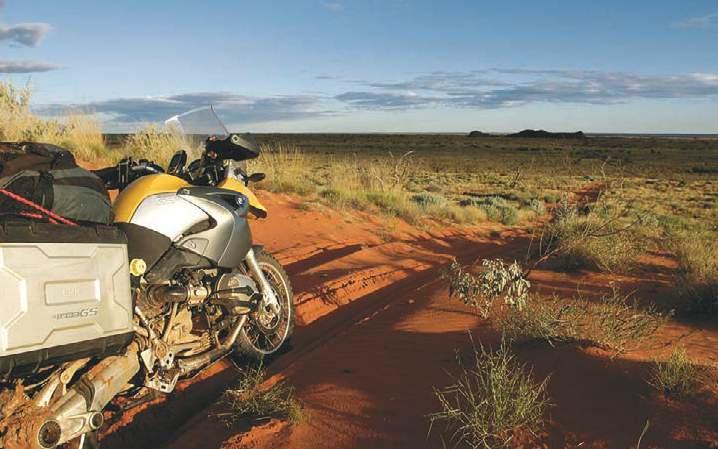
Main: The way a bike is packed and the apparel chosen can make a huge difference to the enjoyment of a ride. It can even make the difference between finishing a ride or DNFing.
Left: Hard or soft panniers? Either will suit best depending on the situation. We’ll talk more about that in future issues.

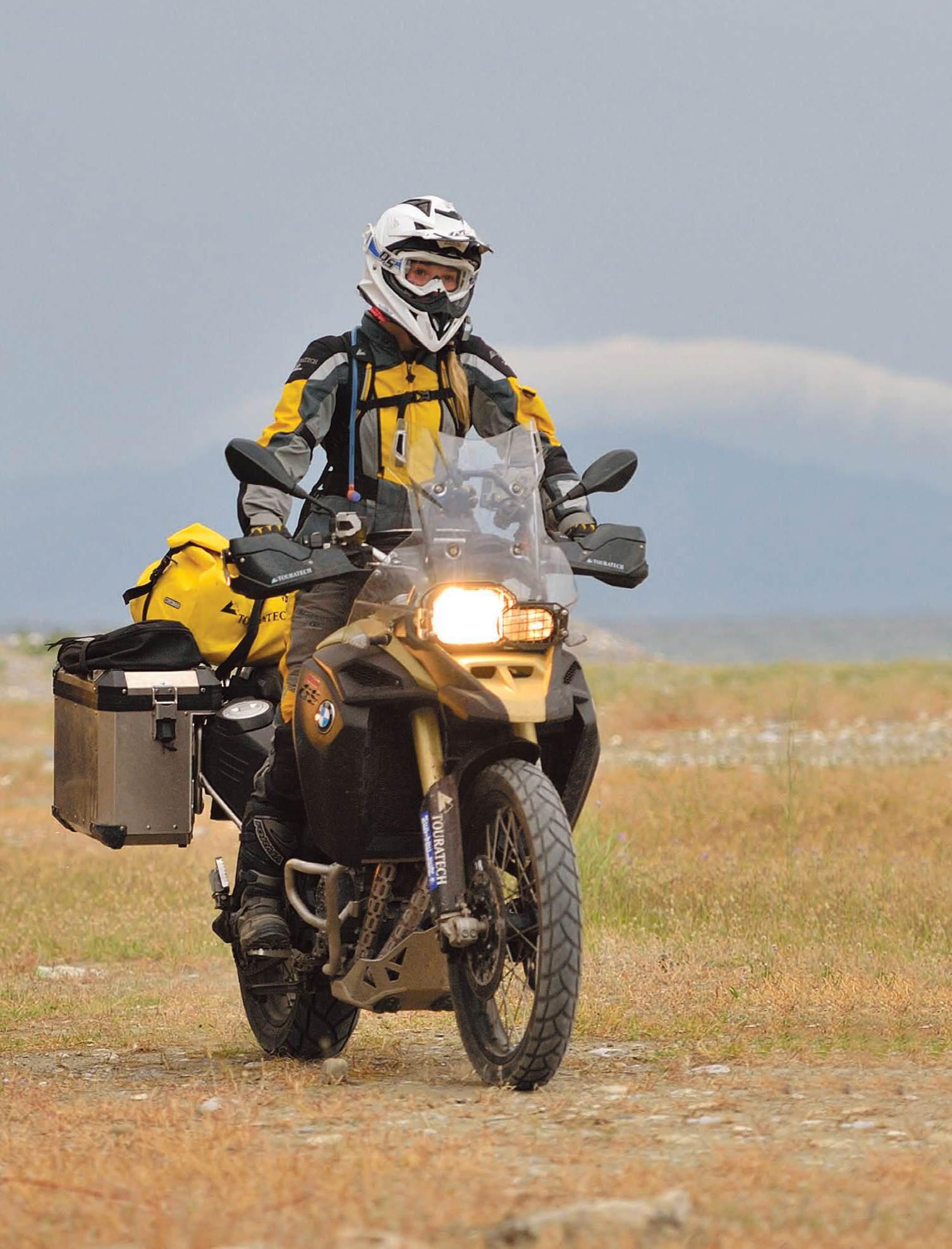
It’s true that we can always learn something new, so our articles will cover all levels of experience and expertise – from those new to adventure riding right through to the hardened traveller.
Not all types of adventures are the same. A lap around Australia on good roads, for example, is a totally different type of adventure to riding through the red centre on rough tracks and trails, and after years of adventure travel in Australia, the USA, Europe and South Africa, we’ve learnt from our mistakes. While we’re still learning, our planning and preparation has become easier.
Asking questions and seeking advice relevant to your particular type of adventure can save you time and money, and get you on the road faster and with more confidence.
In these articles Australia’s Touratech crew will share our tips and tricks on making your adventure travel smoother, safer, and most importantly, ensuring you pack the right gear for your needs.
The last thing you need to be doing is carrying stuff you don’t require. That takes up too much space and increases the weight of your bike on a long trip. Our hints in this column in future issues will help you make the right choices from the beginning. The range of topics we’ll cover will include luggage types (for example, hard panniers and soft luggage), clothing, types of accommodation (tents, pubs, lodges), emergency requirements, tools and spare parts, cooking equipment, GPS and maps, camera equipment, communication, and bike protection. And that’s just the things we’ve thought of so far. As we head along the journey with Adventure Rider Magazine and you readers, we hope you’ll tell us what kinds of information you need. u
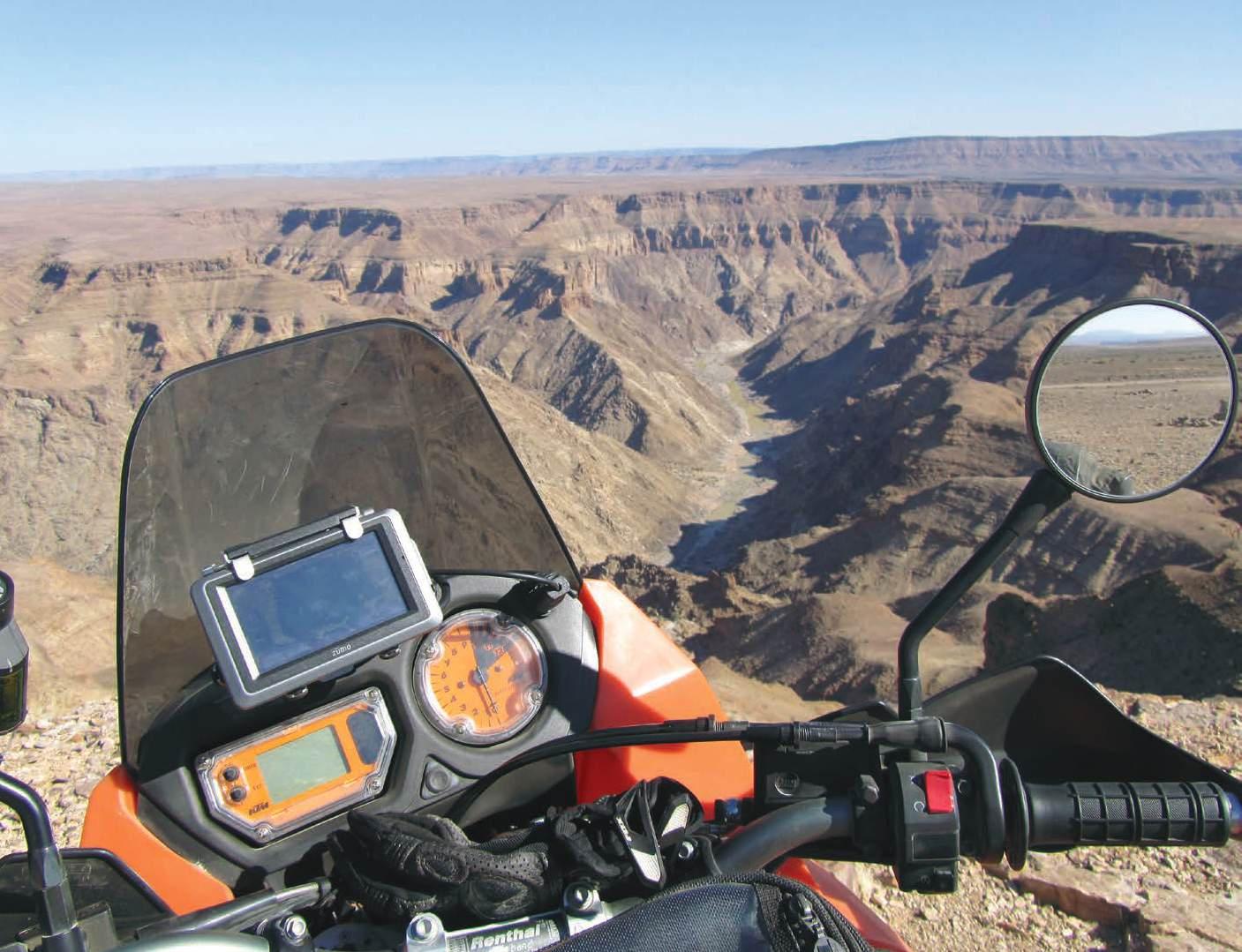
Beginning next issue, we’ll start our series by looking at luggage options, and in particular, the much-discussed ‘hard luggage versus soft luggage’ debate. Both have their place in adventure riding. Hard luggage
offers you convenience, ease of packing, more security and is definitely easier to live out of, but can be a risk to the rider in a crash in harsh riding conditions.
Soft luggage, on the other hand, is smaller and certainly impedes rider movement a lot less. It’s
Packing the bare minimum is the go. Keep the weight and bulk as small as possible.
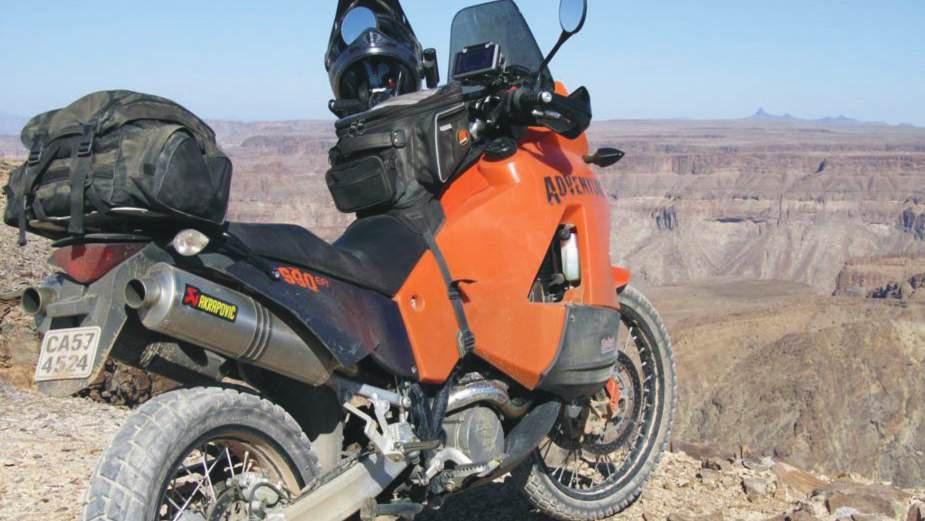
It would be good to pack a basejumping parachute if you know you’re heading for situations like this one.
easier to ride with if you’re going off-road and can put less stress on your bike’s sub-frame, but conversely, doesn’t offer security on long trips.
But more on that in the next issue. Until then, get on your bike and keep riding!

Touratech was born out of the desire for adventure, researching, making and testing motorcycle accessories for the serious rider. Touratech Australia has helped thousands of adventure riders reach their travelling goals, and has also lent support to hardcore adventurers such as Phil Hodgens, and long-distance travellers like Simon and Lisa Thomas (www.2ridetheworld.com), and Sherri-Jo Wilkins (www.sherrijowilkins.com).
Like you, our passion is adventure riding. We dream it, we plan it, we do it!
Tom Foster
Tom Foster
Call:
Call:
(02) 8355 6842
(02) 8355 6842
0481 349 034
0481 349 034
tom@advridermag.com.au www.advridermag.com.au
tom@advridermag.com.au www.advridermag.com.au

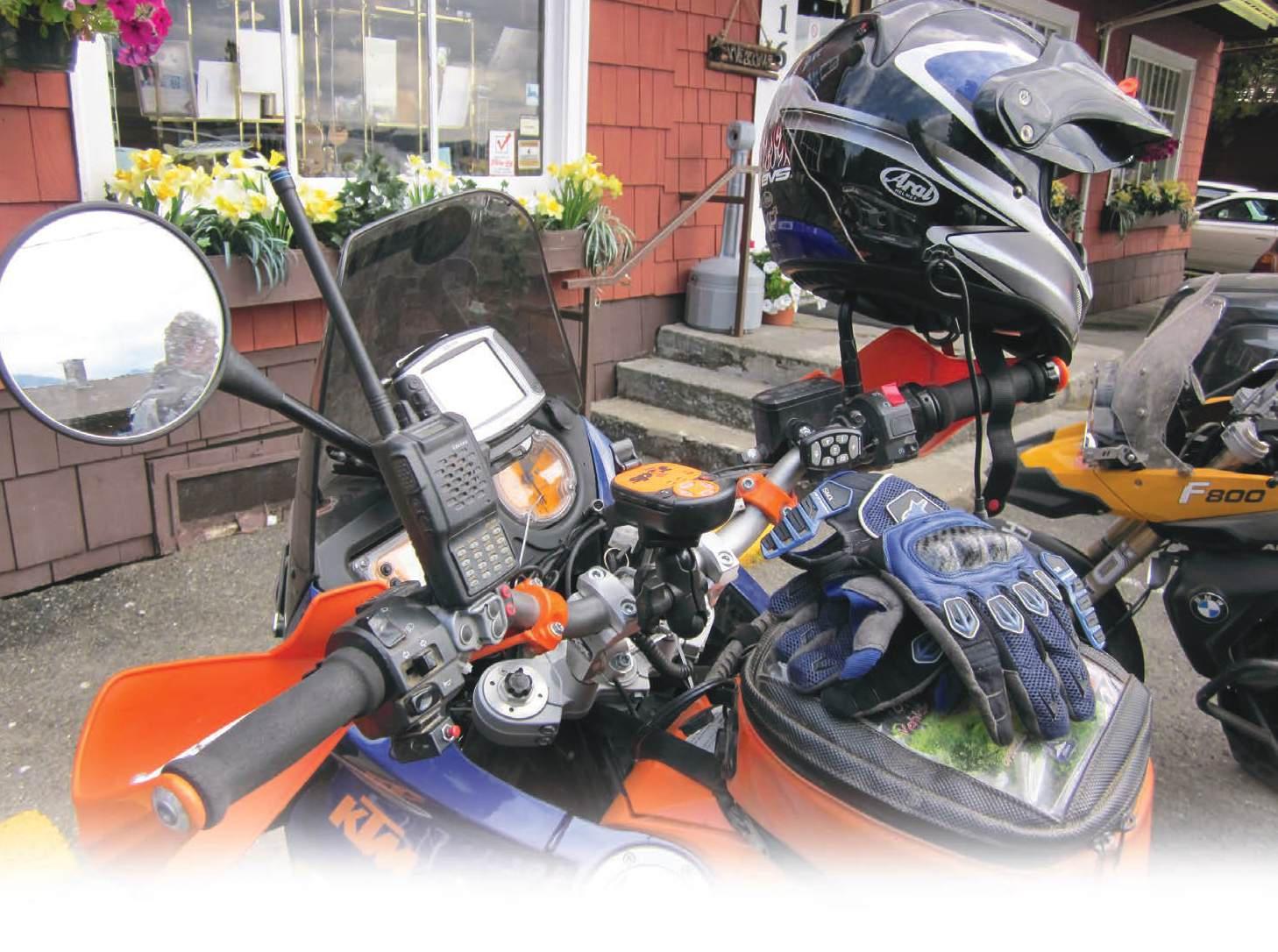
Being able to communicate with other people and other riders is far more than a convenience. It’s a serious safety issue. There’s some very high-tech equipment available, but it’s not difficult to find what you need.
When you’re travelling big distances with one or more other riders it makes sense to be able to contact each other while you’re riding. It’s not a social issue – although a chat can make a long ride far more pleasant – it’s a big safety concern as well. On a dirt-road or desert ride bikes might be spaced a kilometre apart to allow the dust to settle between riders. Even a small
group can end up strung out over several kilometres, and the sweep rider can be left high and dry for a very long time before the group realises he’s in a ditch somewhere or struggling with some kind of bike failure. Going back the other way, the lead rider may well find a very dangerous situation and need to let those behind him know before they fall victim, one after the other. There’s also the need to be able
to get help. That’s something where no-one wants to be caught short.
Let’s have a look at few possibilities…
Very few adventure riders would be unaware of the SPOT personal tracker and the EPIRB – more correctly, the PLB (Personal Locator Beacon). An EPIRB (Emergency Position-Indicating Radio Beacon) is specifically a marine-spec locator. It’ll do the same job, but EPIRBs tend to be larger than PLBs.
A distress beacon should be in every adventure rider’s kit, or at least one in every group. They signal distress using a satellite network, so they have far greater coverage than a mobile phone, and if someone’s hurt badly enough to need to set off an emergency distress signal, they may not be physically able to use a phone.
The SPOT is popular because it has a number of handy functions, u


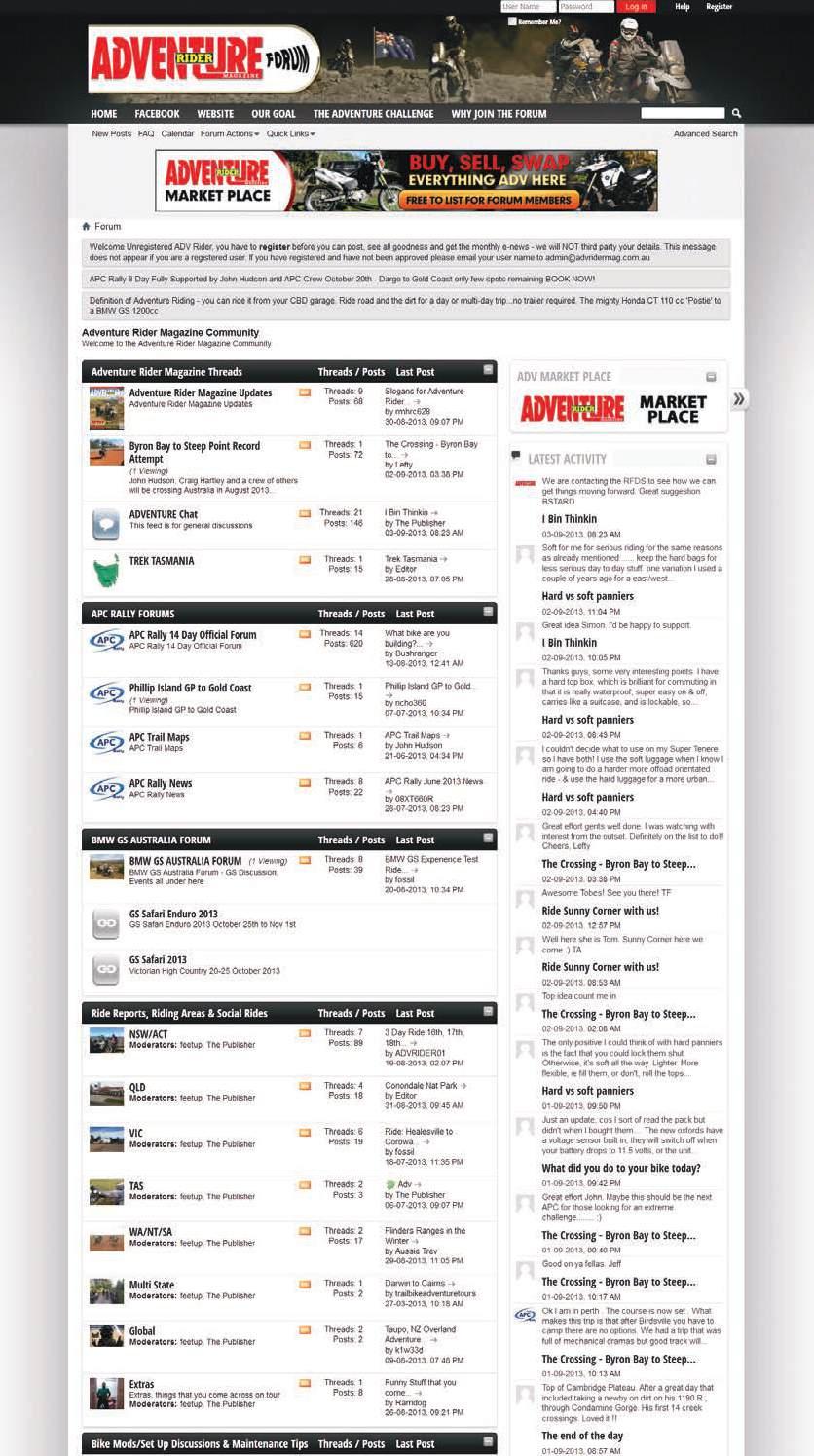

like sending an “Okay” message to programmed phone numbers and e-mail addresses and allowing anyone with access to the Web to track a rider’s path and position. The SPOT is a subscription service, though. The subscriber has to buy the unit then pay an annual fee to keep it operating.
The PLB has only one function, and that’s to send a distress signal and notify emergency services of the beacon’s position. Once the PLB is purchased there’s no ongoing fees. Battery life is around five to seven years, and that’s all there is to it. Hit the button anywhere in the world and someone will start looking for that beacon.
In both cases the owner needs to register their beacon, and buyers need to be aware that a unit bought from overseas will have its country of origin encoded into its signal.
Just between us
Probably the most interesting area of communications for riders is being able to talk to other riders, or for the rider to be able to speak to the pillion without having to slow down and shout, and this is where the blue-ribbon gear really gets interesting.
In years past there have been a lot of good communication systems, but they relied on a cable from the rider’s helmet to some kind of control centre on the bike. Now there’s Bluetooth, and that’s changed everything.

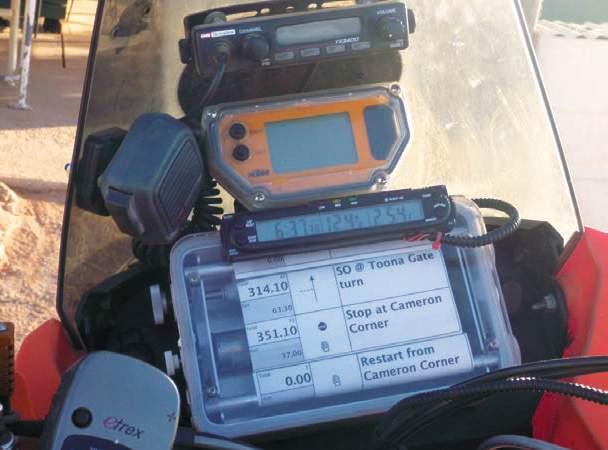
There are still very good cable set-ups available, but once you’ve tried a wireless set-up you’ll never go back. Of course, the luxury of being wireless means you’ll pay more, but prices are dropping fast as technology surges ahead, and right now there are some great Bluetooth options at prices that would’ve been impossible a few years ago.
For communication between rider and pillion it’s hard to beat a straight
Bluetooth rig. A small send-andreceive unit sticks on the side of each helmet with a mic and earpiece between the shell and liner, the units ‘pair’ – the Bluetooth word for recognising each other and connecting – and that’s all there is to it. Rider and pillion can chatter away to their heart’s content. It’s a very inexpensive, wireless, and generally rechargeable outfit.
For riders who tend to stay not too far from each other, the same setup will work. In fact, technology has advanced so far that we’ve seen one Bluetooth rig claiming 700m, line-ofsight connectivity. That’s awesome. No fuss or fiddling about selecting
frequencies. Just pair up and prattle on.
Radio star
Once there’s a Bluetooth dongle on the side of a rider’s helmet, a huge world of connectivity opens up. He can Bluetooth to his phone, GPS, iPod or even to a UHF radio, and that’s good news for adventure riders. A mobile phone is great, but it means dialling out or answering a call, having a phone up on the ’bars where it’s open to crash damage and weather, and it’s for contacting one person at a time. Riders love UHF because it means they can monitor all kinds of chatter, and with one touch of a PTT (push to talk) button they can get their message out to an unlimited number of people. Anyone on the same channel within range will get the message. There’s no licence necessary and no ongoing fees to pay, and the radios themselves are relatively inexpensive. There are waterproof models available, and different power outputs, and there’s often
excellent information available just by listening to local traffic.
There’s a few specific bike-comm rigs offering Bluetooth connectivity, and that’s a clincher. Until recently riders have tried to come up with ways of bodgying mics in their helmets or draping the attached radio mic over their shoulders, hanging by a curly cord, but now it can all be done with a very neat, efficient wireless package.
We went looking for someone who could give us sensible and expert advice on bike comms, and we ran into Ross and Steve at Adventure Cams. We thought they’d be all about helmet cams, and they are, but they’re totally switched on when it comes to bike comms as well, and as SENA importers and distributors, they were busting to tell us all about the latest gear from the leading edge in bike-communication technology.
“Adventure bike riding offers so many experiences, why not share it by communicating with others on the ride?”
Any competent installer of comms gear should be able to help you to a sensible choice of the equipment that will suit your needs. The big tip we have for you here is to work out what you want, then ask for it. If you want music, GPS and phone, and that’s all, say so. Do you want noise-cancelling (you’re a mug if you don’t)? Do you need to integrate speakers
into custom-formed earplugs? Open-face or full-face helmet?
Do you have specific power-draw limitations? Is it important the system is waterproof?
Work out those kinds of things, get them straight in your head, then find yourself a competent tech/retail outlet and tell them what you need. Get that bit of communication right and communication from then on will be easy.
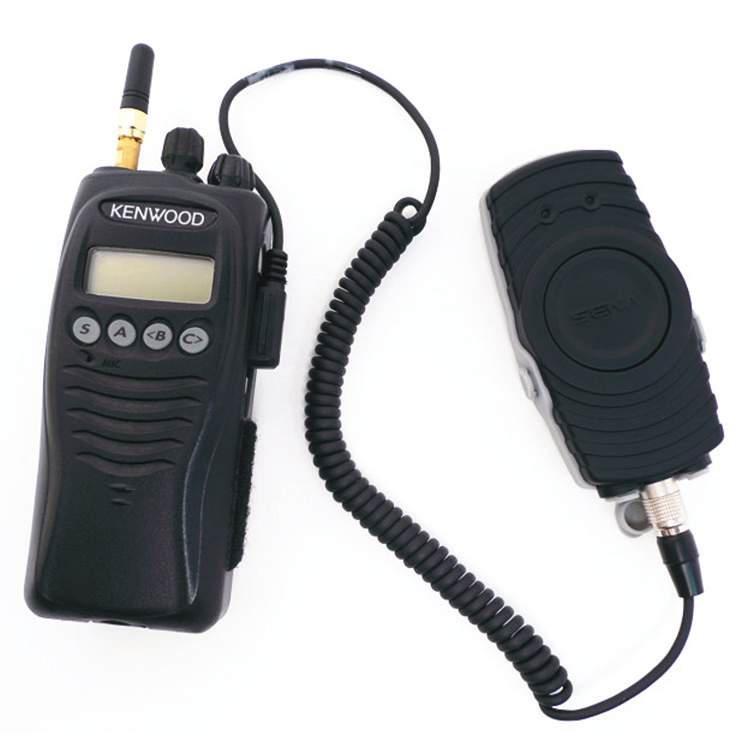
frequencied Steve Cooney, his eyes shining. “Having used SENA (SMH10 and SR10) on a recent Canning Stock Route ride, the benefit of being able to communicate with everyone, including those annoying fourwheel drives coming over the hills, was invaluable. This gear will remain part of my kit. Over,” he transmitted enthusiastically.
Breaking the silence has never been easier thanks to the SENA Bluetooth range of communication solutions. Get Ross and Steve to
assist you with the right system from UHF connectivity to a simple Bluetooth intercom system, and get the equipment you need for the job you want done. SENA’s range offers simplicity with seamless functionality via the unique Jog Dial system designed by riders for riders.
“If you haven’t experienced the benefits of Bluetooth, such as
stereo music and GPS connectivity, now is the time,” transmitted Ross Palmer. “With systems available from as little as $129, isn’t it time you broke the silence on your next ride?”
We’re convinced. Contact Adventure Cams, the Australian Distributor for SENA Bluetooth to discuss your needs. The guys offer free, friendly support –including a two-year warranty on all products –and have retailers throughout Australia. Give them a call on 1300 115 007, or log on to
www.adventurecamshq.com.au

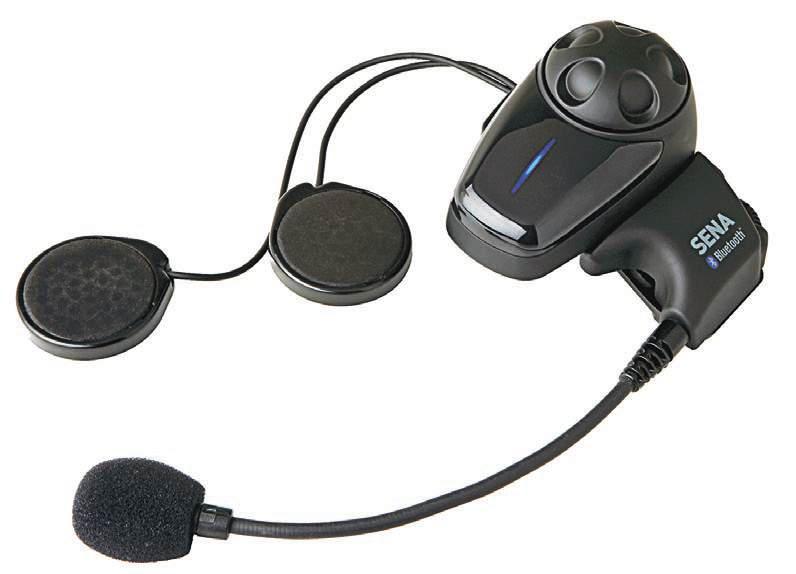
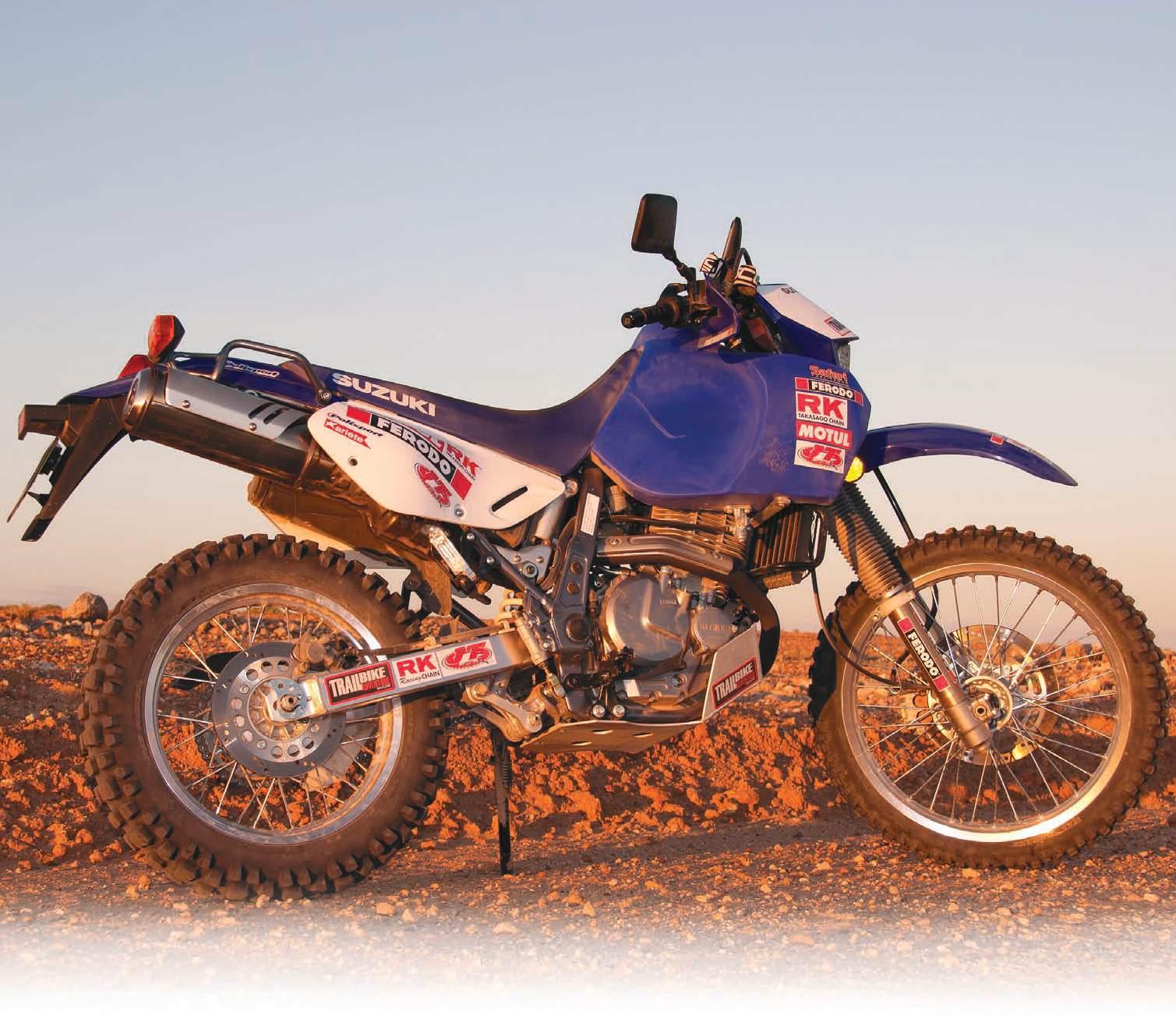
The venerable DR650 is still the first choice for many riders when it comes to a rock-solid reliable, affordable and capable adventure bike. We grabbed hold of Inverell’s Vince Strang, Australia’s undisputed DR guru, and asked him to give us 20 points of interest about the bike he knows inside and out.
“The DR650 is very versatile,” idled Vince in his calm and unhurried manner, “and there’s many ways it can be made to suit you, your style of riding, your budget and many other things.
“These points are just my opinion,” he air-cooled, as we remembered how he campaigned DR650s in the Australian Safari in decades past. We also had a look at Vince’s own bike and thought, “Phwoar!”
So here’s what a man who builds, races and rides the workhorse Suzuki has to say…
1. The front end loves a wider front tyre. If you ride trails and outback roads on your journeys, a 90/100x21 is the good size, and my choice is a Dunlop D745 or Michelin HP4.
2. I use a 130/80x17 Dunlop D606, or for longer life a Heidenau Scout, 130/80x17 to match that front for the same type of riding.
3. Run lots of pressure in your tyres! Use speed to get up the sandhills. Pressure somewhere
between 18psi and 24psi helps to prevent impact punctures. You should only use lower pressures in the mud.
4. The bottom shock mount has two positions for the bottom shock bolt. The design allows for two seat heights, either 885mm or 845mm. If you choose the lower setting for the shock, drop the triple clamps around 15mm on the fork legs so you don’t end up with the bike sagging at the rear.

5. The 17-inch rear wheel is a good choice as the tyre has a bigger ‘bag’ and can absorb impacts better than an 18-inch tyre, so you’ll get less punctures. Tyre choice was a bit limited for 17-inch rears a few years ago, but there’s plenty of good rubber available in that size now.
6. You can use the heavy-duty 18-inch Bridgestone Ultra MX tubes in the 17-inch rear. Trelleborg used to market the rear tube in a 17-18-19-inch, one-tube-fits-all, and it was a good tube.
7. Use a lightweight rim lock in the rear (the Talon billet rim lock is strong and light). The front will be okay without a rim lock. Lightweight rim locks make it possible to balance the wheels, and I strongly recommend balancing.
8. Fit a 44-tooth rear sprocket. The DR loves it. You’ll get less chain rattle, better first- and second-gear performance on the trails, better throttle response between 90kph and 110kph, and slightly more top speed. The original 15-tooth front and the super 525 chain fitted at the factory are top quality and will often go more than 20,000km. Fitting a 14-tooth front to achieve this same gearing is a false economy. The tighter circle the chain has to turn causes greater wear.
9. Run the chain at the right tension (the right tension often looks very loose) or risk ripping the top roller off the frame. Be very careful if you fit a 16-tooth front sprocket, too.
10. Don’t you dare cut the airbox up! If you want your DR to be easy to live with, and you’re sticking with the original carby and cam, leave the airbox alone. Cut it up and the fuel consumption is sure to drop from between 18-22 kilometres per litre to 16 kilometres per litre. Or worse.
11. The screws holding the carby float bowl are notorious for being difficult. Changing them to Allen screws the first time you have to remove the bowl is the go.
12. The current DR650SE series was first released in Australia in 1996 and placed third outright in the Australian Safari with Holden valve springs in the forks. In 1997, Australian enduro champion Mike Shearer rode a DR in the Safari and won 11 of the 22 special stages.
13. An older DR650 will sometimes “squawk” in the starter when starting. There’s a bush in the housing that causes this, and the smart move is to replace the stock end cap with a flash billet end cap and bearing (available from VSM of course). It’s a fairly straightforward job if you’re handy with tools. If you’re not confident, VSM can fit it for you as well.
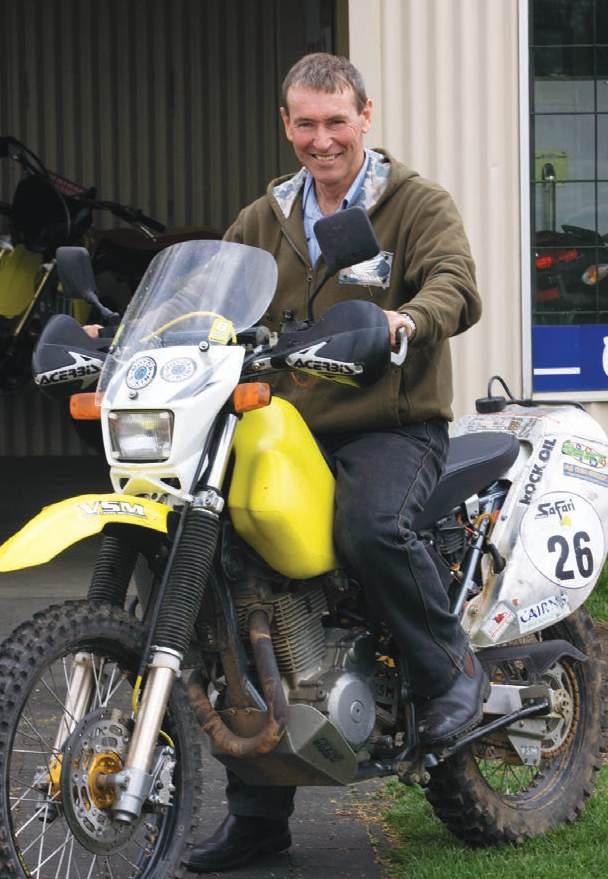
14. The standard exhaust system is often replaced. However, it’s sometimes better than the unit that replaces it. The standard pipe is extra quiet (that’s good), extra heavy (not so good), and fairly fat (not so good), but it has decent power.
If you must replace the system, VSM has had years of success with the Staintune. It’s not too loud, it’s light, slim, made in Australia and it’ll last as long as the DR.
15. DR650 valve clearance is: inlet 0.1mm, exhaust 0.2mm –give or take a thou either way –and must be measured cold. Valve clearances should be checked at the first service and the factory suggests they be checked each 12,000km after. Lots of them are never checked.
16. The fuel inlet spigot on the DR carby has a tiny filter inside. Pull the fuel line off carefully and if you see a tiny white ring sitting on top of the pipe, that’s the filter. Pull it out and use an inline filter instead, because the small stocker can block with a single drop of water.
17. Don’t fan the clutch when things get tough. Use torque and momentum to get up hills. The DR clutch will last for years unless you get bogged, panic, and slip the clutch like a supercrosser on a 125. Once you do that it’ll be gone in a flash.
18. Make sure you keep around three millimetres of free play in the clutch lever so there’s no drag. The clutch slipping will damage the plates very quickly.
19. My favourite thing about the DR650? They’re easy to live with! The DR is very reliable, pretty much does anything you ask of it (allowing for her size), you don’t have to learn any special technique to ride it and you won’t have to spend a lot of money to make it suit your style.
20. My least liked thing? The seat. It’ll make you squirm and wriggle after 300km. Fortunately, it’s easy to replace or modify. It needs to be flatter and wider at the rear where you do most of your sitting.

Have a look at this lot! Hoo-aah!
Engineer Andy Powell decided a KTM690 was the right bike for him, but it needed to be kitted out for adventure. Here’s what he ended up with. It’s damn near a work of art.
“I’d attempted the APC Rally on a 990 the previous year,” verniered Andy,” and decided my ability didn’t match the bike’s performance. A crash on Day One left me with a chipped ankle and a mortally wounded KTM, so I decided to look for a lighter bike. I looked at the stats for the DR650, Triumph Tiger 800 and BMW F800GS, and the 690 was the bike that came out with the best power-to-weight ratio.
“On top of that, the Rally Raid kit was available, and that made the change from enduro bike to adventure bike much easier.”
Andy reckons he’s not a great rider, but being an engineer means he often ends up being the “fix it” man in any group, and it’s a role he enjoys. A lot of the considerable load he carries is because he enjoys solving problems on bikes – his or anyone else’s. And as Andy points out, everything on the list is “skinnied” as best he can. He doesn’t carry a full roll of tape, just a length of tape wrapped around some hose or electrical conduit, and wherever possible he favours tools with more than one function.
Andy explained the aim of the build was to end up with a bike that was ready for “any ride, anywhere, any time,” and his only decision is whether or not to strap on a tent. Awesome.
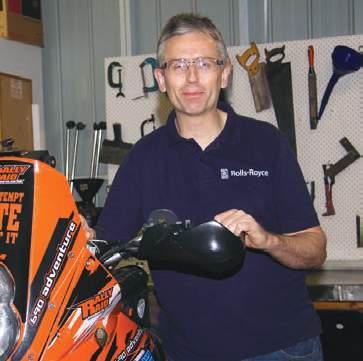

3B&B alloy rear rack (only the $50 base plate. Andy used the base and came up with his own idea).
Fuel tank kit – natural
Rally engine bashplate
3Underground Machine LLC risers and Scotts damper. The damper requires a 10mm longer link arm due to the Rally Raid fairing mount pushing the ignition switch back
3Chinese LED indicators from eBay
3LED flasher relay
3Ballards heated grips
3Ballards sintered bronze inline fuel filter for the Rally Raid tanks
3Gates submersible fuel hose to eradicate the in-tank filter
3Can-am 10-micron-rated fuel filter (replaces the


in-tank filter but is mounted externally)
3All fuel-hose clamps replaced with EFI-rated Triton hose clamps so they can be disconnected in the bush
318mm hose support clamps to mount the tool tubes
3Highway Dirt Bikes billet top clamp for mounting the map holder
3Seat modified for comfort by John Moorhouse of Capalaba, Qld
3Homemade case savers
3Homemade rear-disc saver
3LED lights and homemade stone protectors
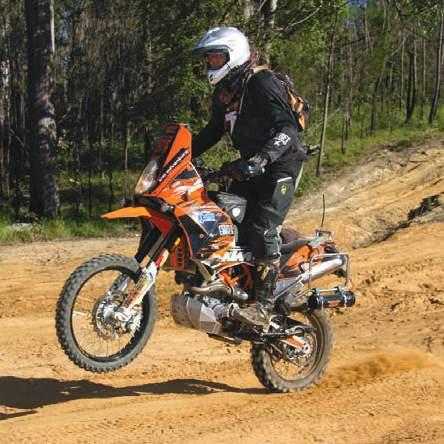
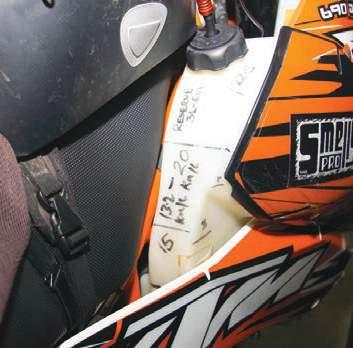
3Uniden UHF five-watt
Radio UH078 with remote tuned aerial
3Maps holder (maps and bungees)
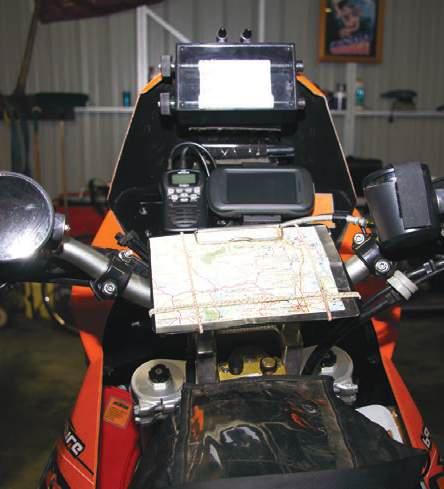
312v car-type power outlet
3Marker pen (to make route notes on the roll-chart)
3Face flannel (wipe visor on the move, refresh on stops, etc)
Front left fairing
3Old rear brake pads
3Jumper leads
3Starcom Comms unit and Bluetooth module
Right tool tube
3Sparkplug
3Araldite
3QuickSteel
3Aluminium tape
3Fabric tape
3Stainless-steel wire
3Solder
3Chain links
3Repair tape
3Scotchbrite pad
3Tie wraps
3Starcom Comms set up with Bluetooth adapter
3Uniden five-watt UH078 with remotetuned aerial
3Fastaway footpegs Helmet
3Cat Eye headlight
3Starcom Combo Headset – speakers and jack for earbuds with Comply foams
3Extended peak (for outback setting sun) Bike cockpit
3Roll chart holder
3Garmin Montana GPS
3Spare clutch lever Front right fairing 321-inch tube 3Spare brake lever Tankbag 3Sunscreen 3Spare fuses 3Valve tool 3Cycle Pump tyre inflator 3Tube repair kit 3Rag 3Mini WD40 3Tyre pressure gauge 3Mini detergent (for washing and tyre changes)
3Mini insect repellent 3Isopropyl alcohol 3Spare fuel pump
3Chain lube 3Para cord Left tool tube 3Toolkit 3Spare bolts and nuts
3Chain breaker
3Fuel filter
3Ballards control cable repair kit
3Pack of old oil seals from the last oil change
3Mr Funnel (Fuel/water filter)
3Padlock and cable (to secure the helmet)
3Superglue Under the seat
3Fuel poly piping – for transferring fuel
Rear tool tube
3Tyre levers
3Hacksaw blade
3Extension tube for ratchet handle
Pannier rack stowage
3Ratchet strap (used for repair/tie down/ emergency towing)

v 30-litre capacity
v Increases riding range to between 600km and 700km
v Tank retains the look and feel of the Husqvarna Terra
v Incorporates the original styling of the Terra
v Appearance ergonomics meet Safari Tanks’ high standards
v Testing now completed (photo shows a pre-production model)
RRP: $650
Available from: Safari Tanks
Web: www.safaritanks.com.au

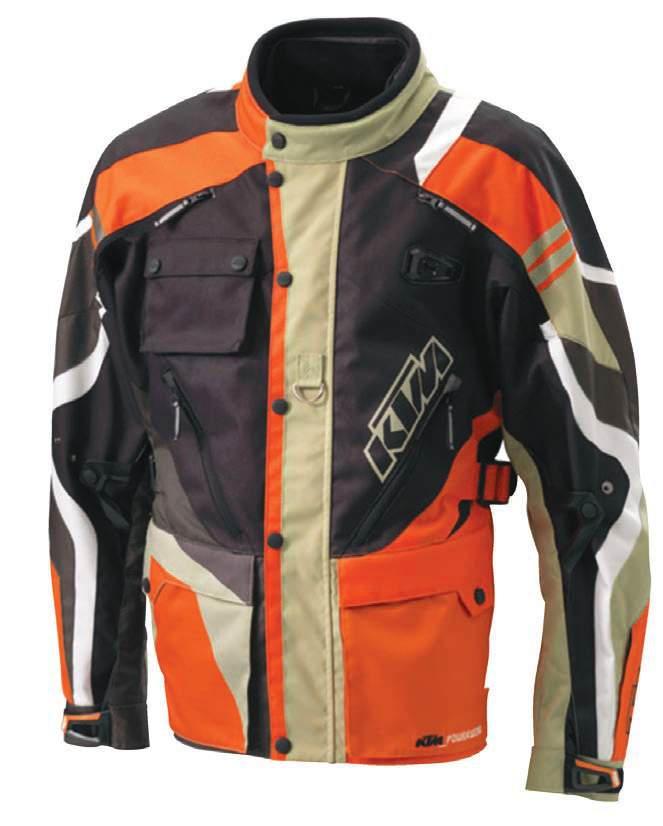
v Sizes S-XXXL
v Integrated and removable CE shoulder protectors
v The world’s best GPS mounting systems
v Protect your navigation system in all conditions
v Mounts to any bike
v Robust and durable
v An anti-vibration system that is second to none
v Lockable mounts also available
v Designed to fit Garmin, TomTom and Magellan GPS units
v Choice of cross-bar, handlebar or RAM mounting
v Laser-cut, anodised aluminium parts, manufactured using CNC technology, provides stability and precision.
RRP: From $187
Available from: Touratech Australia
Web: www.touratech.com.au
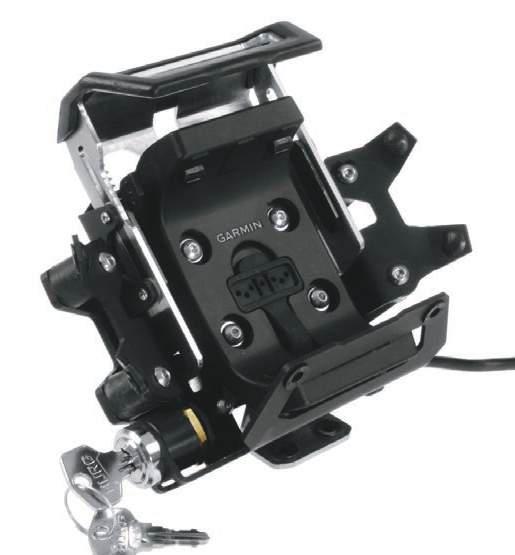
v Feed-through tube for drink system
v Integrated and removable CE elbow protectors
v Plenty of zip pockets
v Two waterproof inside document pockets
v Removable microfibre fleece inner jacket
v Highly elastic Lycra cuffs with Velcro fasteners
v Preformed sleeves
v Effective ventilation system, adjustable with zips
v Waterproof high-quality membrane with taped seams
v Soft inner collar with fine adjustment
RRP: $429.99
Available from: KTM dealers
Distributed by: KTM Australia Web: www.ktm.com.au

v MotoPressor weight 570gm
v 63cm inflator hose with hands-free, lock-down delivery valve that fits all bikes
v 2.65-metre SAE fused power cord
v Two adaptors – direct connect for your battery and alligator clips, both with SAE connectors
v Sports needle for blowing up footballs
v Two nozzles for inflating air beds
v Heavy-duty neoprene storage bag
RRP: $49.95
Available from: Rocky Creek Designs Web: www.rockycreekdesigns.com.au
www.youtube.com/watch?v=0-R6Eydjb7Y
, , ,
The folks at Teknik Motorsport have been raging on Ténéré suspension upgrades over the last few months, culminating in building two bikes for Yamaha Australia. Now they’re offering a special deal.
v Wheel your bike into Teknik for the full treatment: fork and shock springs, shock valving and fork V4s valves (our version of an Emulator) for $800. That’s $400 off their regular retail price!
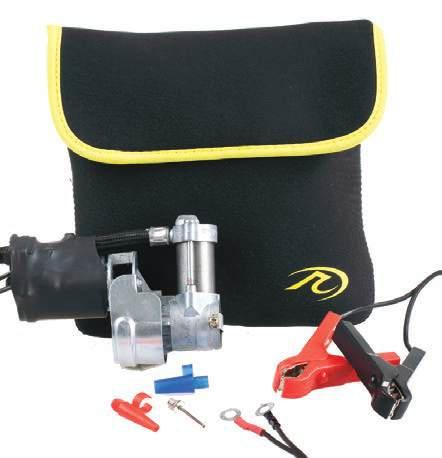
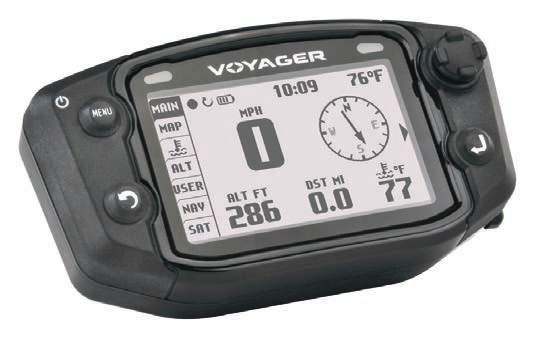
v GPS speed, distance, compass, altitude, temperature, maps view
v Organise, edit and share entire trail systems in 3D
RRP: $800
Available from: Teknik Motorsport Web: www.teknikmotorsport.com.au

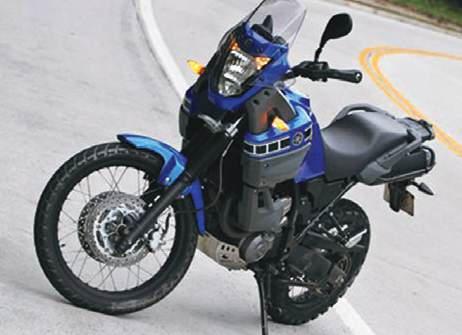
v BMW F800GS bashplate to suit 2008 to current models
v Also available for this model: luggage plate $90, and radiator guard (2008 to 2012 only) $180
v Designed, manufactured, and distributed from B&B’s Ballarat factory in Victoria
v Built using the best commercially available alloys in Australia
v Stainless-steel fixings wherever possible and the finest TIG welding
v B&B products have been used by leading riders, teams and privateers
RRP: $265
Available from: B&B Off Road
Manufactured by: B&B Off Road Web: www.bboffroad.com.au
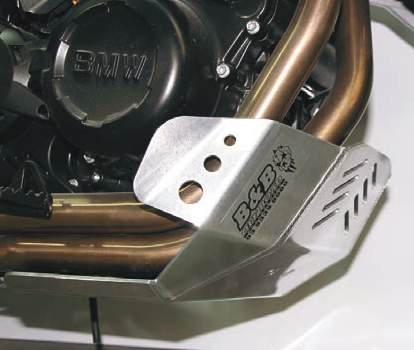
v Designed specifically to meet the needs of off-road riders
v 40x400 WQVGA LCD – read able in intense sunlight
v Engine performance linked to GPS data
v Crash resistant, off-road design
v Upload routes from any GPS
v Customisable user screens
v Model-specific and generic integration available
v Accurate tracks, even in the toughest terrain
v Runs on bike power (or internal battery)
v Back-lit for operation in the dark
RRP: $329.95
Available from: MX1 Australia
Web: www.mx1australia.com.au
www.youtube.com/ watch?v=9YKI-l6xw0U

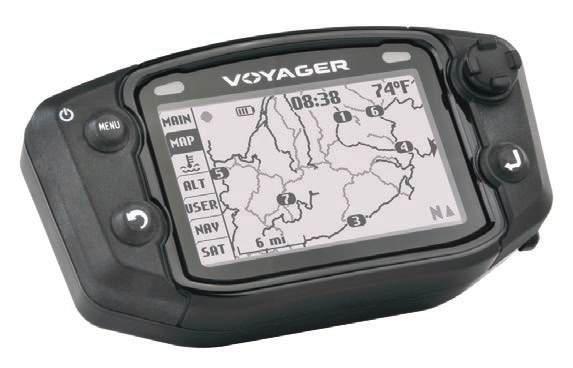
At26, North-Brisbane Aircraft
Reliability Officer James Powell is a bloke who doesn’t mind a challenge.
Q: Hi James. What’s your injury?
A: I am classified as a T10 Paraplegic, meaning I’m paralysed from the belly button down due to severe spinal chord damage sustained in a road bike accident four years ago.
Q: What made you choose to ride a quad? Why not drive speedway cars or maybe karts?
A: I’ve only ever known and ridden


motorcycles my whole life. A quad bike seemed the only logical alternative to give me the same freedom and experience, still allowing me to be part of the biker community. After having my accident on the road, I felt returning to the dirt was the best and safest option.
Q: What obstacles did you find when you decided to ride the quad?
A: I did a lot of research into what type of quad would suit my mobility issues. I needed something that could handle all types of terrain: dirt, mud, roads and sand. It’s not
like I can get off and walk if I get into trouble.
As the quad bike doesn’t have ADR-compliance, special registration is required. Due to the registration guidelines I require landowner and police permits for every ride. This makes going for a ride a mission in itself.
Q: Tell us about the Can-Am. What mods have you done to it? That motor purrs like a kitten – a tiger kitten, maybe, because it sounds awesome.
A: I’d say the majority of the bike is stock. I’ve built a rear rack for my


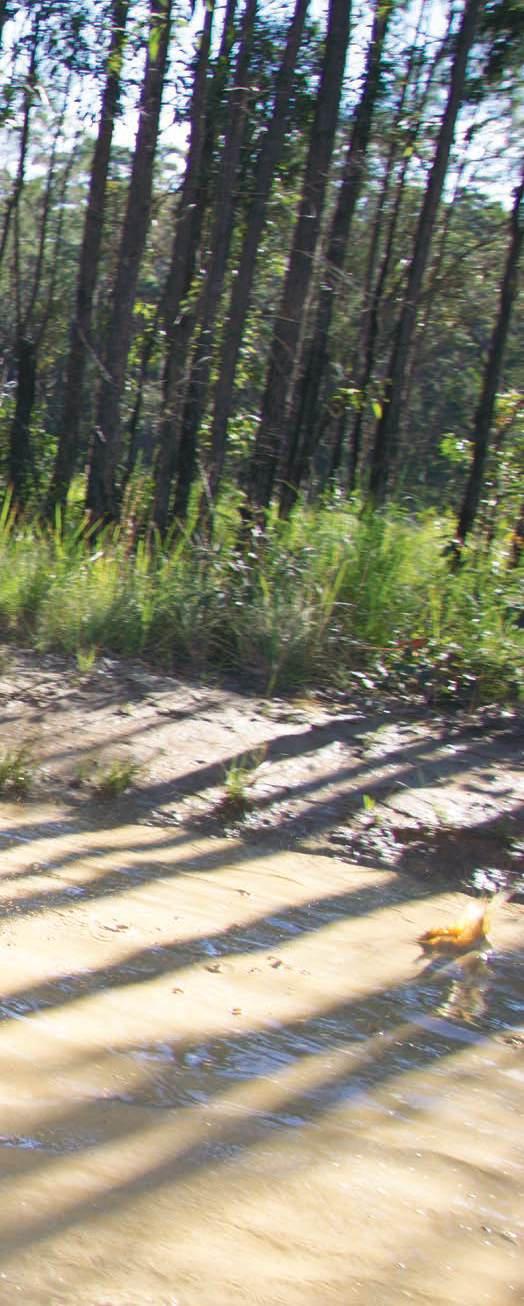
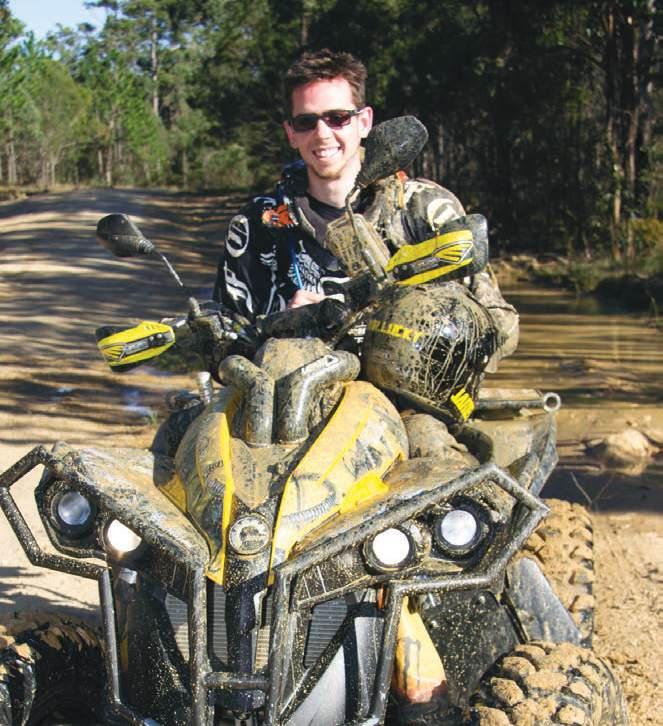
off unassisted, and you sure didn’t need any help with opening the throttle. Are you self-sufficient on the quad?
A: It’s taken a long time, with a bit of trial and error, to get to the point I’m at now.
I’d say I’m very self-sufficient, with my upper body strength from bodybuilding making things easier. The only time my mobility really stops me is when I hit a steep hill. It’s just because I can’t stand up to lean my weight over the front. But (laughs) I normally just throw someone on the front to keep the front down, and everything’s okay then. For anyone that knows me, I’m very stubborn and like to be completely independent. So I’ve built the quad with that in mind.

Left: That must be why he fitted the snorkel kit.
Top: James Powell. Chasing adventure on a Can-Am quad.
Above: It’s the freedom James enjoys most.
wheelchair, and mounts to hold my feet on. I’ve also widened the wheelbase by about 50mm to increase stability. Also, as the CVT had a low outlet for cooling, I built a snorkel kit so deep-water crossings would never be an issue. Then I dressed it up with a decal kit to give it a great look.
Q: We watched you put the Can-Am on the trailer yourself and get on and
Q: What riding have you done so far? I’ve done everything from suburban towns through to highways and rural areas. Basically everything you’ve done on a motorbike, I’ve done on the quad…except the Bruce Highway, I guess.
I did a Spinal Injuries charity ride the other week. It was all road from Helensvale to Mount Tamborine. That was great. It was really good for the cause.
Q: What’s been your favourite ride so far?
A: They’re all so different. Every time I get out on the bike is great. I wouldn’t say I have a favourite ride; it’s just being able to get out and be free, because it’s so
hard for me to do that.
Q: What’s your next big goal?
A: I’m in the process of speaking to my local member. He’s just sent away information to the Commissioner Of Police for community safety. I’d like to get the quad registered so I could have more freedom. I don’t know how they’d do that, but I’d just like to be able to go out and ride my bike without organising it a month in advance.
Q: What about a long-term goal? Are there any rides or events you’d particularly like to tackle?
A: I would say maybe the Finke Desert Race or the APC Rally. I believe these are a lot further down the track, as I’m still having trouble riding locally. I believe being one of the very few people to perform an achievement like this would be great. These test even the greatest of able-bodied riders.
Q: Who’s been really helpful so far, getting you on the quad and getting you riding?
A: I found my Dad, Andrew, and wife Megan, have been the greatest support for me. With the battles I’ve had to face I’ve simply wanted to give up sometimes. It’s been a huge effort to get as far as I have, and they’ve been awesome.
Quad bikes don’t have a great reputation due to farms overloading and people not wearing the correct protective gear, and I’ve found it very hard to find helpful people when asking for permission for a permit. This has required me to fight to be heard on many levels. Due to my disability too, I find people don’t like accepting liability.
Even though there are a lot of unhelpful people, I’ve met some very great authoritative personnel, which has made my life, and being able to ride, easy.
You’re obviously getting through to some people, James, and that’s great to see.

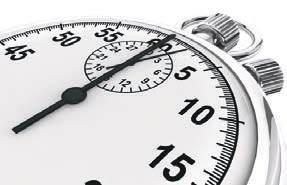

By Craig ‘Tarlo’ Tarlington

Adventure Rider spends 10 minutes with Rod Faggotter discussing the Dakar Rally and his future.
The Dakar Rally requires a rare mix of skills and speed is by no means the greatest –navigation, endurance and maintenance are also critical. Of the many Australians who competed and performed impressively, Rod Faggotter was clearly the best, finishing as the highest-placing Aussie. The achievement is all the more impressive considering he rode as a privateer, up against the world’s best factory riders sporting big teams and bigger budgets.
Q: The last few years have been busy and, by all accounts, very successful. What have been the highlights of your journey so far?
A: Getting to the Dakar was a distant dream, one I didn’t give too much credit to achieving, so getting there twice and getting the great result this year is pretty surreal. The problem is I want more!
Q: What were the things that really challenged you?
A: Definitely finance: trying to raise the dollars needed to get to the race.
Q: If you could change anything in the last few years, what would it be?
A: Nothing, it’s been a great experience.
Q: Is a day in the Dakar tougher than any day in any race we have in Australia, and if so, why?
A: Not necessarily tougher riding,


but every long day at Dakar is followed by many, many more. It’s so wearing!
Q: What was the biggest surprise you had when you first went to the Dakar?
A: The spectator support in the middle of nowhere! And also, just how slow many of the Euro guys are – particularly in the fast stuff.
Q: What did you learn from doing Dakar in 2012 and how did that help you in 2013?
A: It helped mostly in two areas. It gave me confidence going into the race – a lot of stuff was not new to me, so I had a good idea what the organisers would throw at us. It also helped me understand there is a lot of hype surrounding the race and it’s important to not let it affect you.
Q: Obviously, sponsorship is important to get you to a race. How difficult is it to get support in Australia? Has it improved since your great finish in this year’s Dakar?
A: It’s very hard to raise that sort of support in Australia for just one race. The offers of support have increased and it’s something I’m working hard to pull together at the moment.
Q: What sort of budget do you need to get there?
A: You need a minimum of $70-80 thousand if you are willing to sleep in the bulldust at every bivouac, but you’d need to add another $20 thousand to do it in a little more of a civilised manner.
Q: How did you get your start in racing?
A: I grew up on the family cattle and sheep station and rode bikes all my life. I only started racing motocross when I was 19 or so and got pretty serious with it in my early 20s…until I had my family and started my business when I was 26. It went a little quiet for a few years there. Then I started into desert racing, just into my 30s.
Q: Being a family man, how do your commitments to racing
affect your family, and how do you, your wife and kids cope?
A: It’s a stretch, for sure. I try and make the time leading up to events as quality as possible around my family. The good thing about modern technology is, even at Dakar, I could just ring on the mobile or sat-phone and keep in touch every day.
Q: Are there things you would like to see change in the sport in Australia to help get more riders ready and able to go to the Dakar?
A: Maybe not changes in the sport, but more ‘navigation style’ events would help, as would making the Safari longer and tougher. We are lucky enough to have many desert races in Australia that are accessible and feature types of terrain similar to those at Dakar. Many of the good riders are more than capable of running at the front – this was obvious after seeing the Australians’ results in this year’s Dakar. There’s no doubt we’re disadvantaged by financial challenges and the lack of support in getting there; there’s a lot more support for the European riders, mainly due to the Dakar being a European thing. It would be great to have one of the mining companies, for example, use their Christmas fund to support half-a-dozen Australian riders on a two- or three-year deal.
Q: The Dakar is the main rally of the year but there is a World Championship each year. If you could, would you like to compete in these races? What would it take to get you there?
A: Time and money, for sure. But I’m so stretched now just doing half-a-dozen events a year, so it would also mean a shift in focus. It’d be the ultimate though: to race the world rounds and lead into Dakar on a factory team.
Q: Are you thinking about going again?
A: Definitely! As long as I can get the funding, I’ll be back to see if I can improve on my results from this year.
Visit Rod’s Facebook page, www.facebook.com/ RodsDakarRally, for cool photos, updates on his progress and the opportunity to contribute to his sponsorship fund.


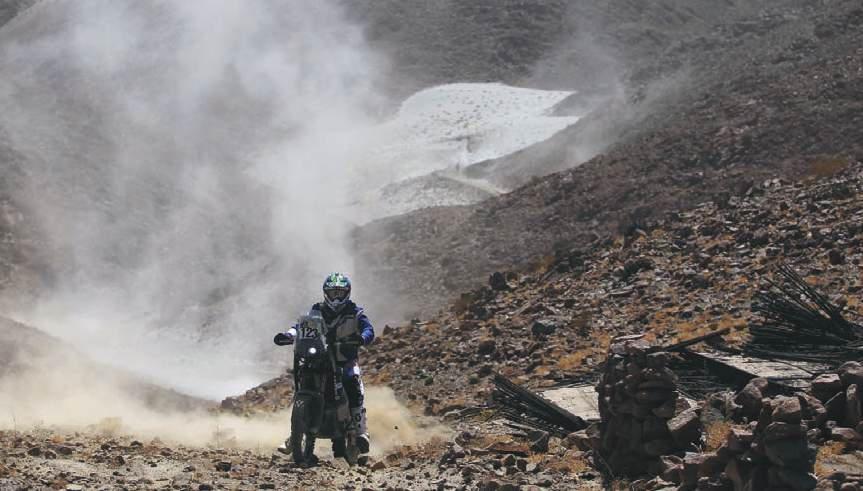

On sale December 2013
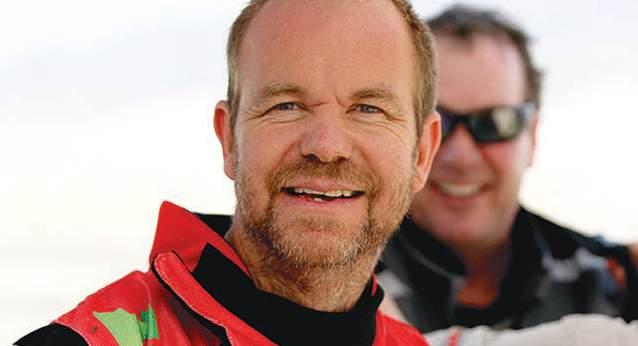

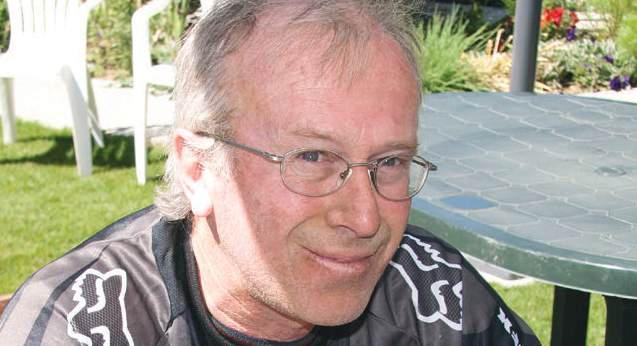
v Christmas gifts for adventure riders
v More adventure bike reviews
v What to look for in an aftermarket pipe
v 20 things you should know about the KLR650 AND MORE!

